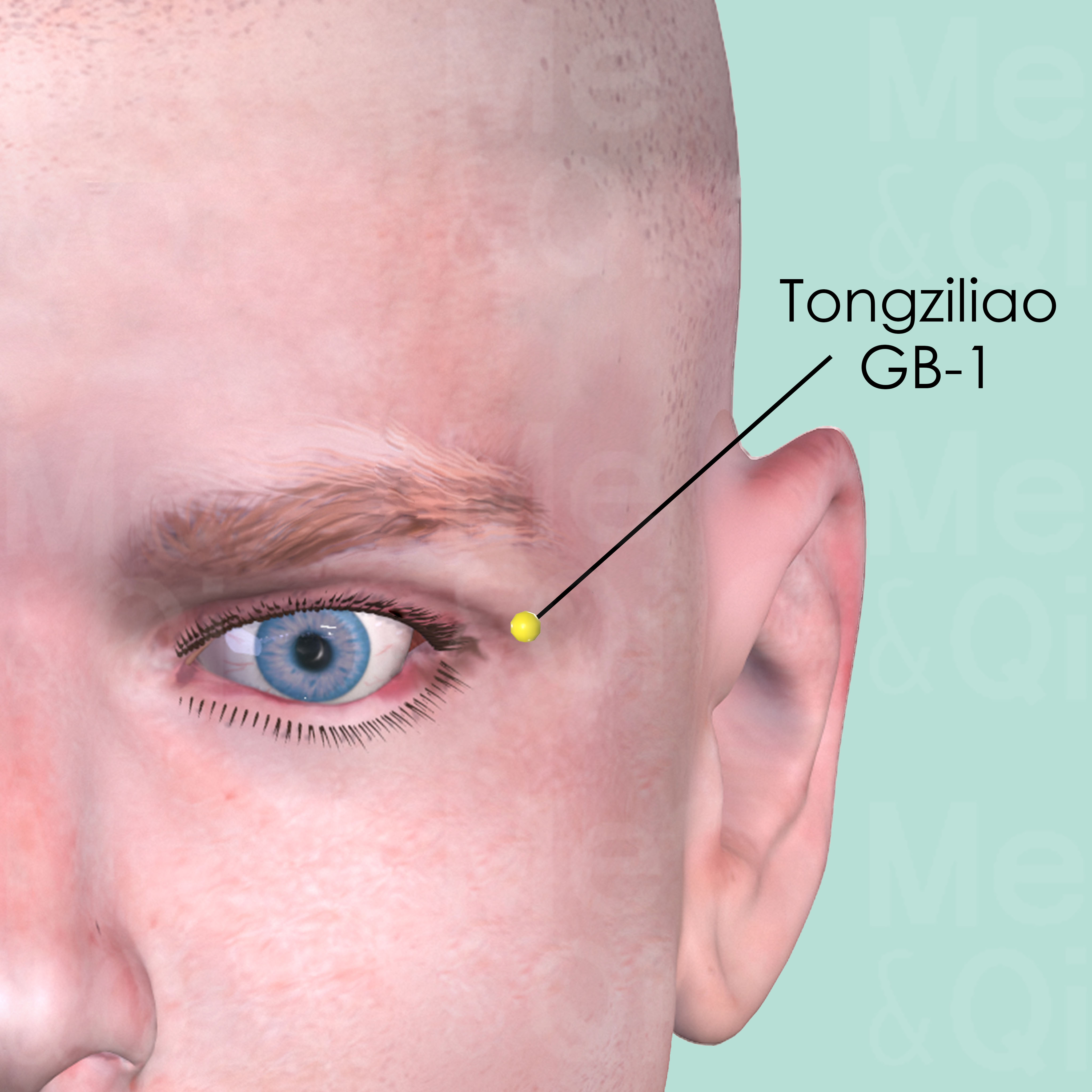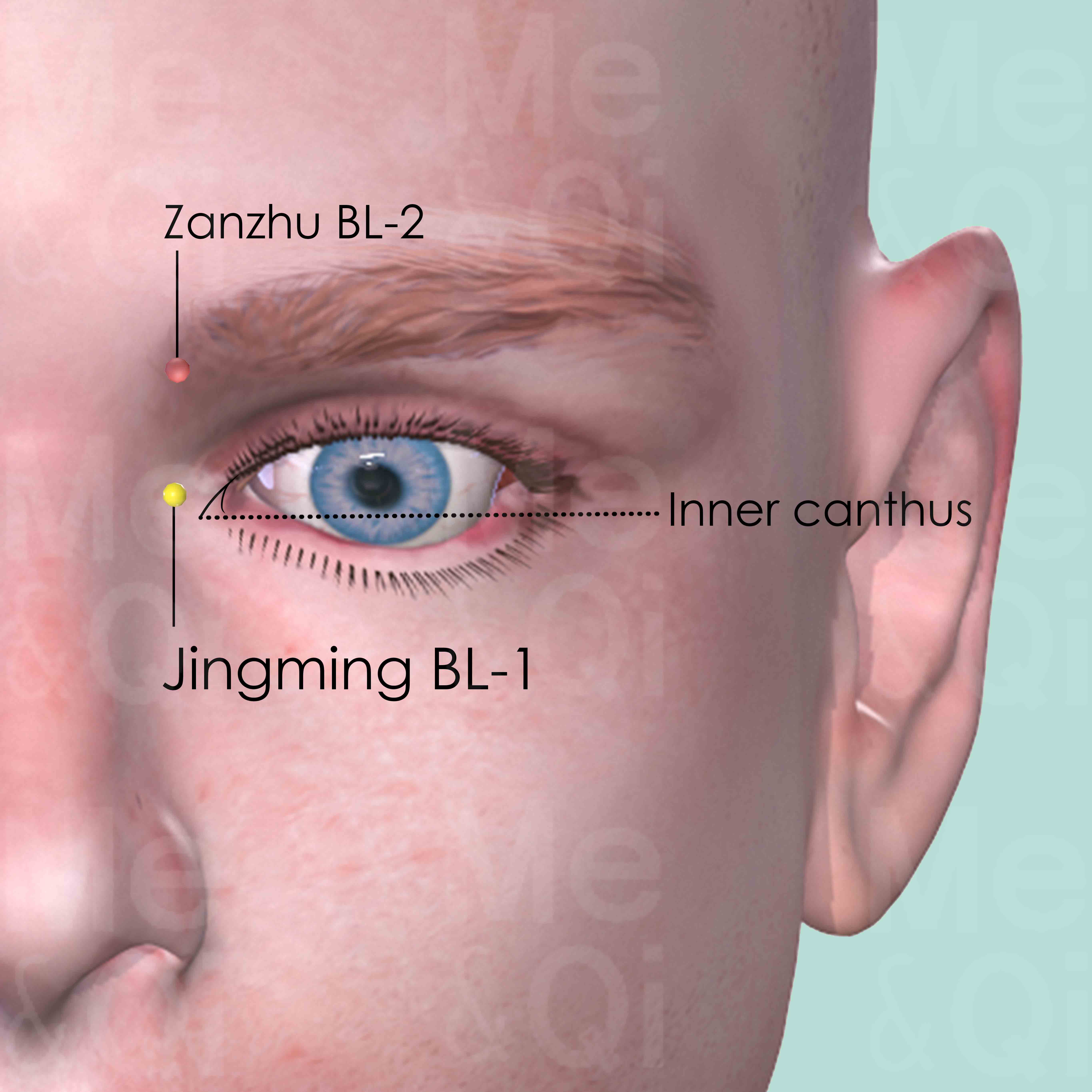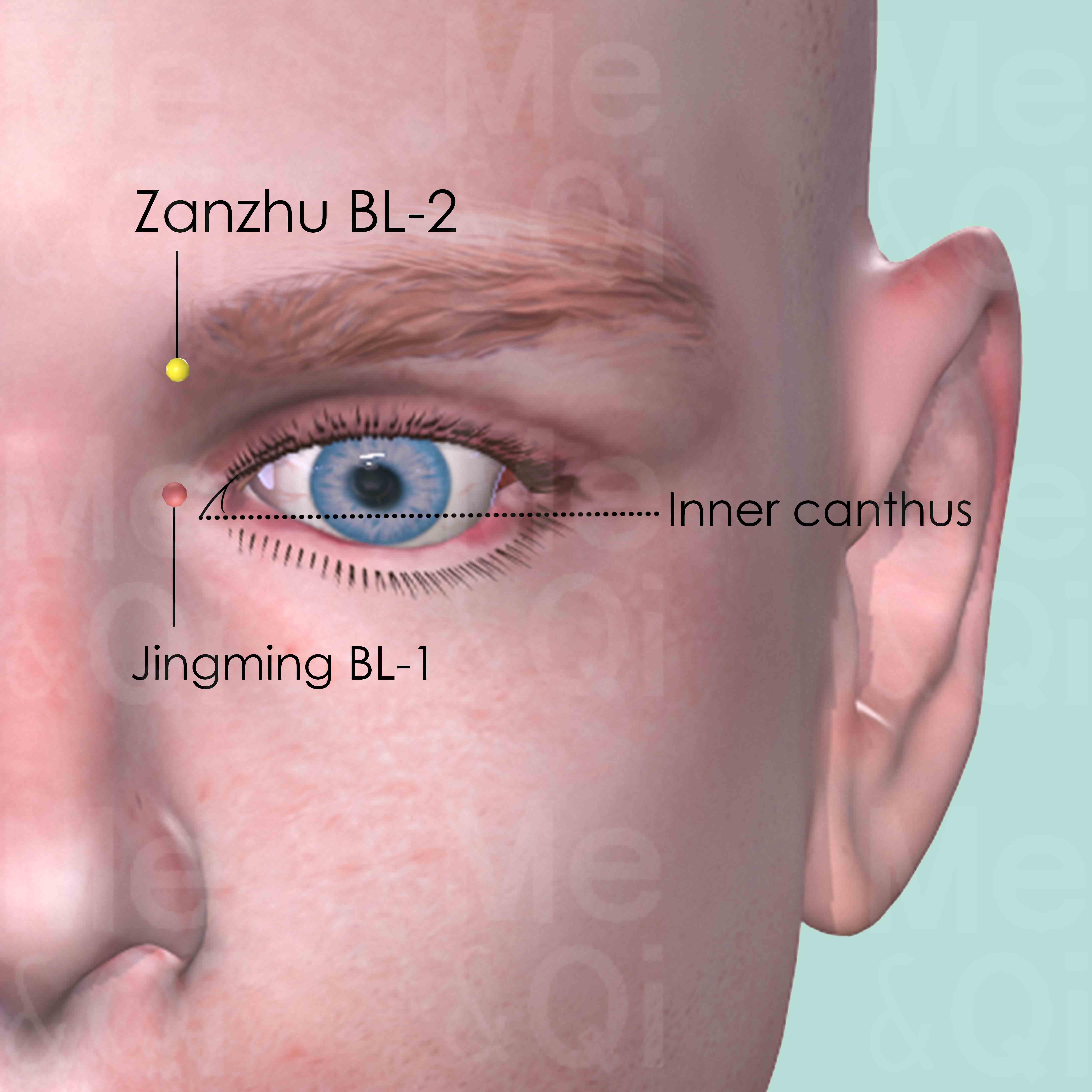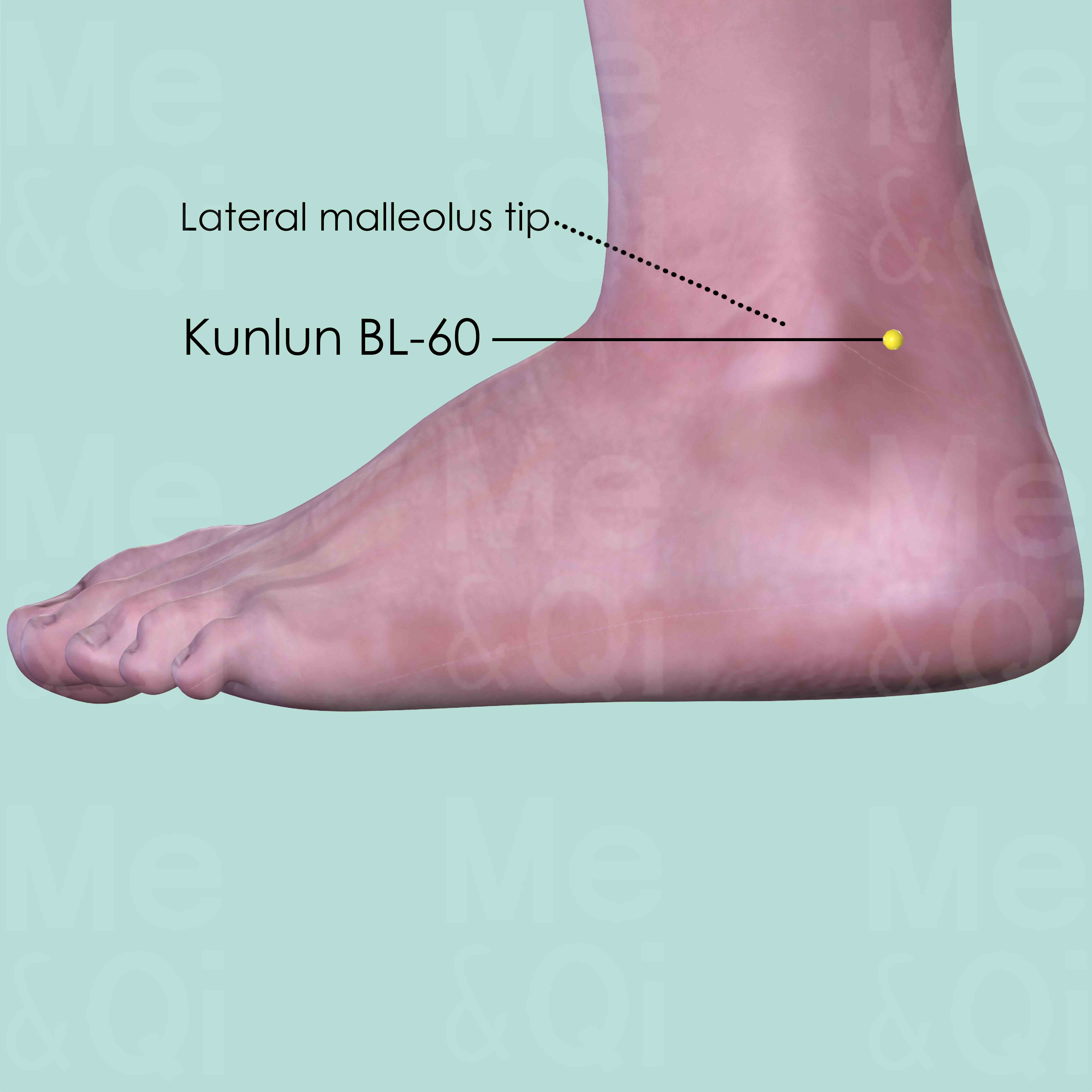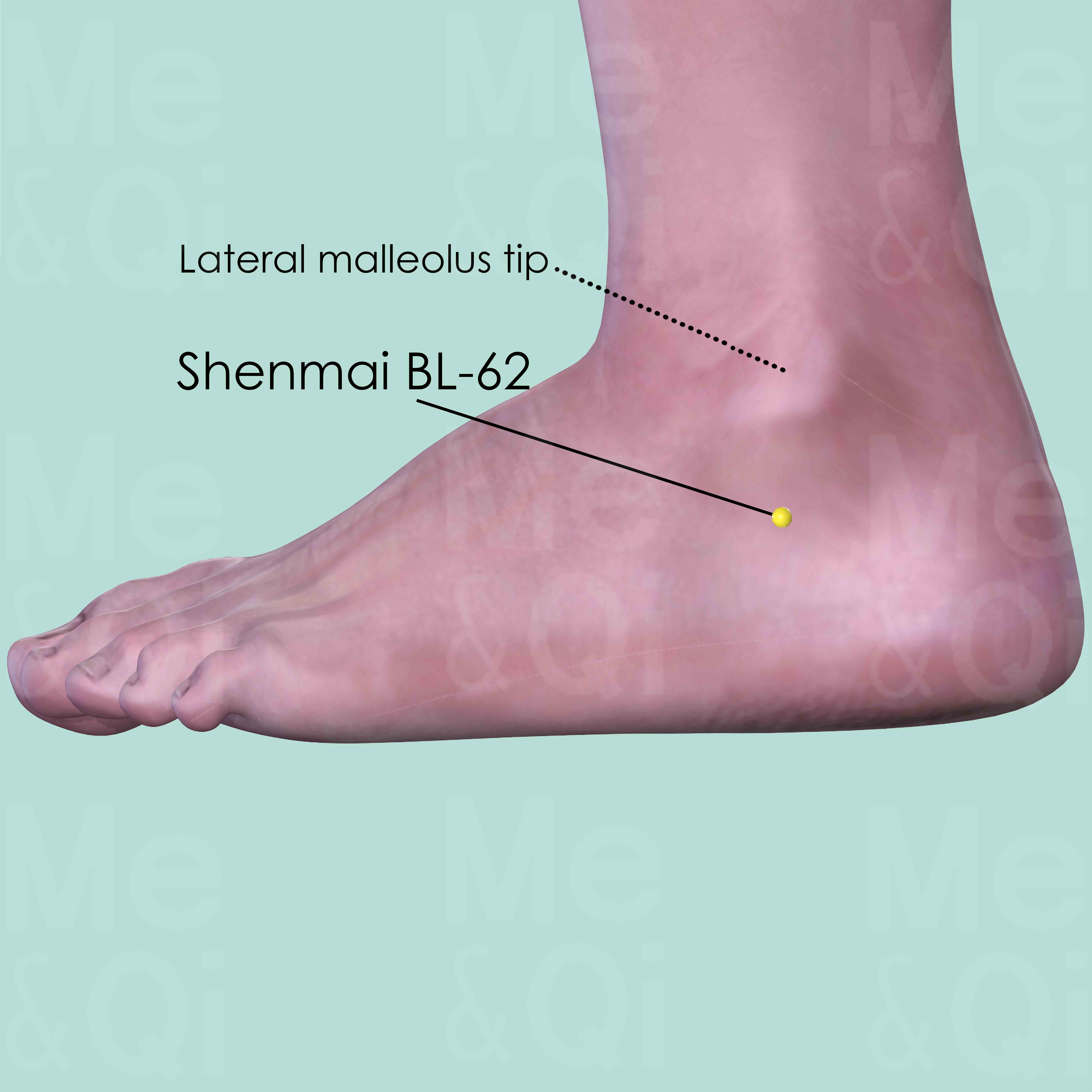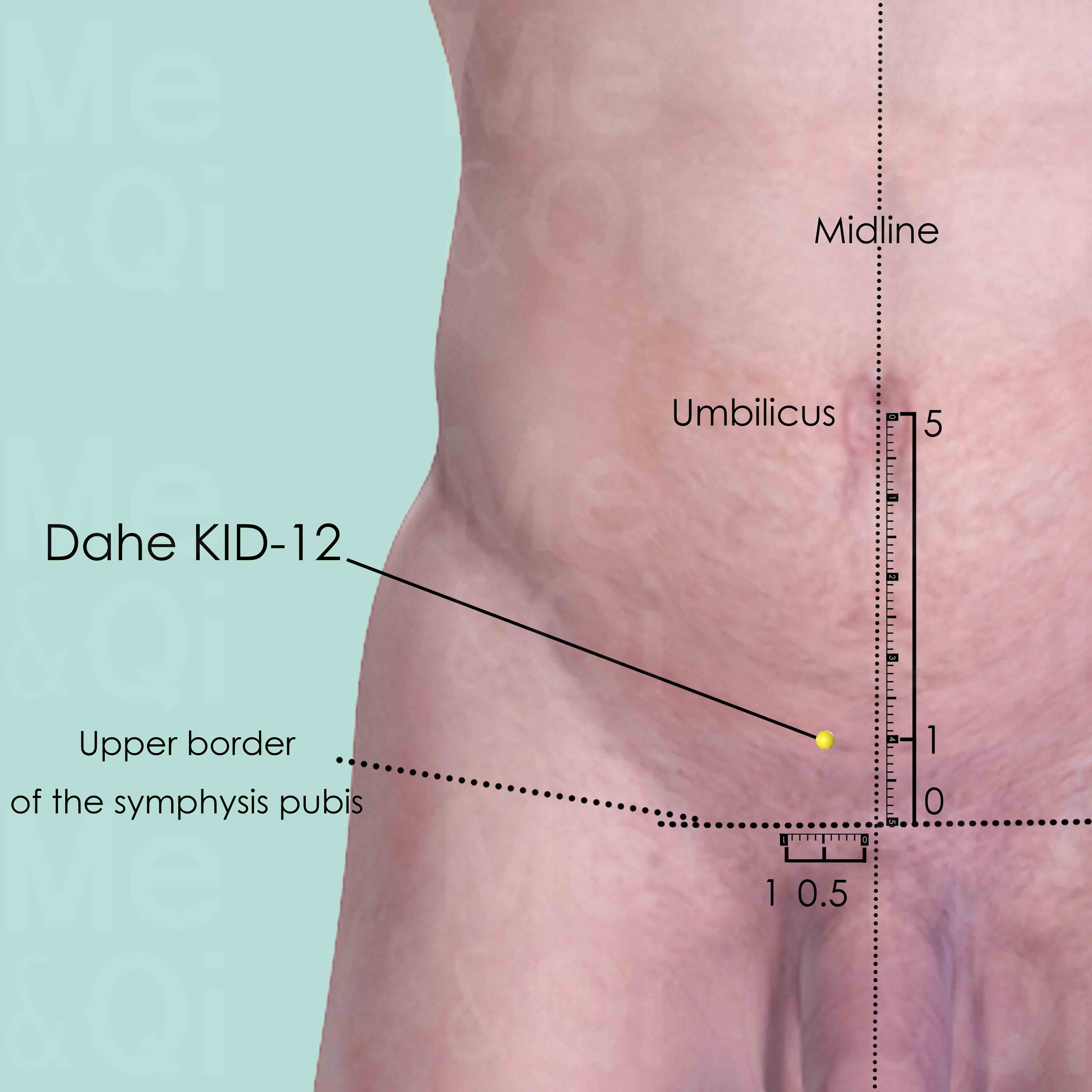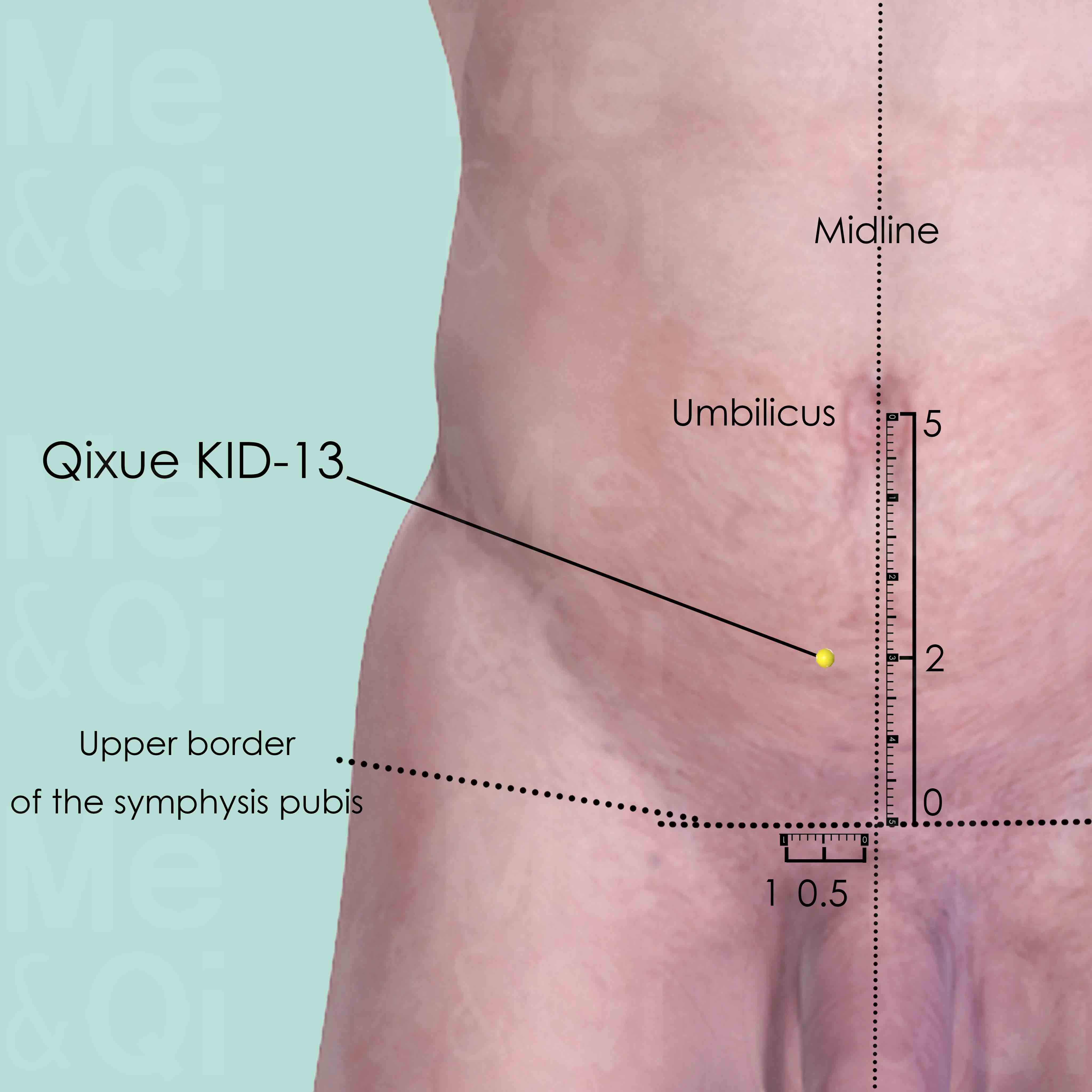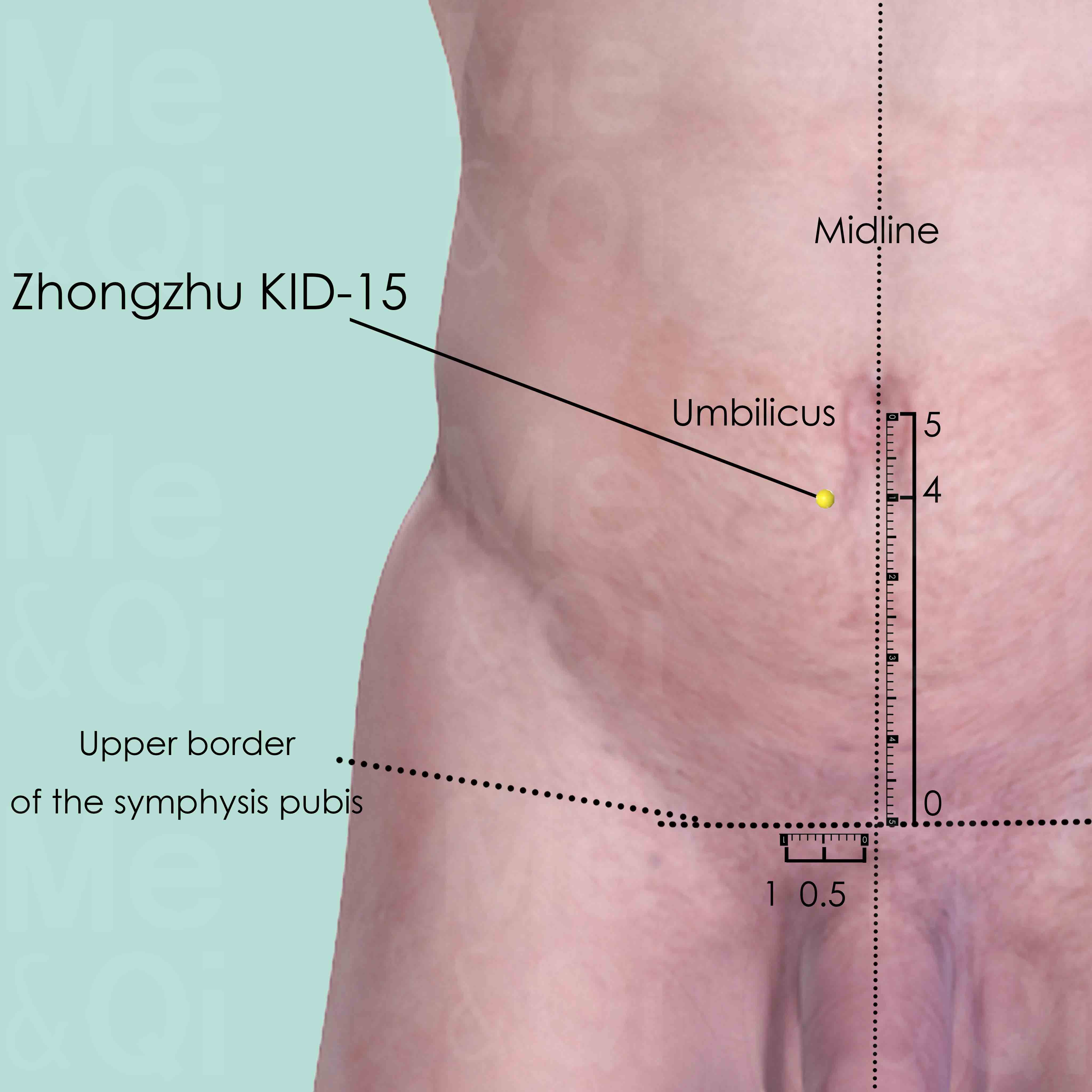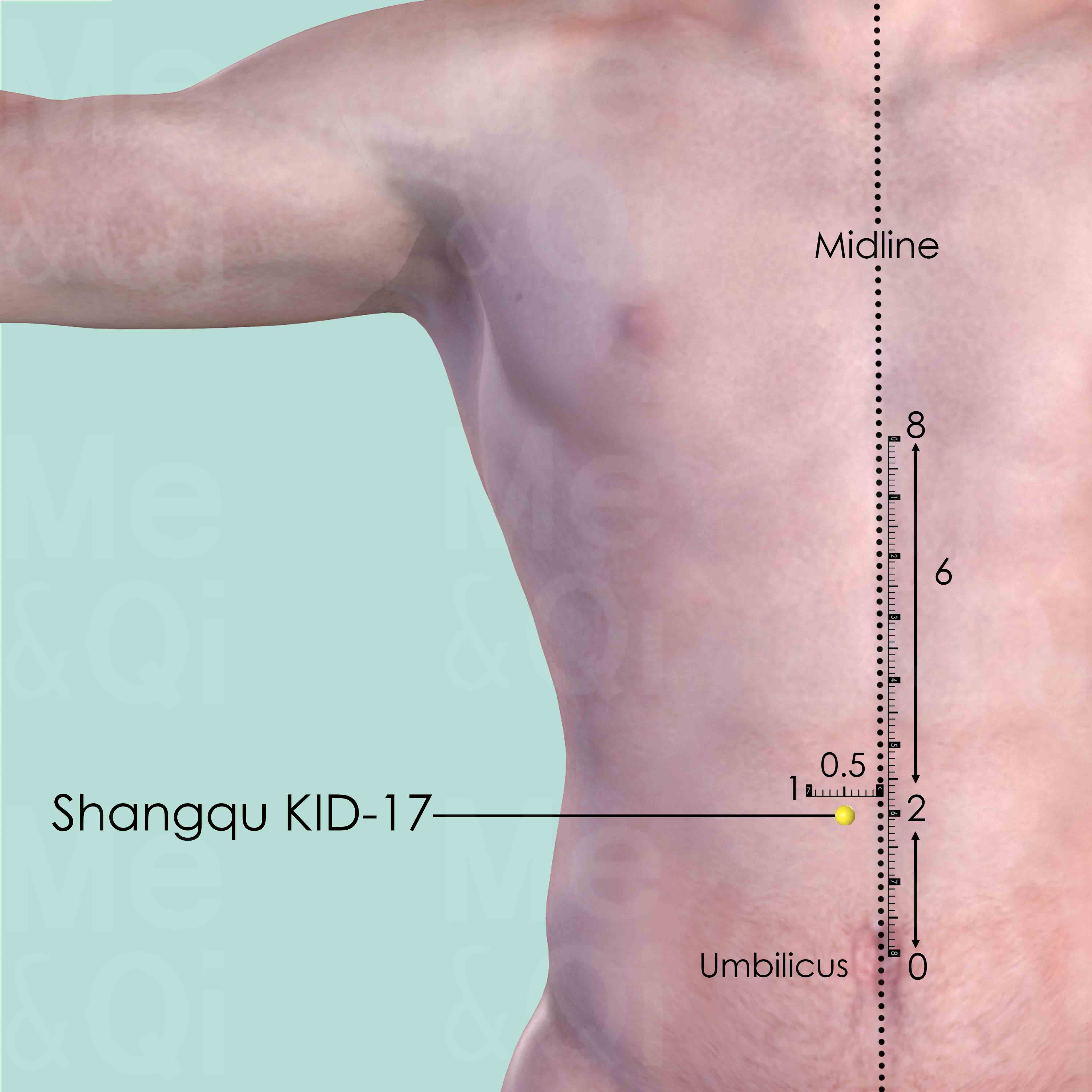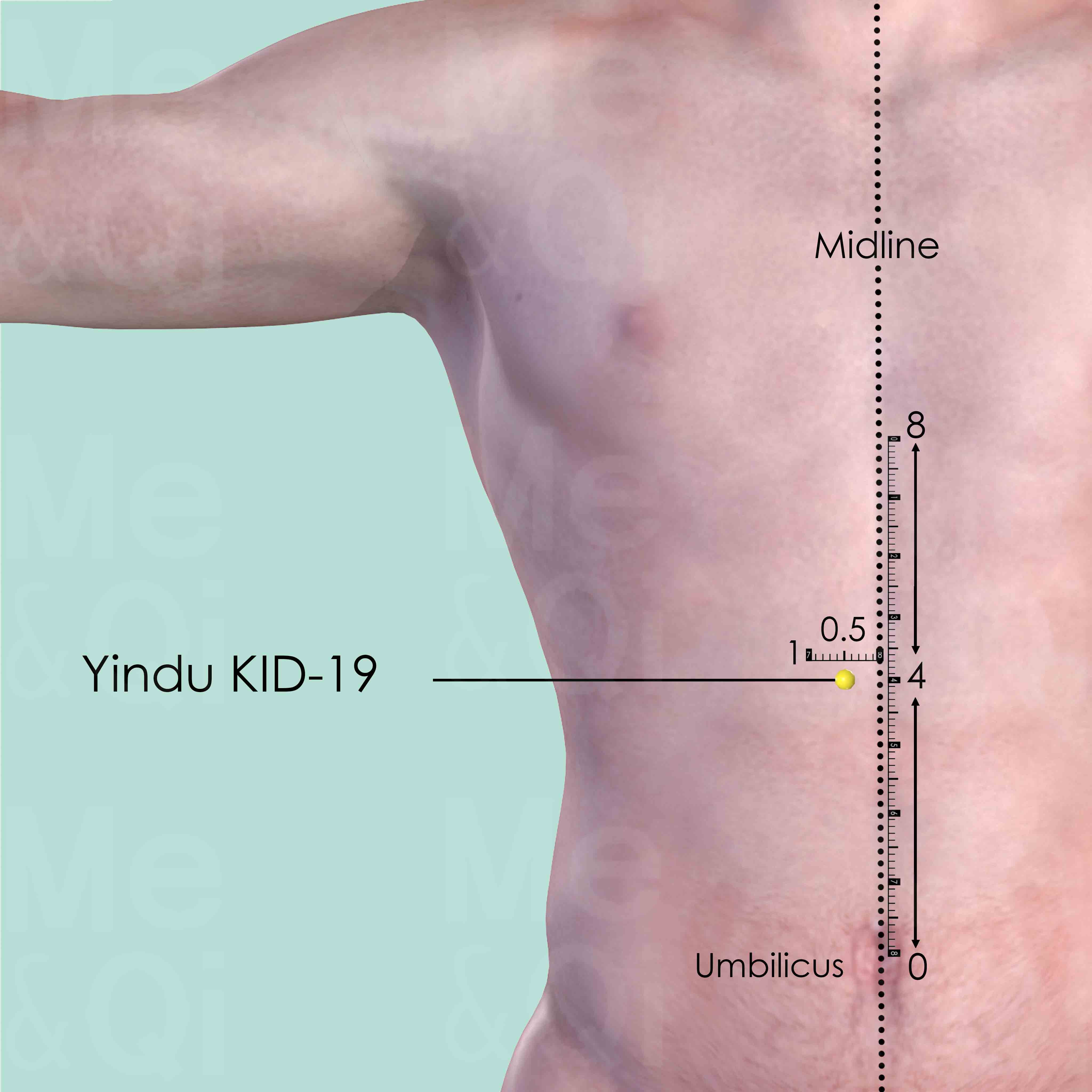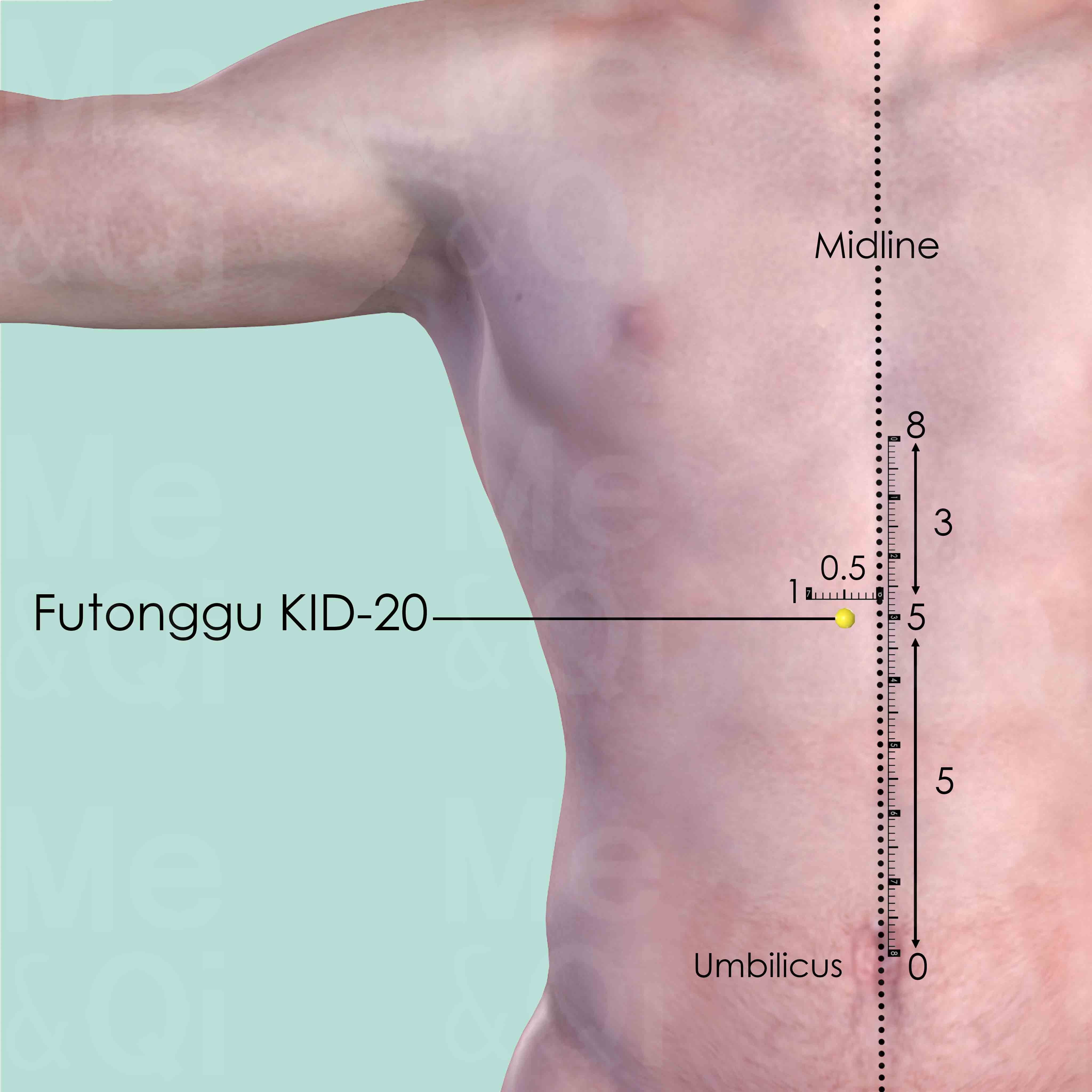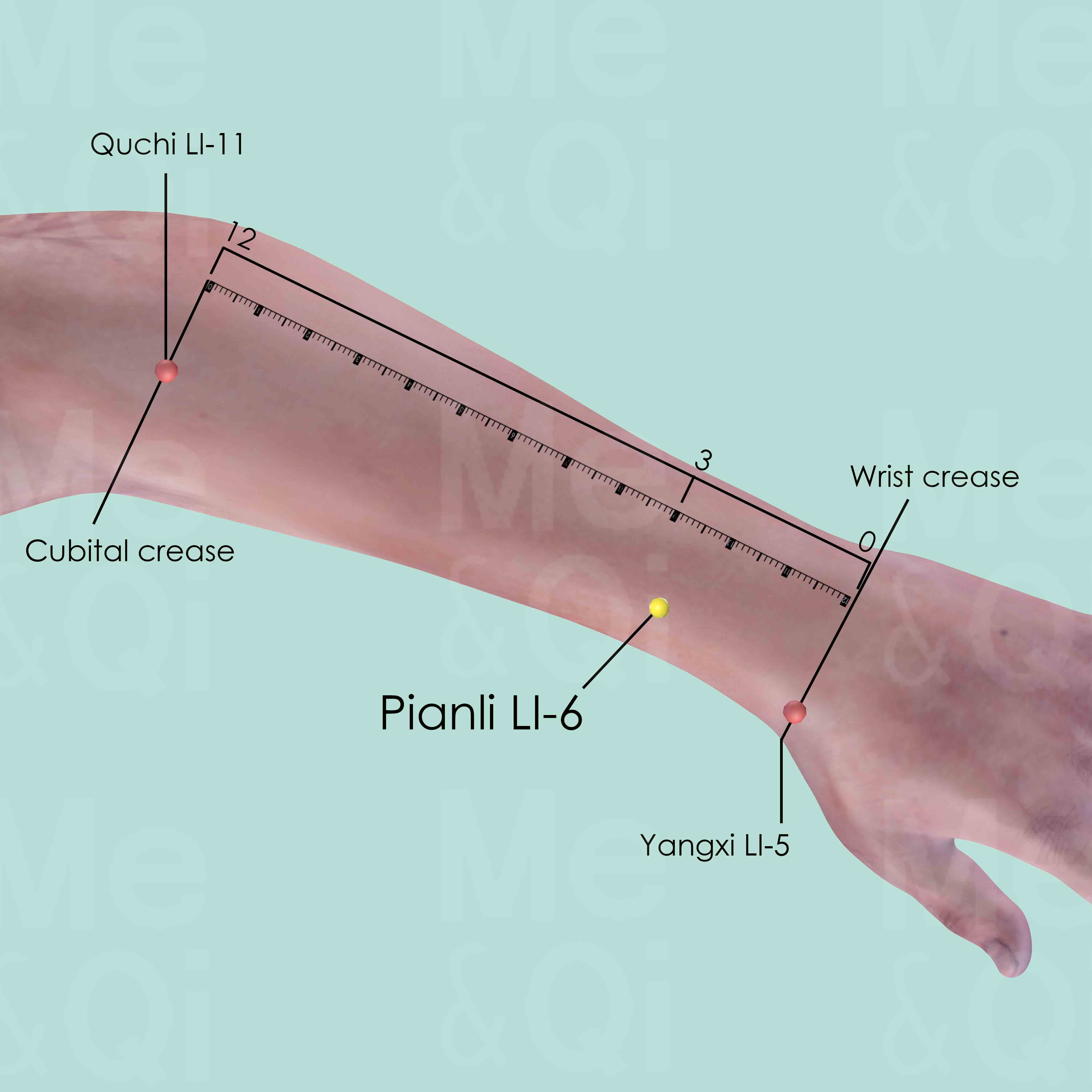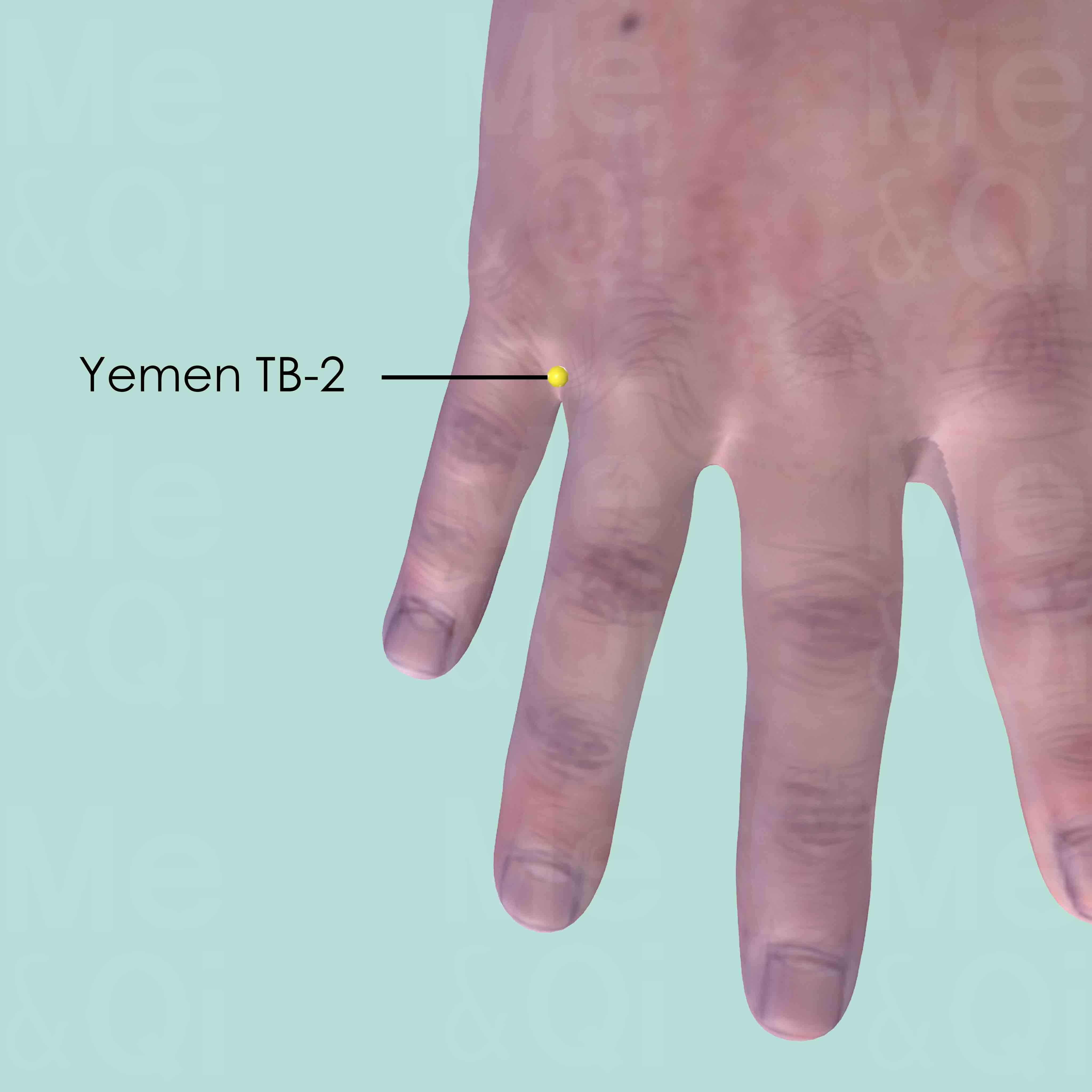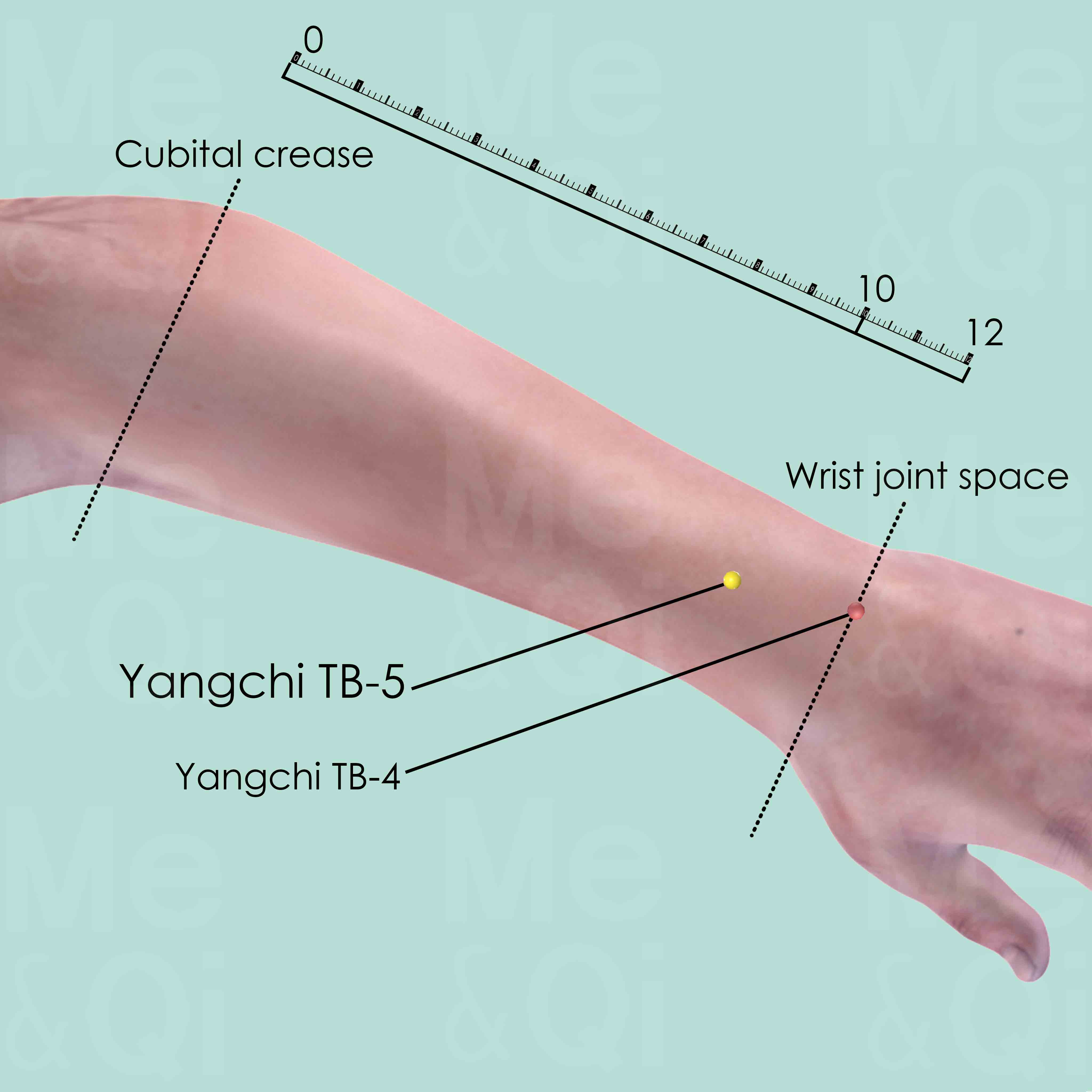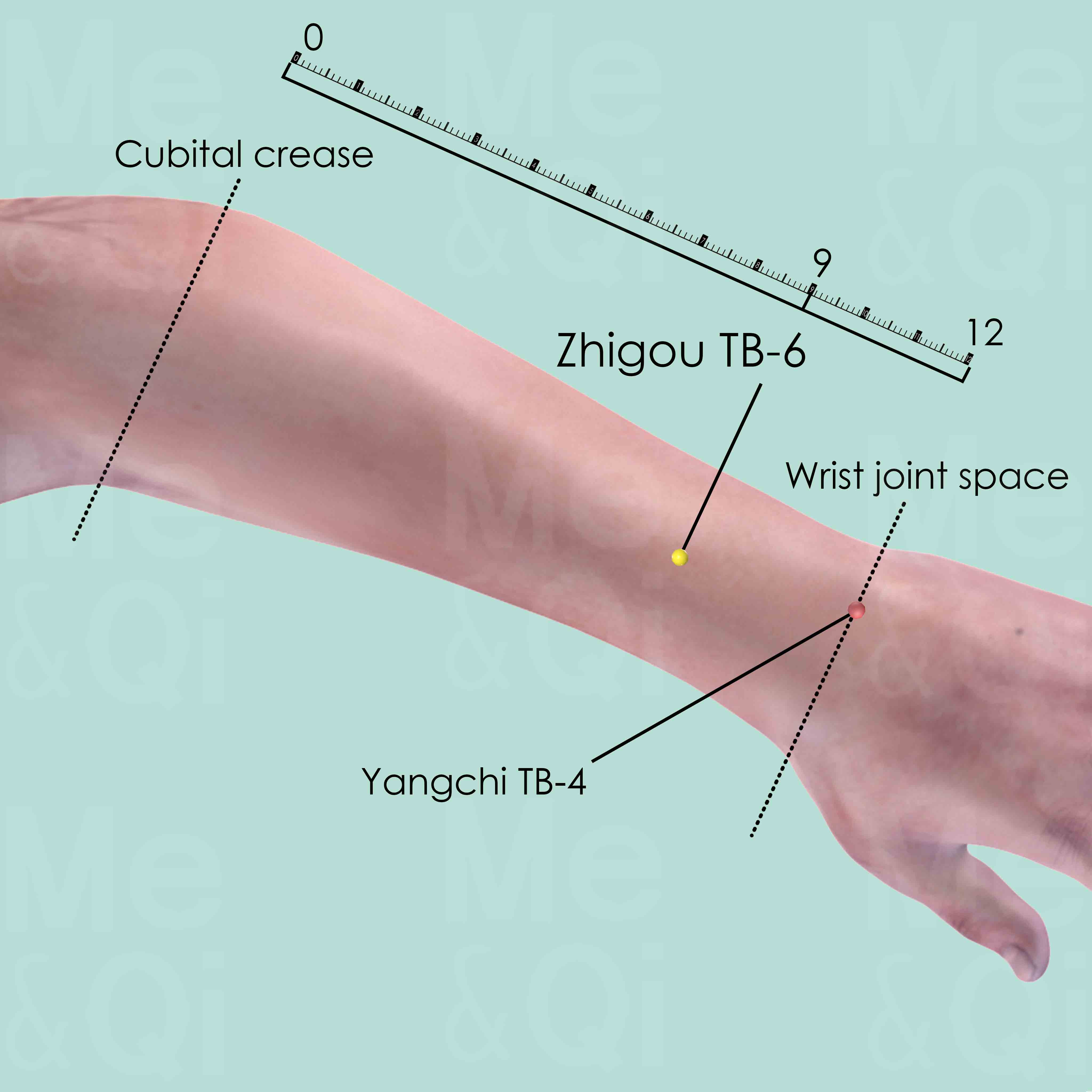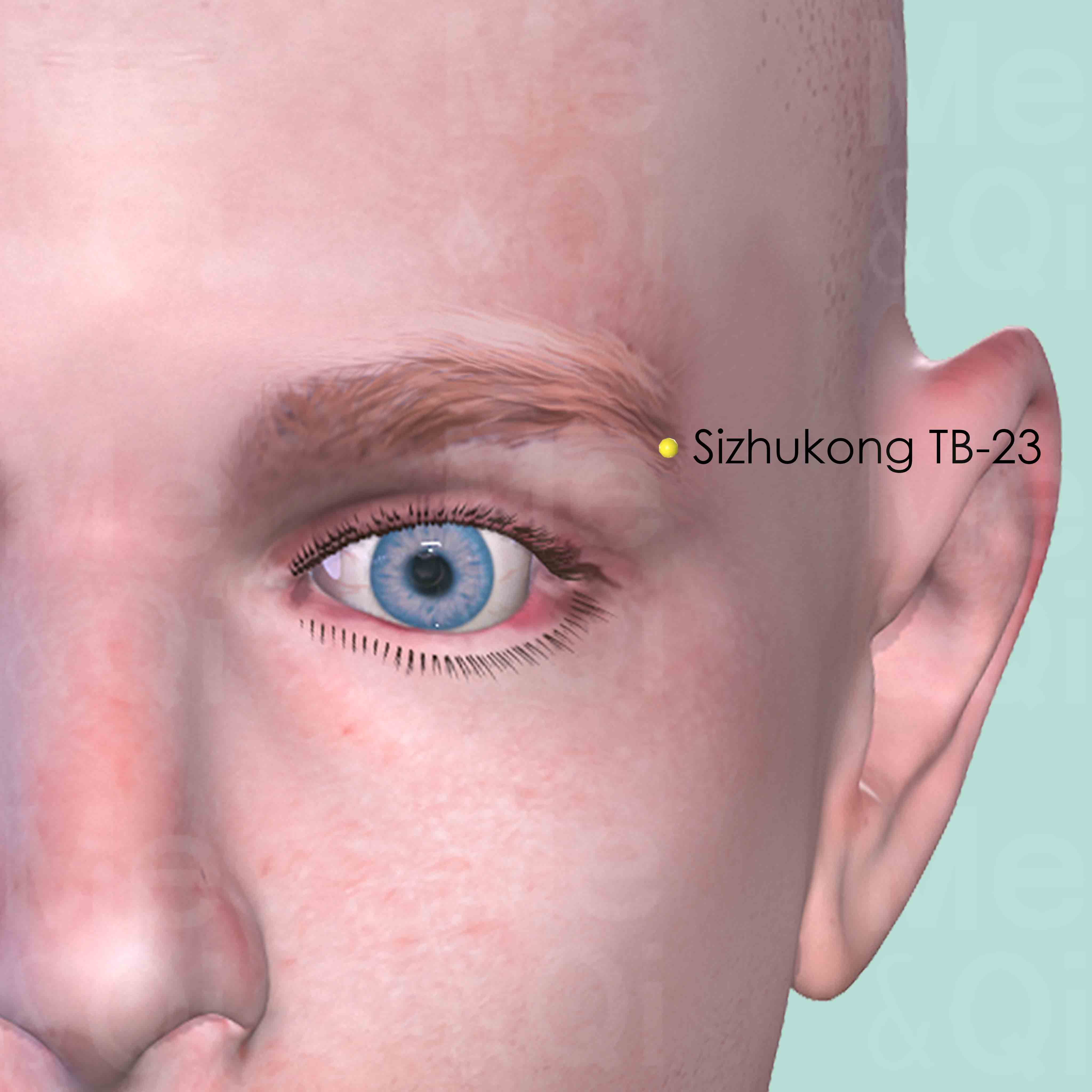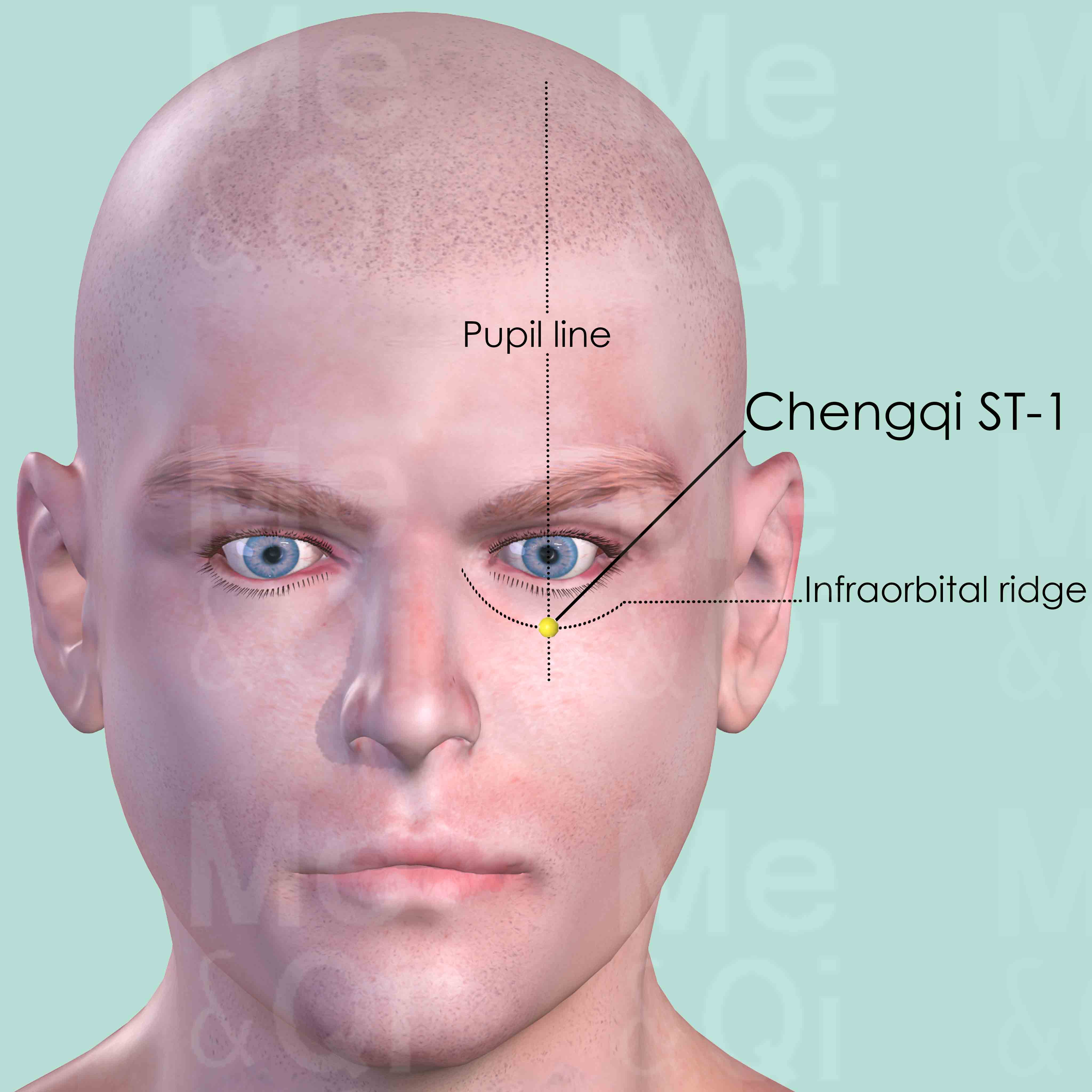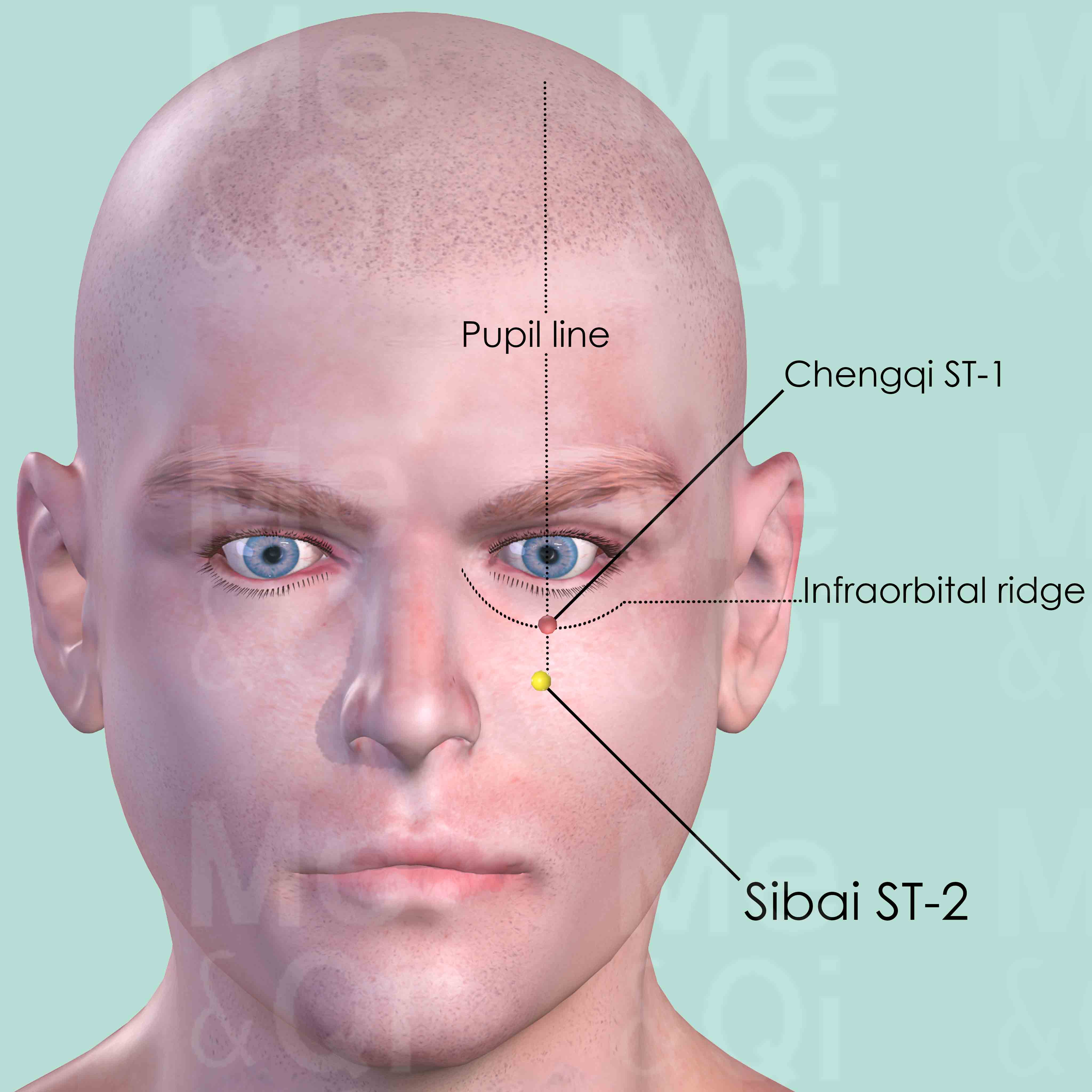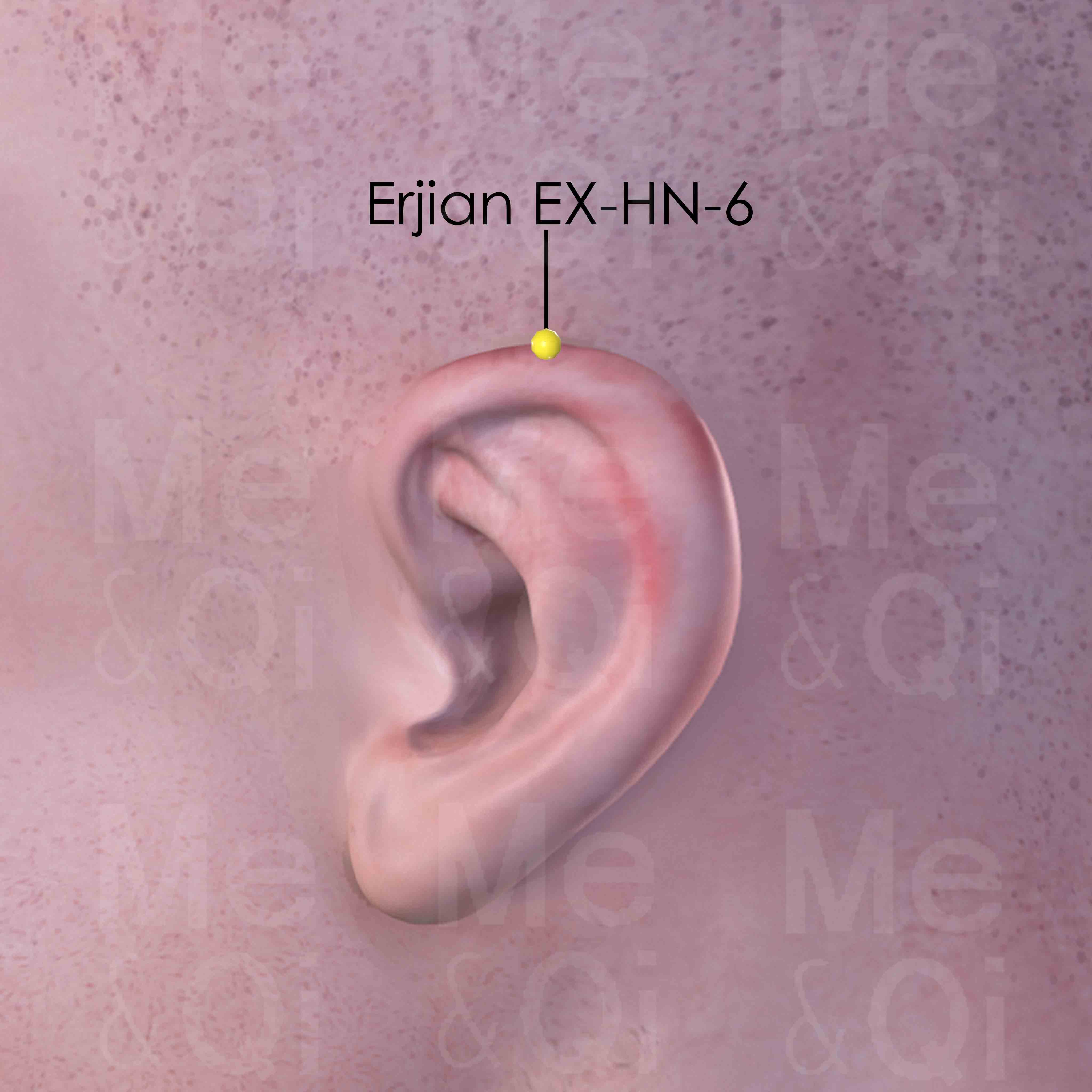Eye Hyperemiaaccording to TCM
Symptom families: Eye Disorders and Symptoms, Conjunctival Disorders
Sub-symptom(s): Redness Of The Inner Corner Of The Eye Outer Canthus Redness
What is Eye Hyperemia?
Eye hyperemia, commonly known as bloodshot eyes, is characterized by an excess of blood in the vessels of the conjunctiva, causing the eyes to appear red. This condition can arise from various causes, such as inflammation, irritation, fatigue, or underlying health issues. Symptoms include visible redness, particularly in the inner or outer corners of the eye. Understanding the underlying cause of this redness is essential for proper treatment and relief.
How does TCM view Eye Hyperemia?
Traditional Chinese Medicine (TCM) approaches eye hyperemia as a manifestation of internal disharmony. According to TCM, the eyes are closely connected to the Liver, and conditions affecting the eyes are often indicative of Liver dysfunction.
TCM identifies patterns of disharmony such as Heat or Wind causing the redness and irritation seen in eye hyperemia. Treatment focuses on restoring balance and addressing the root cause, using a combination of herbs, acupuncture, and dietary adjustments.
Root Causes of Eye Hyperemia in TCM
TCM recognizes several underlying patterns that can lead to eye hyperemia. One common cause is Liver Fire insulting the Lungs, marked by symptoms like shortness of breath, cough, and bloodshot eyes.
Another pattern, Liver Fire Blazing, is characterized by red eyes, irritability, and headaches. These conditions are treated through specific herbal formulas designed to clear Heat and soothe the Liver. Identifying the correct TCM pattern is crucial for effective treatment.
Explore below more details about what might cause Eye hyperemia according to TCM.
- By Syndrome
- By Organ
- Heat
- Wind
- Qi Stagnation
- Qi Deficiency
- Cold
- View More Causes
- Liver
- Lung
- Stomach
- Spleen
- View More Organs
Heat
In TCM "Heat" signifies an excess of Yang energy, leading to an imbalance where heat predominates over the body's cool Yin aspects. This condition is metaphorically akin to an internal over-heating. Symptoms indicative of Heat can include feelings of warmth, fever, sweating, irritability, red face, thirst with a preference for cold drinks, and a rapid pulse. The tongue may appear red with a yellow coating. Unlike the common interpretation of heat in terms of temperature, in TCM, it represents a state of hyperactivity or inflammation in the body.... see more
Heat Patterns That Can Lead to Eye Hyperemia
Common Symptoms: Flushed Face Thirst Constipation Irritability Headaches Dizziness Bitter Taste In The Mouth Anger
| Pattern Name | Relevant Symptoms | Relevant Formulas |
|---|---|---|
| Liver Fire insulting the Lungs | Bloodshot eyes, Shortness of breath, Asthma, Hypochondriac pain and discomfort, Cough with yellow or blood tinged sputum, Headaches, Dizziness, Flushed face, Thirst, Bitter taste in the mouth, Eye hyperemia, Scanty and dark urine, Constipation... see more | Long Dan Xie Gan Tang | Ke Xie Fang |
| Liver Fire Blazing | Red eyes, Irritability, Anger, Tinnitus, Deafness, Temporal headache, Dizziness, Flushed face, Eye hyperemia, Thirst, Bitter taste in the mouth, Vivid dreaming, Constipation, Dry stools, Dark urine, Nosebleeds, Hemoptysis, Vomiting blood... see more | Long Dan Xie Gan Tang | Dang Gui Long Hui Wan | Xie Qing Wan |
| Liver Wind agitating Internally due to Liver Fire | Red eyes, Tremors, Irritability, Anger, Tinnitus, Deafness, Temporal headache, Dizziness, Flushed face, Eye hyperemia, Thirst, Bitter taste in the mouth, Vivid dreaming, Constipation, Dry stools, Dark urine, Nosebleeds, Vomiting blood, Hemoptysis... see more | Ling Jiao Gou Teng Tang | Zi Xue Dan | Feng Yin Tang |
| Stagnant Liver Qi turning into Fire | Red eyes, Hypochondriac distention, Upper abdominal distension, Feeling of oppression of the chest, Irritability, Melancholia, Depression, Mood swings, Globus sensation, Feeling hot, Flushed face, Thirst, Anger, Pre menstrual tension, Irregular periods, Pre menstrual breast distension, Excessive menstruation... see more | Dan Zhi Xiao Yao San |
| Wind Cold with Internal Heat | Red eyes, Strong fever, Severe chills, Lack of sweating, Headaches, Feeling of heaviness, General sensation of tightness, Flushed face, Eye hyperemia, Dry nose, Thirst, Irritability, Insomnia, Hemoptysis, Mottled skin... see more | Shi Gao Tang |
| Stomach Fire or Stomach Heat | Red eyes, Toothache, Headaches, Stomatitis, Periodontitis, Glossitis, Trigeminal neuralgia, Diabetes, Viral myocarditis, Breast engorgement, Breast lumps... see more | Gua Lou San | Yu Nu Jian | Wen Dan Tang |
| Liver Qi Stagnation with Spleen Qi Deficiency that transforms into Heat | Red eyes, Irritability, Spontaneous sweat, Eye hyperemia, Dry mouth, Palpitations, Lower abdominal oppression, Painful urination, Excessive menstruation, Abnormal uterine bleeding, Tidal fever... see more | Jia Wei Xiao Yao San |
Wind
In TCM "Wind" is a concept that represents a pattern of disharmony, often characterized by its sudden and unpredictable nature, much like a gusty wind changing direction without warning. This pattern is associated with symptoms that come and go quickly or move around the body, such as itching, tremors, or even certain types of pain. Wind is considered to be a primary cause of illnesses that have these rapidly changing characteristics. In TCM, external Wind often refers to illnesses that start suddenly, like the common cold, believed to be caused by external pathogenic factors like climatic changes. On the other hand, internal Wind can be linked to internal imbalances and can manifest in conditions like dizziness or spasms. ... see more
Wind Patterns That Can Lead to Eye Hyperemia
Common Symptoms: Irritability Flushed Face Dizziness Tremors Headaches Insomnia Anger Deafness
| Pattern Name | Relevant Symptoms | Relevant Formulas |
|---|---|---|
| Interior Wind | Red eyes, Convulsions, Hand tremor, Dizziness, Paralysis, Coma, Tic disorder, Mouth deviation, Eye deviation, Tremors, Headaches, Limb numbness... see more | Tian Ma Gou Teng Yin | Ling Jiao Gou Teng Tang | Liu Wei Di Huang Wan | Qi Ju Di Huang Wan | E Jiao Ji Zi Huang Tang | Zhen Gan Xi Feng Tang | Bu Gan Tang | Si Wu Tang |
| Liver Wind agitating Internally due to Liver Fire | Red eyes, Tremors, Irritability, Anger, Tinnitus, Deafness, Temporal headache, Dizziness, Flushed face, Eye hyperemia, Thirst, Bitter taste in the mouth, Vivid dreaming, Constipation, Dry stools, Dark urine, Nosebleeds, Vomiting blood, Hemoptysis... see more | Ling Jiao Gou Teng Tang | Zi Xue Dan | Feng Yin Tang |
| Wind Cold with Internal Heat | Red eyes, Strong fever, Severe chills, Lack of sweating, Headaches, Feeling of heaviness, General sensation of tightness, Flushed face, Eye hyperemia, Dry nose, Thirst, Irritability, Insomnia, Hemoptysis, Mottled skin... see more | Shi Gao Tang |
Qi Stagnation
Qi Stagnation in TCM is like having a traffic jam in your body's energy system. Qi, the vital life force that flows through your body, is supposed to move smoothly to maintain health and balance. But with Qi Stagnation, this flow gets blocked or slowed down, like cars stuck on a highway. This can lead to symptoms like feeling stressed, emotional mood swings, and physical discomfort, often described as a feeling of fullness or tightness, especially in the chest or abdomen. It's as though the body's internal energy circulation is disrupted, causing various issues. TCM sees this as an energy flow problem, different from modern medicine's focus on specific physiological processes.... see more
Qi Stagnation Patterns That Can Lead to Eye Hyperemia
Common Symptoms: Irritability Excessive Menstruation Menstrual Cramps Spontaneous Sweat Dry Mouth Palpitations Lower Abdominal Oppression Painful Urination
| Pattern Name | Relevant Symptoms | Relevant Formulas |
|---|---|---|
| Stagnant Liver Qi turning into Fire | Red eyes, Hypochondriac distention, Upper abdominal distension, Feeling of oppression of the chest, Irritability, Melancholia, Depression, Mood swings, Globus sensation, Feeling hot, Flushed face, Thirst, Anger, Pre menstrual tension, Irregular periods, Pre menstrual breast distension, Excessive menstruation... see more | Dan Zhi Xiao Yao San |
| Liver Qi Stagnation with Spleen Qi Deficiency that transforms into Heat | Red eyes, Irritability, Spontaneous sweat, Eye hyperemia, Dry mouth, Palpitations, Lower abdominal oppression, Painful urination, Excessive menstruation, Abnormal uterine bleeding, Tidal fever... see more | Jia Wei Xiao Yao San |
Qi Deficiency
Qi Deficiency in TCM is like running low on battery power. Qi is the vital energy that powers every function in your body. When there's a Qi Deficiency, it means your body doesn't have enough of this essential energy. This can make you feel tired all the time, weak, or even cause shortness of breath. It's similar to how you feel when you haven't had enough sleep or nutritious food. Your body just doesn't have the energy it needs to perform at its best. Unlike modern medicine, which often focuses on specific physical causes for fatigue and weakness, TCM views Qi Deficiency as an overall energy depletion that affects your entire well-being, and it seeks to replenish and balance this vital energy.... see more
Qi Deficiency Patterns That Can Lead to Eye Hyperemia
| Pattern Name | Relevant Symptoms | Relevant Formulas |
|---|---|---|
| Liver Qi Stagnation with Spleen Qi Deficiency that transforms into Heat | Red eyes, Irritability, Spontaneous sweat, Eye hyperemia, Dry mouth, Palpitations, Lower abdominal oppression, Painful urination, Excessive menstruation, Abnormal uterine bleeding, Tidal fever... see more | Jia Wei Xiao Yao San |
Cold
In TCM "Cold" as a pattern of disharmony refers to a specific type of imbalance within the body's systems, often linked to a deficiency or weakness. It's not about feeling physically cold or having a common cold, but rather a metaphorical description of certain symptoms and underlying conditions. When a TCM practitioner says someone suffers from "Cold," it usually implies that the body's Yang energy, which is warm and active, is insufficient or overpowered by Yin energy, which is cool and passive. Symptoms of Cold in TCM can include a general feeling of coldness, cold limbs, pale complexion, low energy, slow metabolism, and a preference for warmth. ... see more
Cold Patterns That Can Lead to Eye Hyperemia
| Pattern Name | Relevant Symptoms | Relevant Formulas |
|---|---|---|
| Wind Cold with Internal Heat | Red eyes, Strong fever, Severe chills, Lack of sweating, Headaches, Feeling of heaviness, General sensation of tightness, Flushed face, Eye hyperemia, Dry nose, Thirst, Irritability, Insomnia, Hemoptysis, Mottled skin... see more | Shi Gao Tang |
Liver
In TCM the Liver is viewed as the organ responsible for the smooth flow of Qi, Blood, and emotions throughout the body. It plays a key role in regulating mood, storing blood, supporting digestion, and ensuring the health of tendons and eyes. When the Liver malfunctions or is imbalanced in TCM, it can lead to a range of issues such as irritability, mood swings, menstrual irregularities, eye problems, and muscular stiffness or pain. A malfunctioning Liver in TCM reflects not only physical disturbances but also emotional and mental disharmony, emphasizing the holistic approach of TCM in addressing health and wellness.... see more
Liver Patterns That Can Lead to Eye Hyperemia
Common Symptoms: Dizziness Flushed Face Thirst Bitter Taste In The Mouth Constipation Irritability Anger Dry Stools
| Pattern Name | Relevant Symptoms | Relevant Formulas |
|---|---|---|
| Liver Fire insulting the Lungs | Bloodshot eyes, Shortness of breath, Asthma, Hypochondriac pain and discomfort, Cough with yellow or blood tinged sputum, Headaches, Dizziness, Flushed face, Thirst, Bitter taste in the mouth, Eye hyperemia, Scanty and dark urine, Constipation... see more | Long Dan Xie Gan Tang | Ke Xie Fang |
| Liver Fire Blazing | Red eyes, Irritability, Anger, Tinnitus, Deafness, Temporal headache, Dizziness, Flushed face, Eye hyperemia, Thirst, Bitter taste in the mouth, Vivid dreaming, Constipation, Dry stools, Dark urine, Nosebleeds, Hemoptysis, Vomiting blood... see more | Long Dan Xie Gan Tang | Dang Gui Long Hui Wan | Xie Qing Wan |
| Liver Wind agitating Internally due to Liver Fire | Red eyes, Tremors, Irritability, Anger, Tinnitus, Deafness, Temporal headache, Dizziness, Flushed face, Eye hyperemia, Thirst, Bitter taste in the mouth, Vivid dreaming, Constipation, Dry stools, Dark urine, Nosebleeds, Vomiting blood, Hemoptysis... see more | Ling Jiao Gou Teng Tang | Zi Xue Dan | Feng Yin Tang |
| Stagnant Liver Qi turning into Fire | Red eyes, Hypochondriac distention, Upper abdominal distension, Feeling of oppression of the chest, Irritability, Melancholia, Depression, Mood swings, Globus sensation, Feeling hot, Flushed face, Thirst, Anger, Pre menstrual tension, Irregular periods, Pre menstrual breast distension, Excessive menstruation... see more | Dan Zhi Xiao Yao San |
| Liver Qi Stagnation with Spleen Qi Deficiency that transforms into Heat | Red eyes, Irritability, Spontaneous sweat, Eye hyperemia, Dry mouth, Palpitations, Lower abdominal oppression, Painful urination, Excessive menstruation, Abnormal uterine bleeding, Tidal fever... see more | Jia Wei Xiao Yao San |
Lung
In TCM the Lungs are seen as the organ responsible for controlling Qi and respiration, as well as being a key part of the body's defensive system. They are thought to maintain the balance and flow of air and moisture, and are closely linked to the skin and hair. When the Lungs are imbalanced or malfunctioning in TCM, it can lead to respiratory issues like coughing or asthma, a weakened immune system, dry skin, and emotional disturbances such as sadness or grief. These symptoms are believed to arise from disruptions in the Lungs' ability to regulate Qi and protect the body, highlighting their central role in maintaining overall health and well-being.... see more
Lung Patterns That Can Lead to Eye Hyperemia
| Pattern Name | Relevant Symptoms | Relevant Formulas |
|---|---|---|
| Liver Fire insulting the Lungs | Bloodshot eyes, Shortness of breath, Asthma, Hypochondriac pain and discomfort, Cough with yellow or blood tinged sputum, Headaches, Dizziness, Flushed face, Thirst, Bitter taste in the mouth, Eye hyperemia, Scanty and dark urine, Constipation... see more | Long Dan Xie Gan Tang | Ke Xie Fang |
Stomach
In TCM the Stomach is regarded as the "sea of nourishment," pivotal for digesting food and transforming it into Qi and blood. It works closely with the Spleen to distribute these essential nutrients throughout the body. When the Stomach is out of balance or malfunctions in TCM, it often leads to digestive problems such as bloating, nausea, vomiting, poor appetite, or a feeling of fullness. There may also be issues like acid reflux or a sour taste in the mouth. Emotionally, an imbalanced Stomach can contribute to excessive worry and overthinking, reflecting the TCM belief that physical and emotional well-being are deeply interconnected.... see more
Stomach Patterns That Can Lead to Eye Hyperemia
| Pattern Name | Relevant Symptoms | Relevant Formulas |
|---|---|---|
| Stomach Fire or Stomach Heat | Red eyes, Toothache, Headaches, Stomatitis, Periodontitis, Glossitis, Trigeminal neuralgia, Diabetes, Viral myocarditis, Breast engorgement, Breast lumps... see more | Gua Lou San | Yu Nu Jian | Wen Dan Tang |
Spleen
In TCM the Spleen plays a vital role in digestion and transformation, converting food into energy and nutrients, and overseeing the distribution of Qi and Blood. It's also crucial in maintaining the health of muscles and limbs and ensuring the blood remains within the vessels. When the Spleen malfunctions in TCM, it can lead to a variety of issues such as digestive disorders, fatigue, weak muscles, bloating, and a feeling of heaviness. It can also cause a pale complexion, poor appetite, and a tendency to bruise easily. Emotionally, a Spleen imbalance is often associated with excessive worry or overthinking, reflecting its role in the interplay between physical and mental health.... see more
Spleen Patterns That Can Lead to Eye Hyperemia
| Pattern Name | Relevant Symptoms | Relevant Formulas |
|---|---|---|
| Liver Qi Stagnation with Spleen Qi Deficiency that transforms into Heat | Red eyes, Irritability, Spontaneous sweat, Eye hyperemia, Dry mouth, Palpitations, Lower abdominal oppression, Painful urination, Excessive menstruation, Abnormal uterine bleeding, Tidal fever... see more | Jia Wei Xiao Yao San |
TCM Herbal Formulas for Eye Hyperemia
TCM utilizes a range of herbal formulas to address eye hyperemia. Long Dan Xie Gan Tang, containing Chinese Gentian, is frequently used for conditions like Liver Fire Blazing or Liver Fire insulting the Lungs. This formula is effective in clearing Heat and dampness, often associated with red eyes.
Additionally, Tian Ma Gou Teng Yin and Ling Jiao Gou Teng Tang are recommended for Internal Wind patterns that can also lead to eye hyperemia. These formulas are selected based on the specific pattern of disharmony in the patient, ensuring a tailored treatment approach.
Explore below some TCM herbal formulas used to address eye hyperemia, organized by cause and by formula type.
- By Cause
- By Formula Type
- Heat
- Wind
- Qi Stagnation
- Qi Deficiency
- Cold
- View More Causes
- Formulas that clear heat from the organs
- Formulas that pacify and extinguish internal wind
- Formulas that nourish yin and tonify
- Formulas that tonify blood
- Formulas that stop bleeding
- Formulas that clear heat and resolve toxicity
- Formulas that harmonize liver-Spleen
- Formulas that clear heat and open sensory orifices
- Formulas that dredge and disperse external wind
- Formulas that dry dampness and transform phlegm
- Formulas that clear liver-Heat
- Formulas that release the exterior and clear the interior
Top Formula for Heat:
Long Dan Xie Gan Tang
Suitable for Heat patterns that may cause eye hyperemia, such as Liver Fire insulting the Lungs or Liver Fire Blazing
Learn moreAll Formulas Recommended for Eye Hyperemia Caused by Heat
| Formula | Patterns Suitable For |
|---|---|
| Long Dan Xie Gan Tang | Liver Fire insulting the Lungs, Liver Fire Blazing |
| Ling Jiao Gou Teng Tang | Liver Wind agitating Internally due to Liver Fire |
| Ke Xie Fang | Liver Fire insulting the Lungs |
| Gua Lou San | Stomach Fire or Stomach Heat |
| Yu Nu Jian | Stomach Fire or Stomach Heat |
| Wen Dan Tang | Stomach Fire or Stomach Heat |
| Jia Wei Xiao Yao San | Liver Qi Stagnation with Spleen Qi Deficiency that transforms into Heat |
| Dang Gui Long Hui Wan | Liver Fire Blazing |
| Xie Qing Wan | Liver Fire Blazing |
| Zi Xue Dan | Liver Wind agitating Internally due to Liver Fire |
| Feng Yin Tang | Liver Wind agitating Internally due to Liver Fire |
| Dan Zhi Xiao Yao San | Stagnant Liver Qi turning into Fire |
| Shi Gao Tang | Wind Cold with Internal Heat |
Top Formula for Wind:
Ling Jiao Gou Teng Tang
Suitable for Wind patterns that may cause eye hyperemia, such as Interior Wind or Liver Wind agitating Internally due to Liver Fire
Learn moreAll Formulas Recommended for Eye Hyperemia Caused by Wind
| Formula | Patterns Suitable For |
|---|---|
| Ling Jiao Gou Teng Tang | Interior Wind, Liver Wind agitating Internally due to Liver Fire |
| Tian Ma Gou Teng Yin | Interior Wind |
| Liu Wei Di Huang Wan | Interior Wind |
| Qi Ju Di Huang Wan | Interior Wind |
| E Jiao Ji Zi Huang Tang | Interior Wind |
| Zhen Gan Xi Feng Tang | Interior Wind |
| Bu Gan Tang | Interior Wind |
| Si Wu Tang | Interior Wind |
| Zi Xue Dan | Liver Wind agitating Internally due to Liver Fire |
| Feng Yin Tang | Liver Wind agitating Internally due to Liver Fire |
| Shi Gao Tang | Wind Cold with Internal Heat |
Top Formula for Qi Stagnation:
Jia Wei Xiao Yao San
Suitable for Qi Stagnation patterns that may cause eye hyperemia, such as Liver Qi Stagnation with Spleen Qi Deficiency that transforms into Heat
Learn moreAll Formulas Recommended for Eye Hyperemia Caused by Qi Stagnation
| Formula | Patterns Suitable For |
|---|---|
| Jia Wei Xiao Yao San | Liver Qi Stagnation with Spleen Qi Deficiency that transforms into Heat |
| Dan Zhi Xiao Yao San | Stagnant Liver Qi turning into Fire |
Top Formula for Qi Deficiency:
Jia Wei Xiao Yao San
Suitable for Qi Deficiency patterns that may cause eye hyperemia, such as Liver Qi Stagnation with Spleen Qi Deficiency that transforms into Heat
Learn moreTop Formula for Cold:
Shi Gao Tang
Suitable for Cold patterns that may cause eye hyperemia, such as Wind Cold with Internal Heat
Learn moreFormulas that clear Heat from the Organs
These formulas are suitable for some eye hyperemia-causing patterns like Liver Fire insulting the Lungs or Liver Fire Blazing.
One such formula is Long Dan Xie Gan Tang, with chinese gentian as a key herb.
Other formulas of this category are listed in the table below.
All "formulas that clear heat from the organs" recommended for eye hyperemia
| Formula | Patterns Suitable For (if applicable) |
|---|---|
| Long Dan Xie Gan Tang | Liver Fire insulting the Lungs, Liver Fire Blazing |
| Dang Gui Long Hui Wan | Liver Fire Blazing |
| Xie Qing Wan | Liver Fire Blazing |
| Yu Nu Jian | Stomach Fire or Stomach Heat |
Formulas that pacify and extinguish Internal Wind
These formulas are suitable for some eye hyperemia-causing patterns like Interior Wind or Liver Wind agitating Internally due to Liver Fire.
One such formula is Ling Jiao Gou Teng Tang, with saiga antelope's horns as a key herb.
Other formulas of this category are listed in the table below.
All "formulas that pacify and extinguish internal wind" recommended for eye hyperemia
| Formula | Patterns Suitable For (if applicable) |
|---|---|
| Ling Jiao Gou Teng Tang | Interior Wind, Liver Wind agitating Internally due to Liver Fire |
| Tian Ma Gou Teng Yin | Interior Wind |
| E Jiao Ji Zi Huang Tang | Interior Wind |
| Zhen Gan Xi Feng Tang | Interior Wind |
Formulas that nourish Yin and tonify
These formulas are suitable for some eye hyperemia-causing patterns like Interior Wind.
One such formula is Liu Wei Di Huang Wan, with prepared rehmannia as a key herb.
Other formulas of this category are listed in the table below.
All "formulas that nourish yin and tonify" recommended for eye hyperemia
| Formula | Patterns Suitable For (if applicable) |
|---|---|
| Liu Wei Di Huang Wan | Interior Wind |
| Qi Ju Di Huang Wan | Interior Wind |
Formulas that tonify Blood
These formulas are suitable for some eye hyperemia-causing patterns like Interior Wind.
One such formula is Bu Gan Tang, with prepared rehmannia as a key herb.
Other formulas of this category are listed in the table below.
All "formulas that tonify blood" recommended for eye hyperemia
| Formula | Patterns Suitable For (if applicable) |
|---|---|
| Bu Gan Tang | Interior Wind |
| Si Wu Tang | Interior Wind |
Formulas that stop bleeding
These formulas are suitable for some eye hyperemia-causing patterns like Liver Fire insulting the Lungs.
One such formula is Ke Xie Fang, with natural indigo as a key herb.
Formulas that clear Heat and resolve toxicity
These formulas are suitable for some eye hyperemia-causing patterns like Stomach Fire or Stomach Heat.
One such formula is Gua Lou San, with snake gourd as a key herb.
Formulas that harmonize Liver-Spleen
These formulas are suitable for some eye hyperemia-causing patterns like Liver Qi Stagnation with Spleen Qi Deficiency that transforms into Heat.
One such formula is Jia Wei Xiao Yao San, with bupleurum root as a key herb.
Formulas that clear Heat and open sensory orifices
These formulas are suitable for some eye hyperemia-causing patterns like Liver Wind agitating Internally due to Liver Fire.
One such formula is Zi Xue Dan, with water buffalo horn as a key herb.
Formulas that dredge and disperse External Wind
These formulas are suitable for some eye hyperemia-causing patterns like Liver Wind agitating Internally due to Liver Fire.
One such formula is Feng Yin Tang, with dragon bones as a key herb.
Formulas that dry Dampness and transform Phlegm
These formulas are suitable for some eye hyperemia-causing patterns like Stomach Fire or Stomach Heat.
One such formula is Wen Dan Tang, with crow-dipper rhizome as a key herb.
Formulas that clear Liver-Heat
These formulas are suitable for some eye hyperemia-causing patterns like Stagnant Liver Qi turning into Fire.
One such formula is Dan Zhi Xiao Yao San, with mudan peony bark as a key herb.
Formulas that Release the Exterior and Clear the Interior
These formulas are suitable for some eye hyperemia-causing patterns like Wind Cold with Internal Heat.
One such formula is Shi Gao Tang, with gypsum as a key herb.
Acupoints for Eye Hyperemia
In TCM, acupuncture is another key treatment modality for eye hyperemia. Acupoints such as Diwuhui GB-42 and Fengchi GB-20 on the Gall Bladder Channel are targeted to resolve Liver Qi Stagnation and benefit the eyes.
Points like Jingming BL-1 and Kunlun BL-60 in the Bladder Channel are also utilized for their effectiveness in clearing Heat and expelling Wind, which are often underlying factors in eye hyperemia. These acupoints are selected based on the individual's specific TCM diagnosis and the patterns of disharmony observed.
Explore below some acupoints used to address eye hyperemia, organized by meridian.
- By Meridian
- Gall Bladder Channel
- Bladder Channel
- Kidney Channel
- Large Intestine Channel
- Triple Burner Channel
- Small Intestine Channel
- Heart Channel
- Stomach Channel
- Extra Points: Head and Neck (EX-HN)
- Extra Points: Upper Extremities (EX-UE)
- Pericardium Channel
- Liver Channel
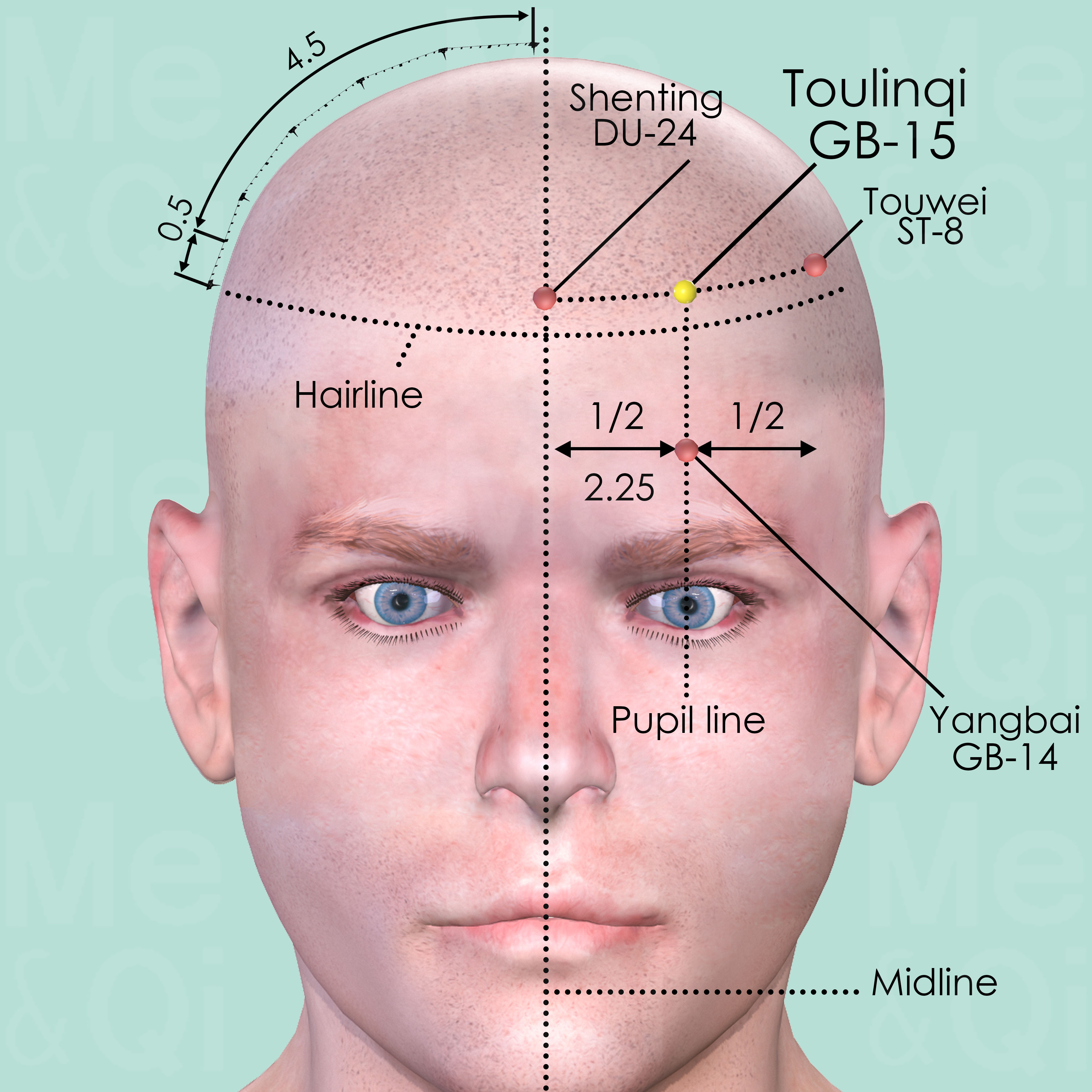
Toulinqi GB-15
Directly above Yangbai GB-14, on the pupil line, 0.5 cun within the hairline, midway between Shenting DU-24 and Touwei ST-8.
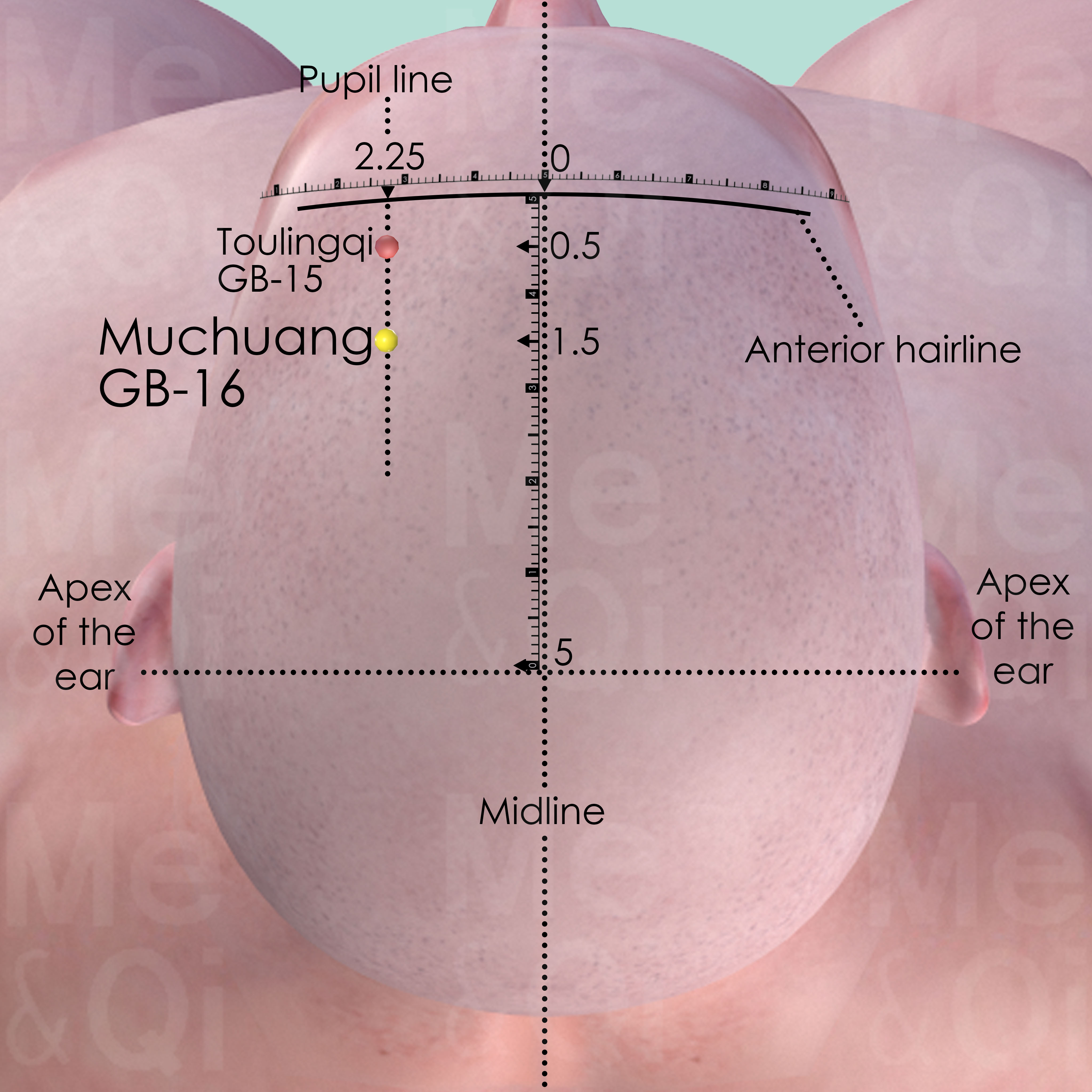
Muchuang GB-16
1 cun posterior to the Toulingqi GB-15 or 1.5 cun posterior to the anterior hairline, on the pupil line which is 2.25 cun lateral to the midline.
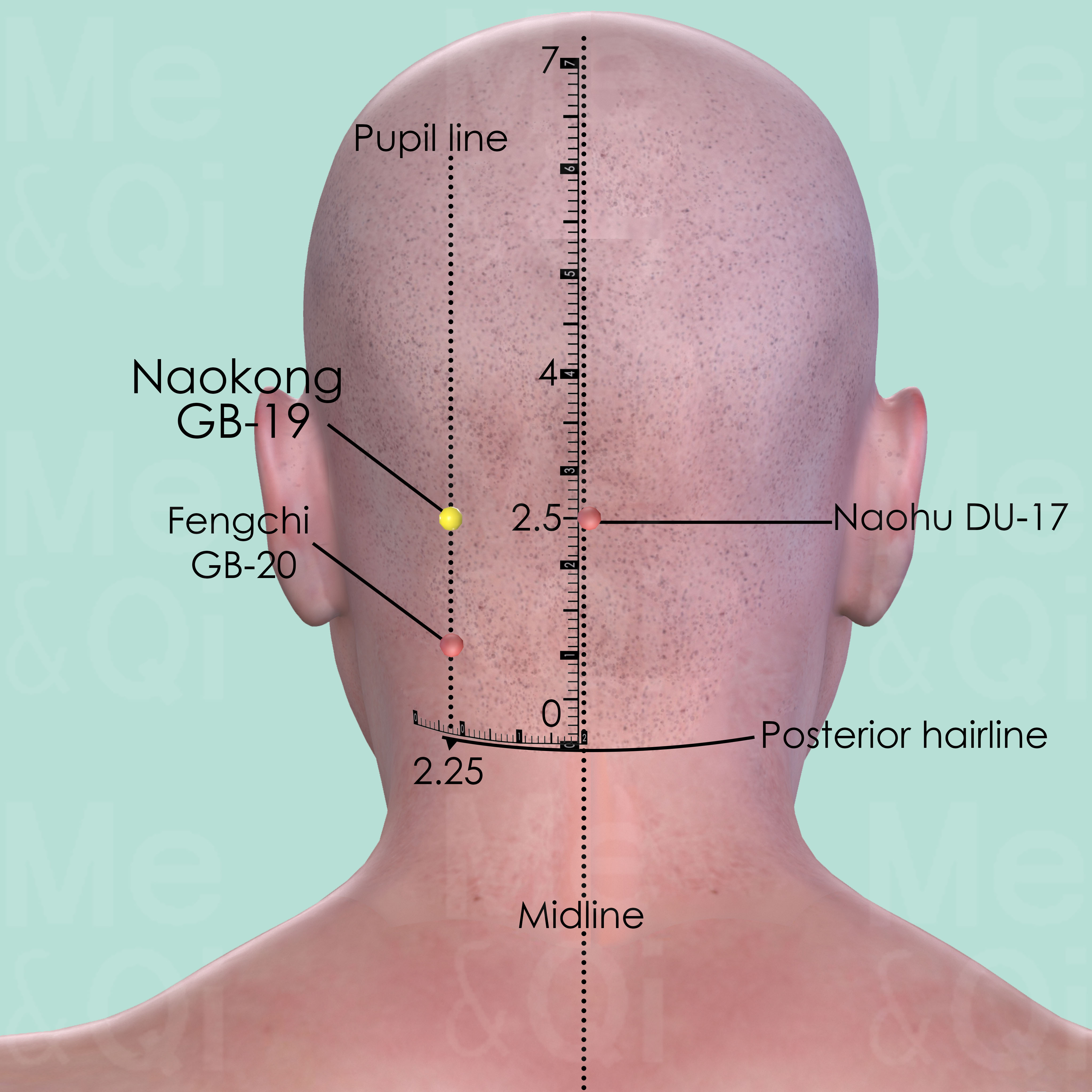
Naokong GB-19
Directly above Fengchi GB-20, level with Naohu DU-17, on the lateral side of the external occipital protuberance.
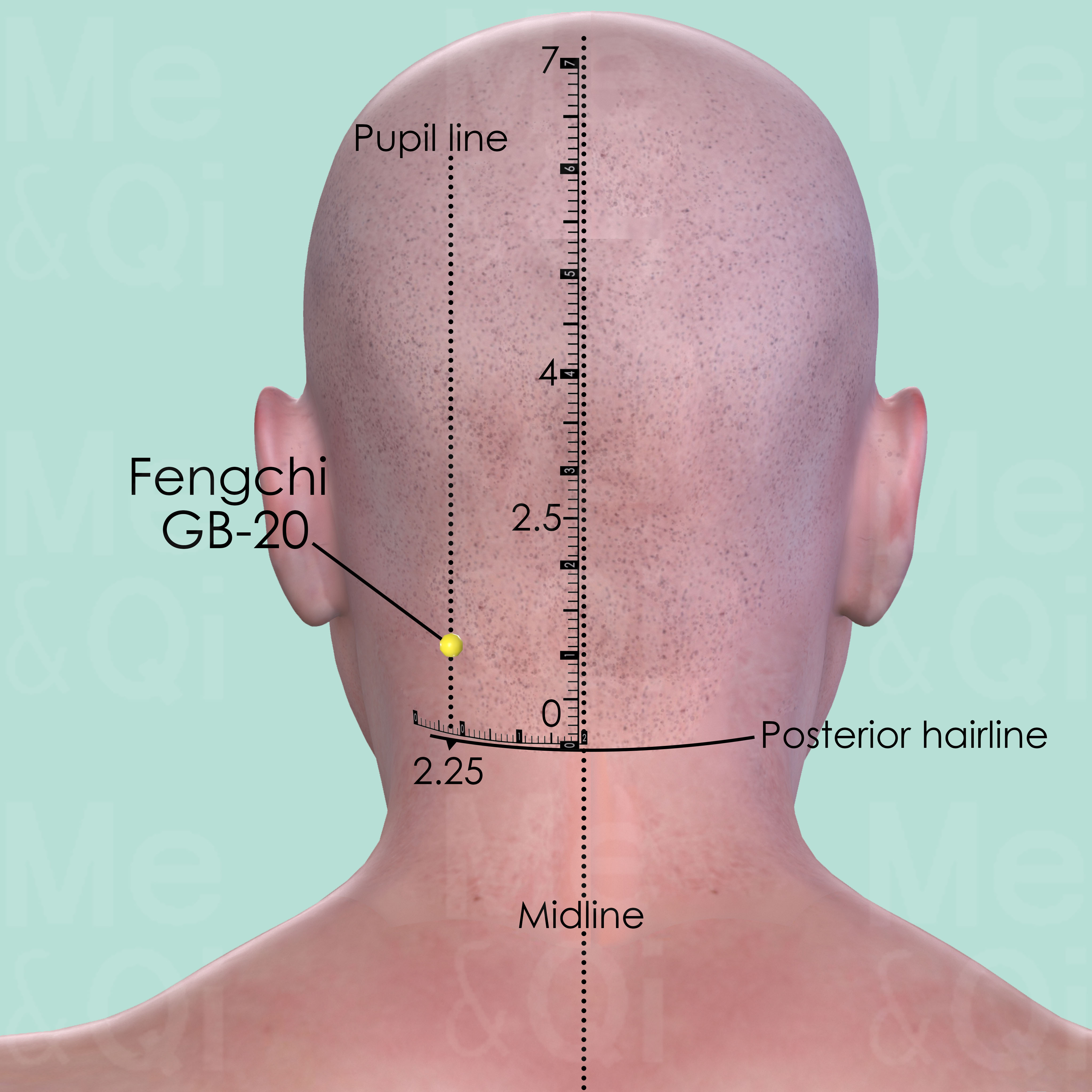
Fengchi GB-20
In the posterior aspect of the neck, below the occipital bone, in the depression between the upper portion of sternocleidomastoid and trapezius muscle.
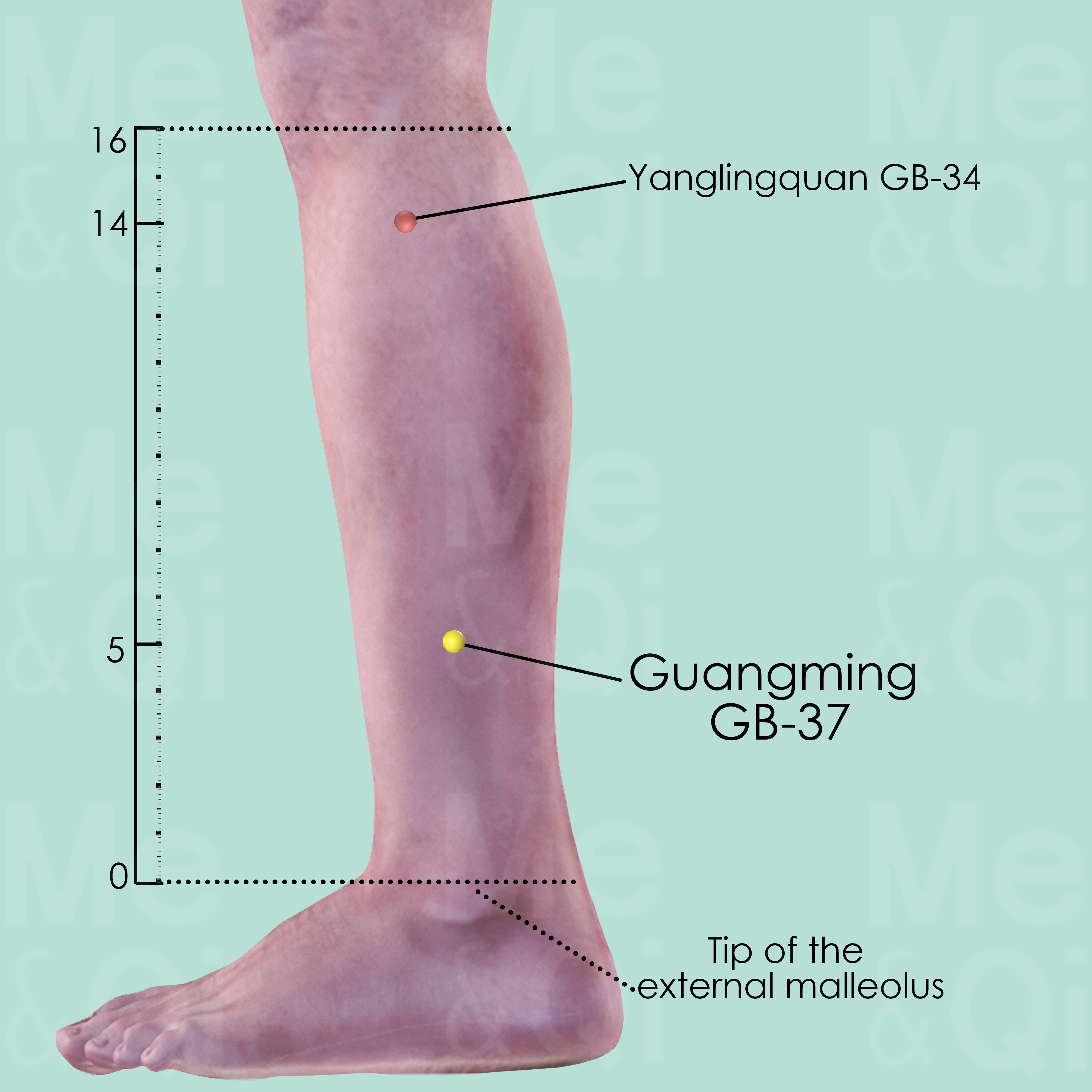
Guangming GB-37
5 cun directly above the tip of the external malleolus, on the anterior border of the fibula.
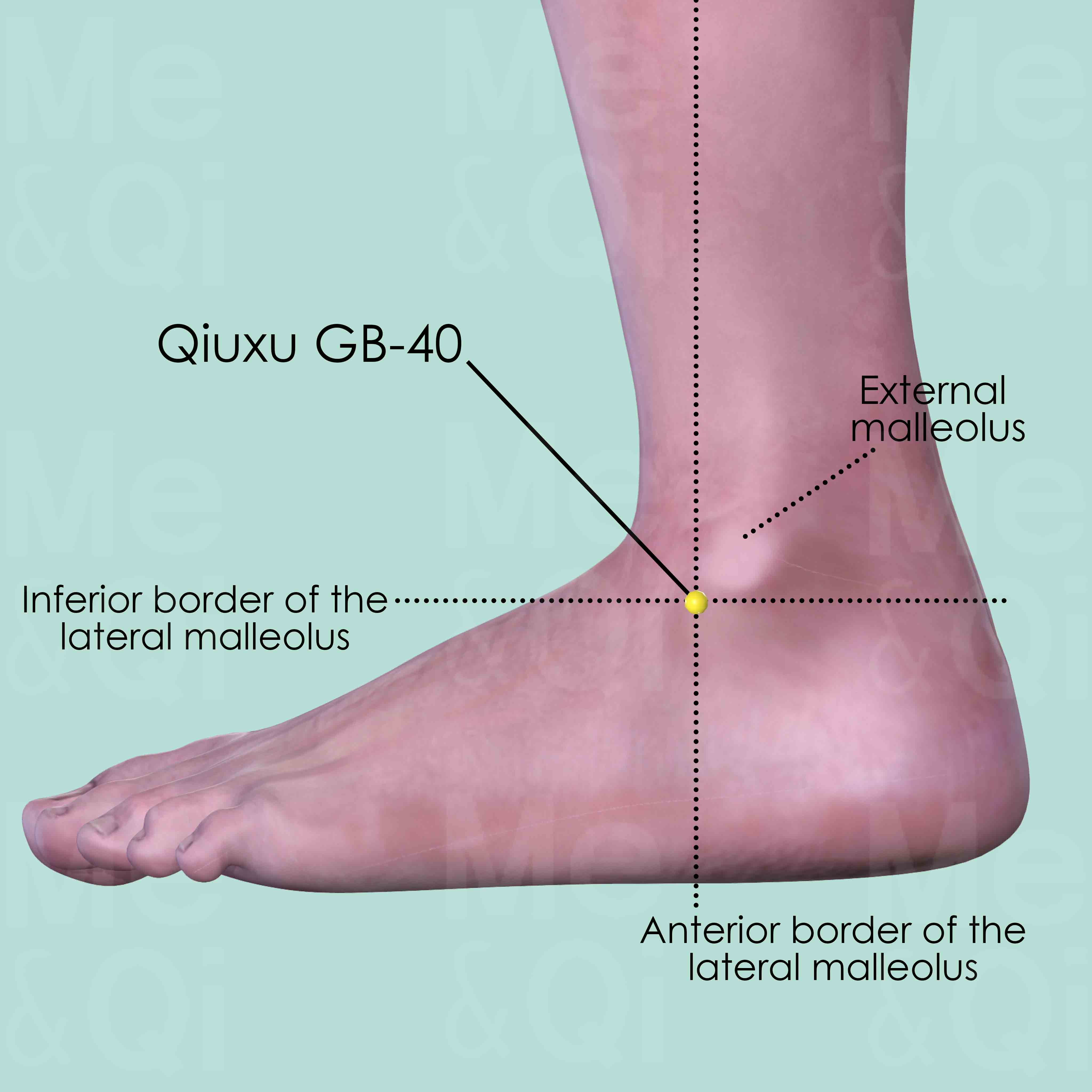
Qiuxu GB-40
Anterior and inferior to the external malleolus, in the depression on the lateral side of the tendon of extensor digitorum longus muscle that goes to the little toe.
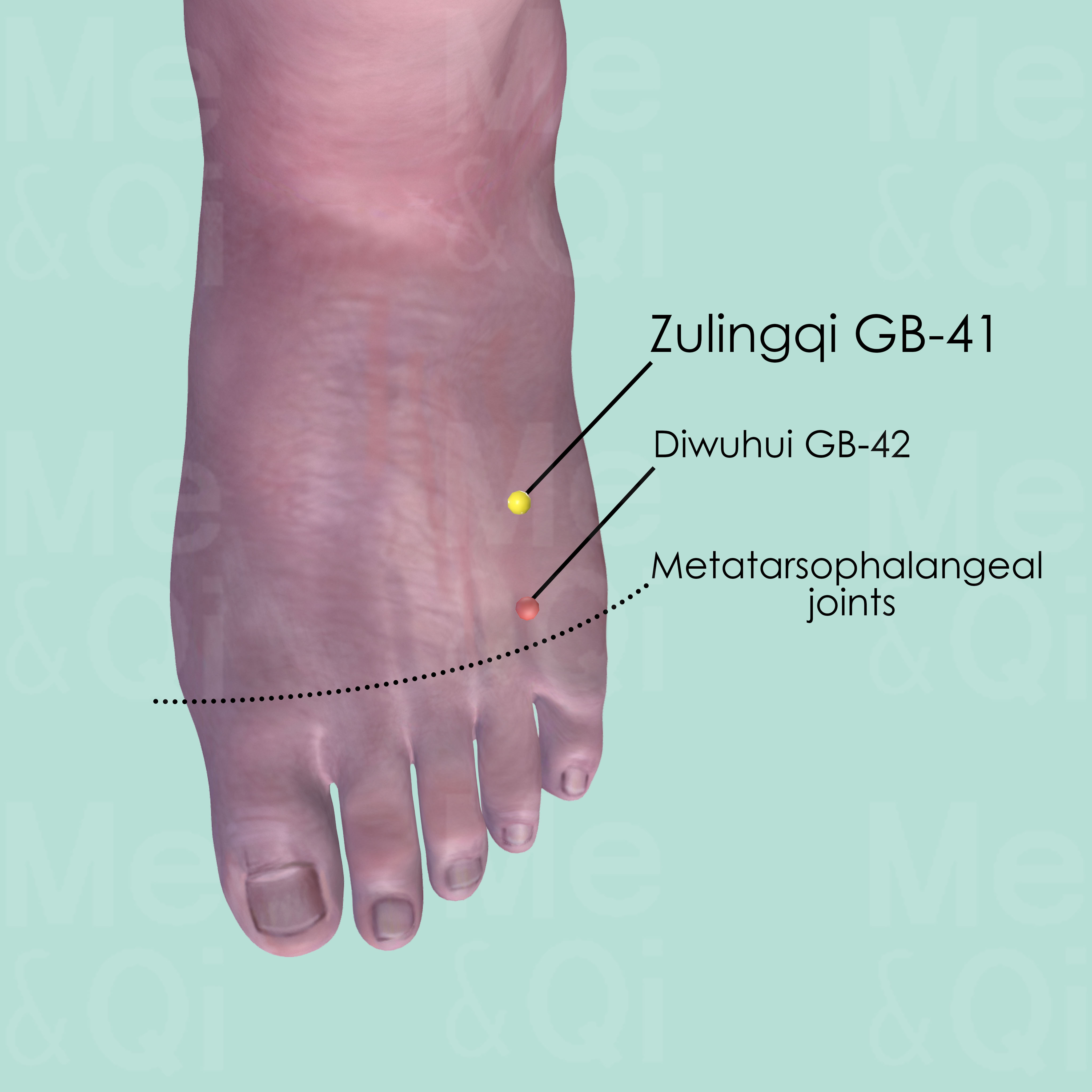
Zulingqi GB-41
In the depression distal to the junction of the 4th and 5th metatarsal bones, on the lateral side of the tendon of extensor digitorum longus muscle of the foot.
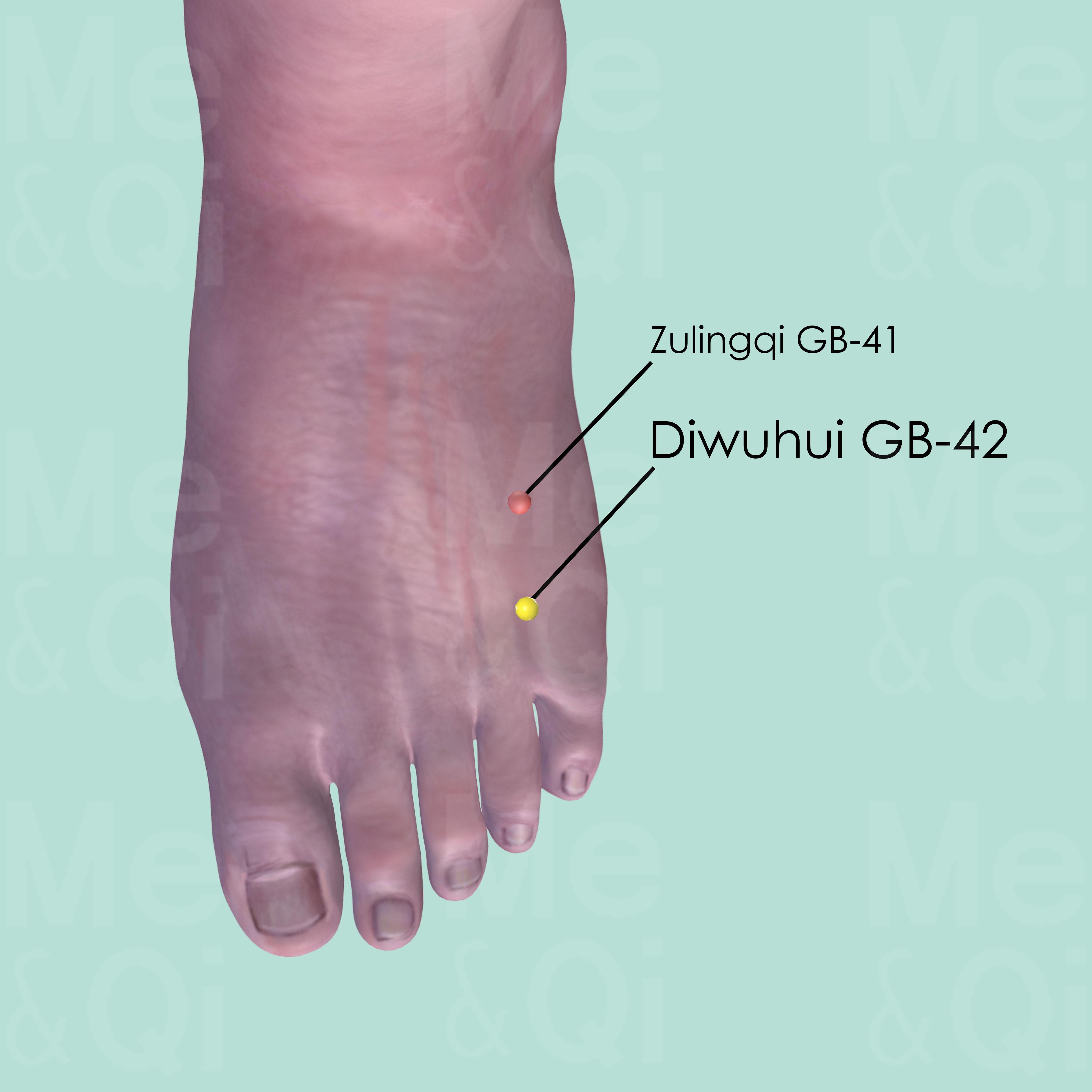
Diwuhui GB-42
Between the 4th and 5th metatarsal bones, on the medial side of the tendon of extensor digitorum longus muscle of the little toe.
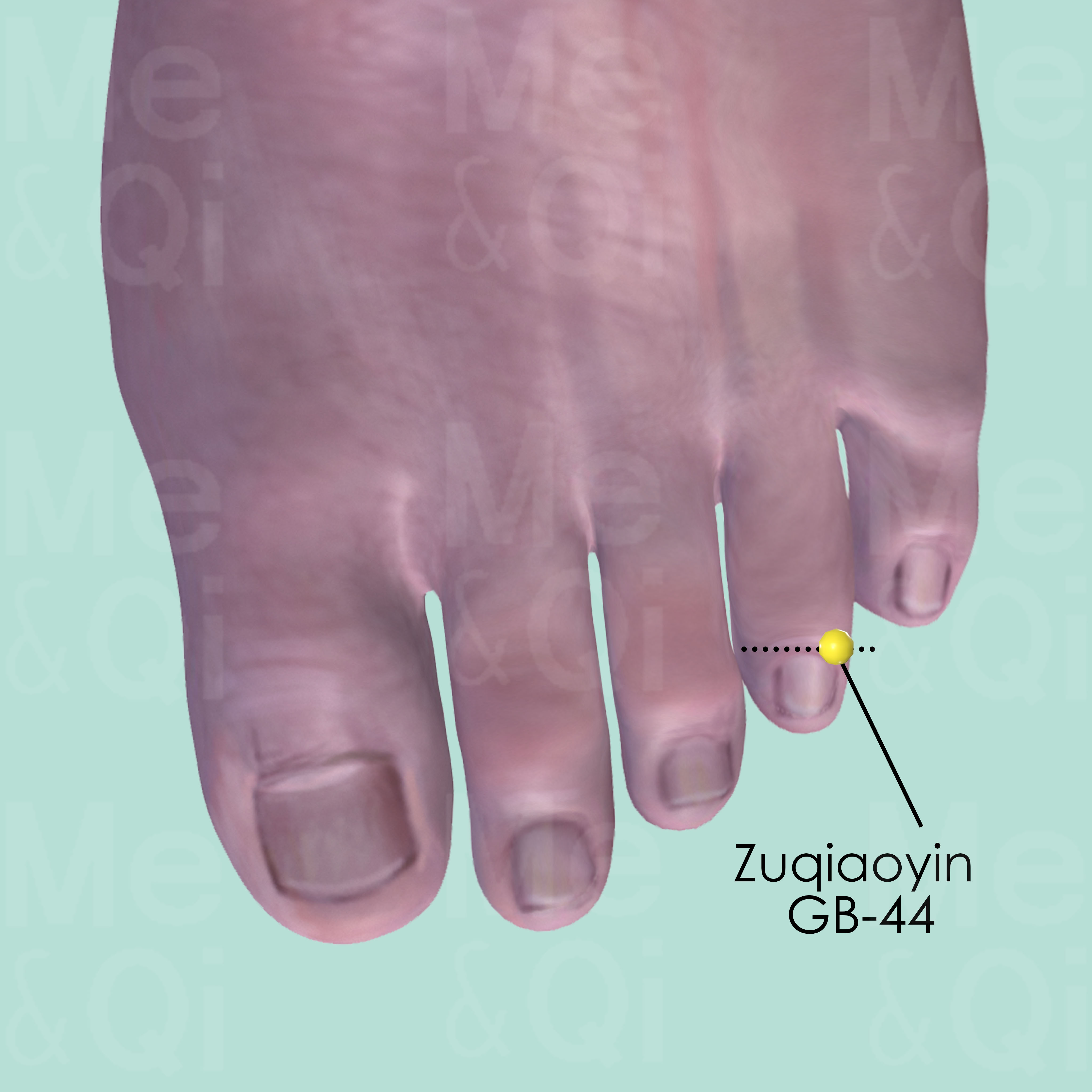
Zuqiaoyin GB-44
On the lateral side of the 4th toe, about 0.1 cun posterior to the corner of the nail.
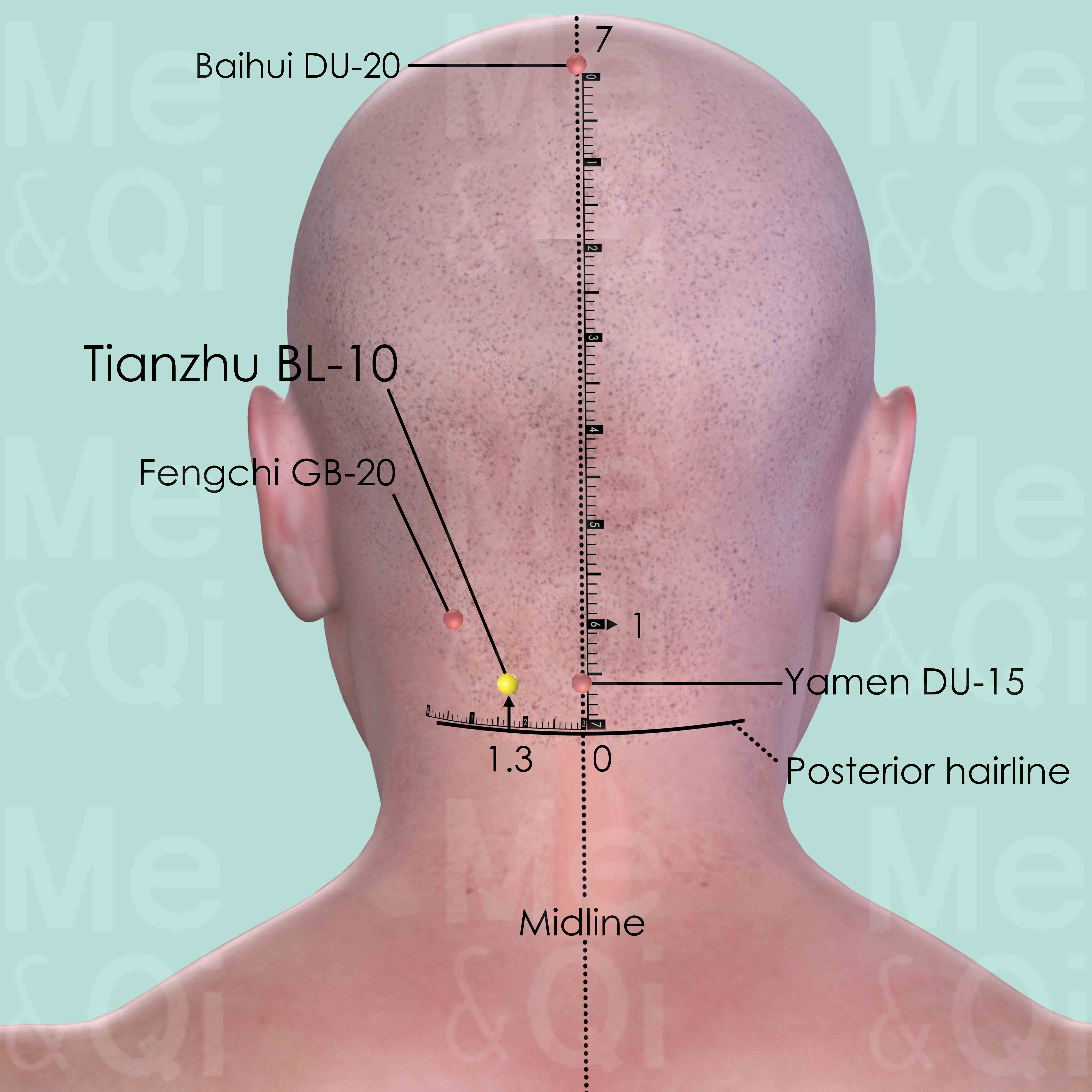
Tianzhu BL-10
1.3 cun lateral to Yamen DU-15 on the posterior midline, 0.5 cun above the posterior hairline, on the lateral side of trapezius muscle.
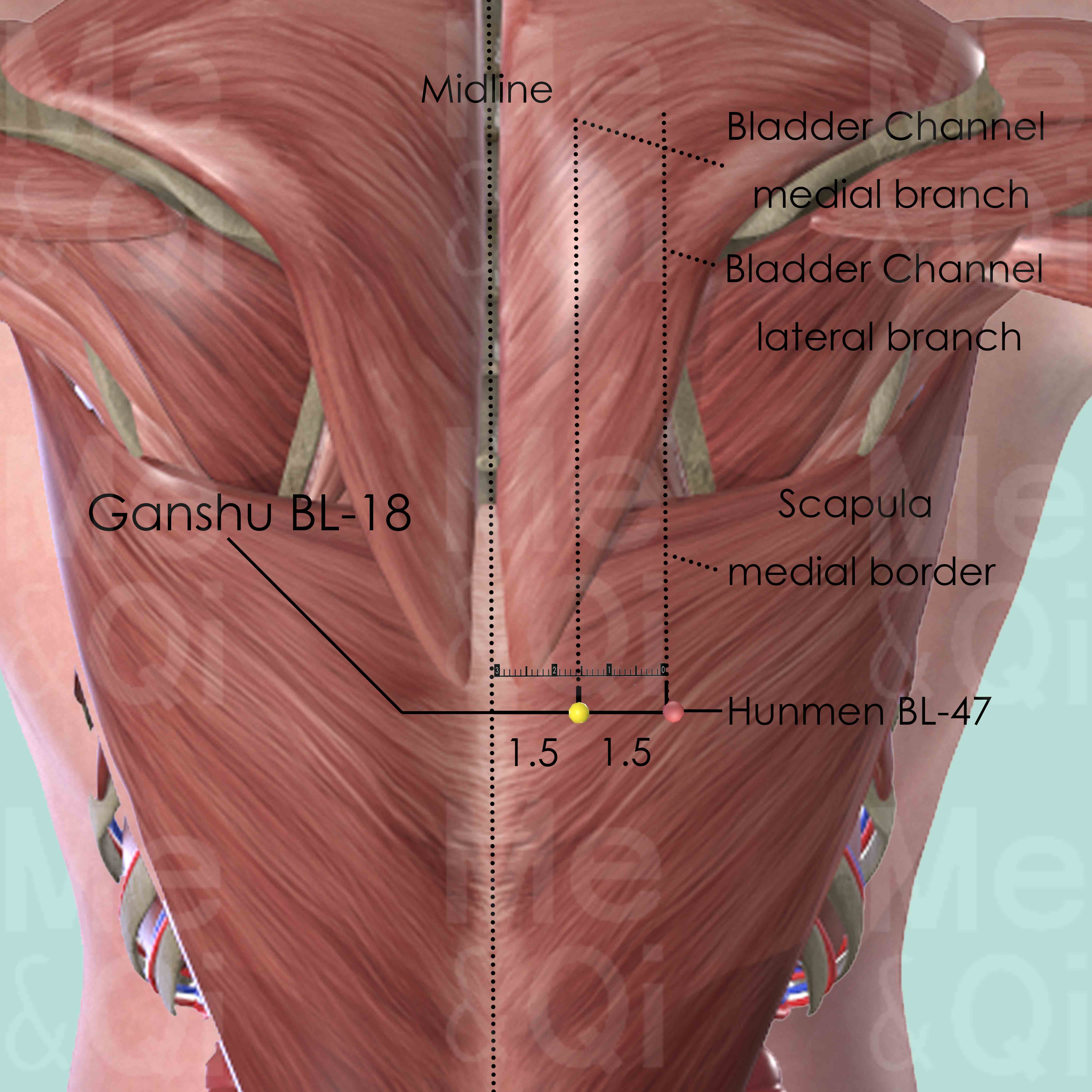
Ganshu BL-18
1.5 cun lateral to the lower border of the spinous process of the 9th thoracic vertebra (T9).
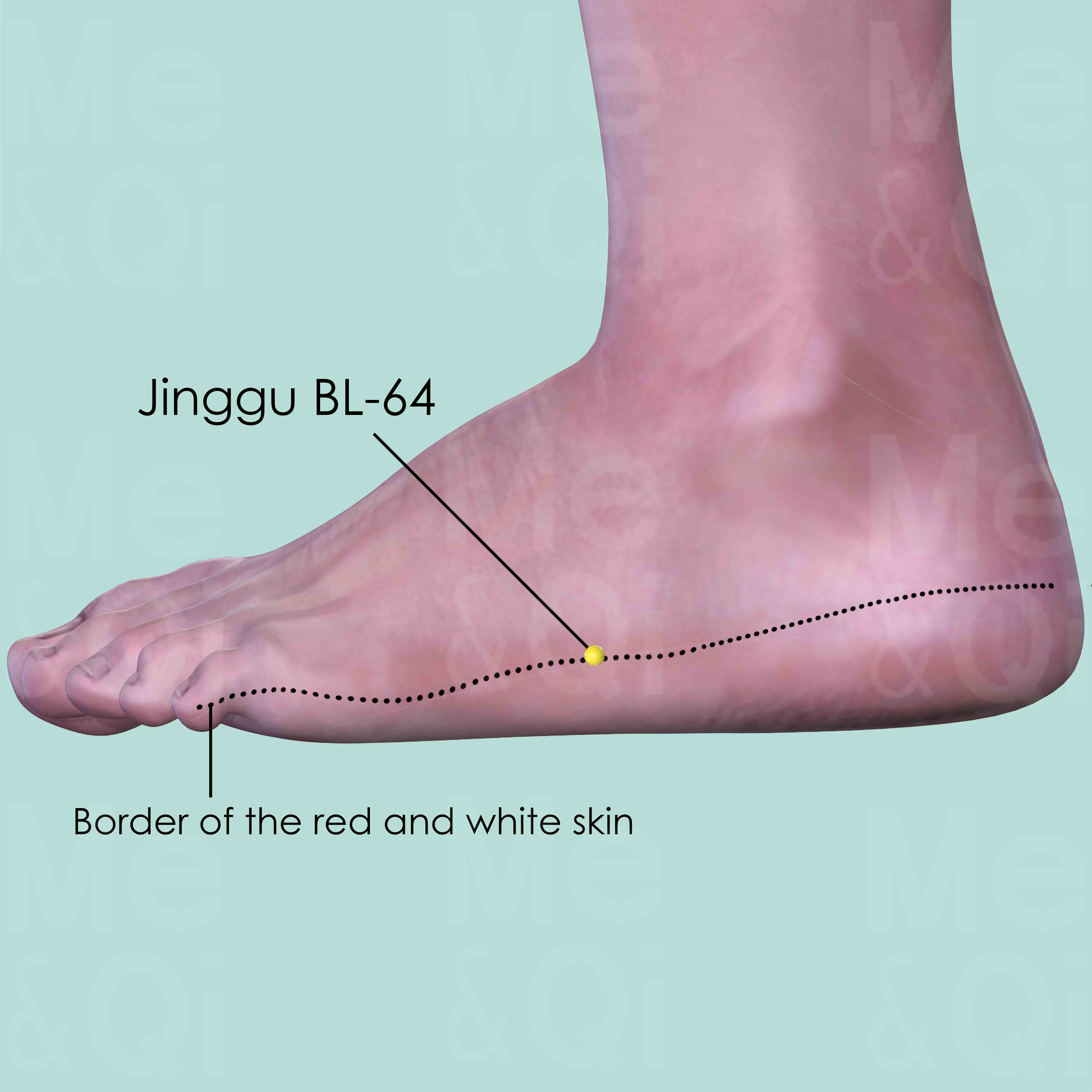
Jinggu BL-64
On the lateral side of the foot dorsum, below the tuberosity of the 5th metatarsal bone, at the border of the red and white skin.
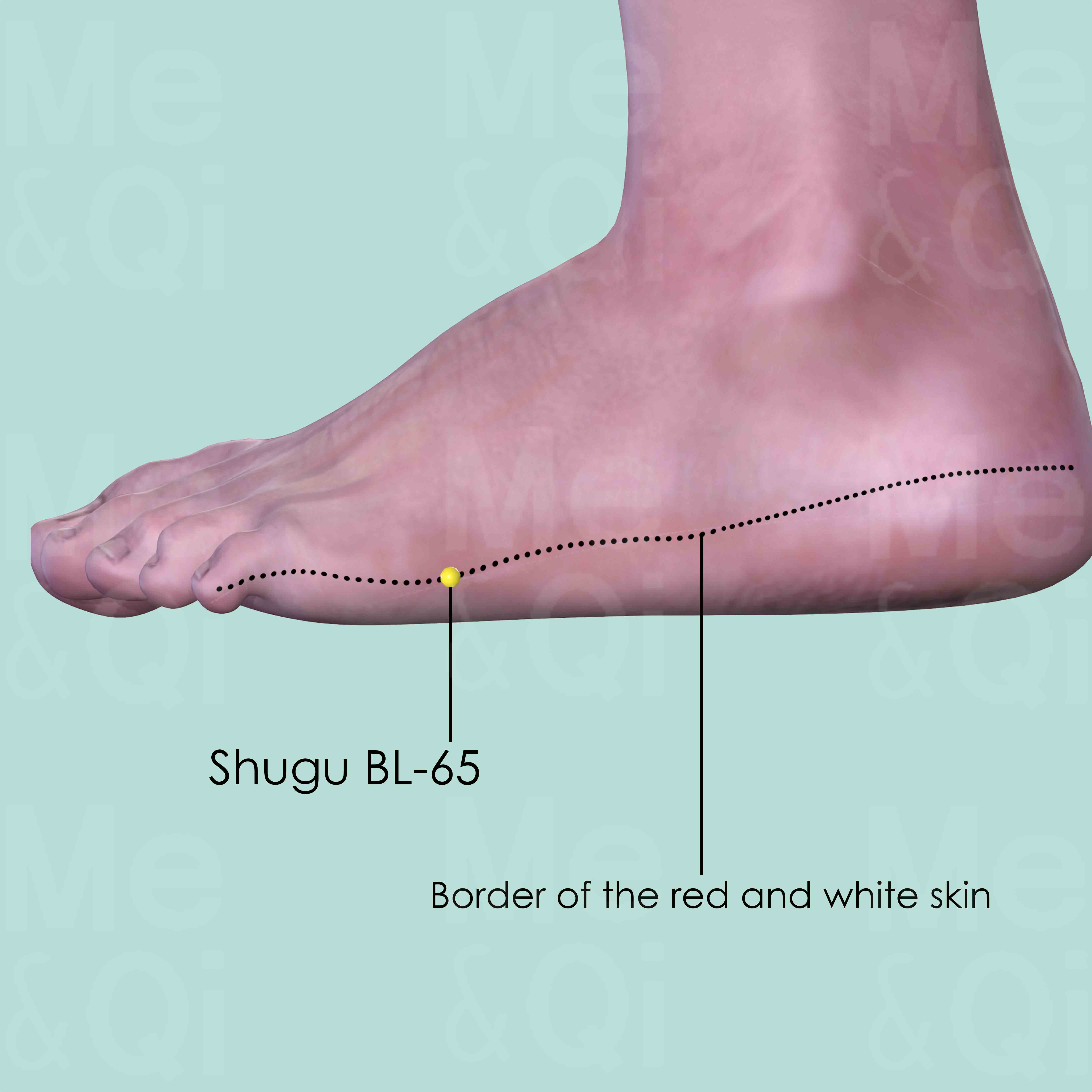
Shugu BL-65
On the lateral side of the foot dorsum, proximal to the head of the 5th metatarsal bone, at the border of the red and white skin.
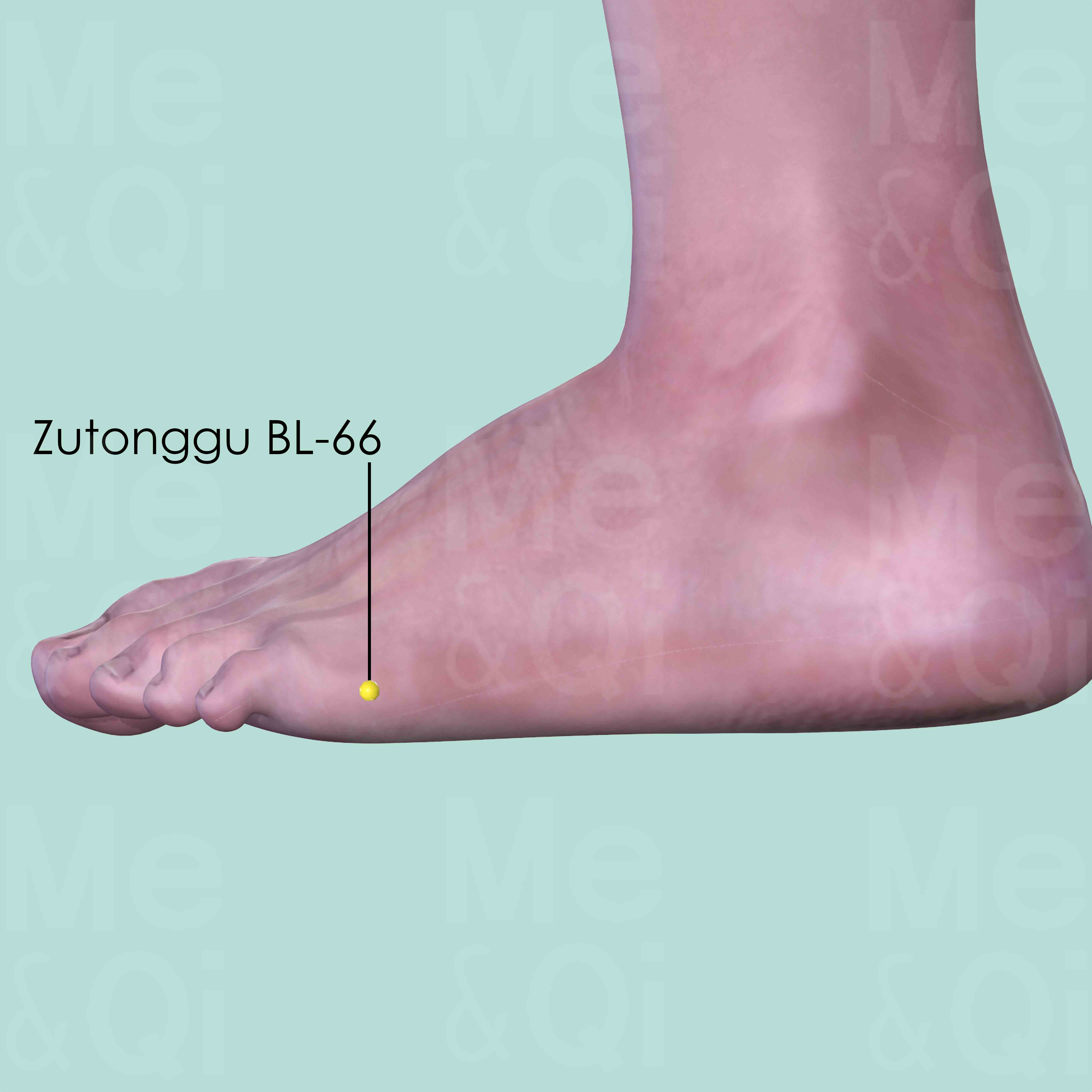
Zutonggu BL-66
In the depression distal and inferior to the 5th metatarsophalangeal joint, at the lateral border of the foot.
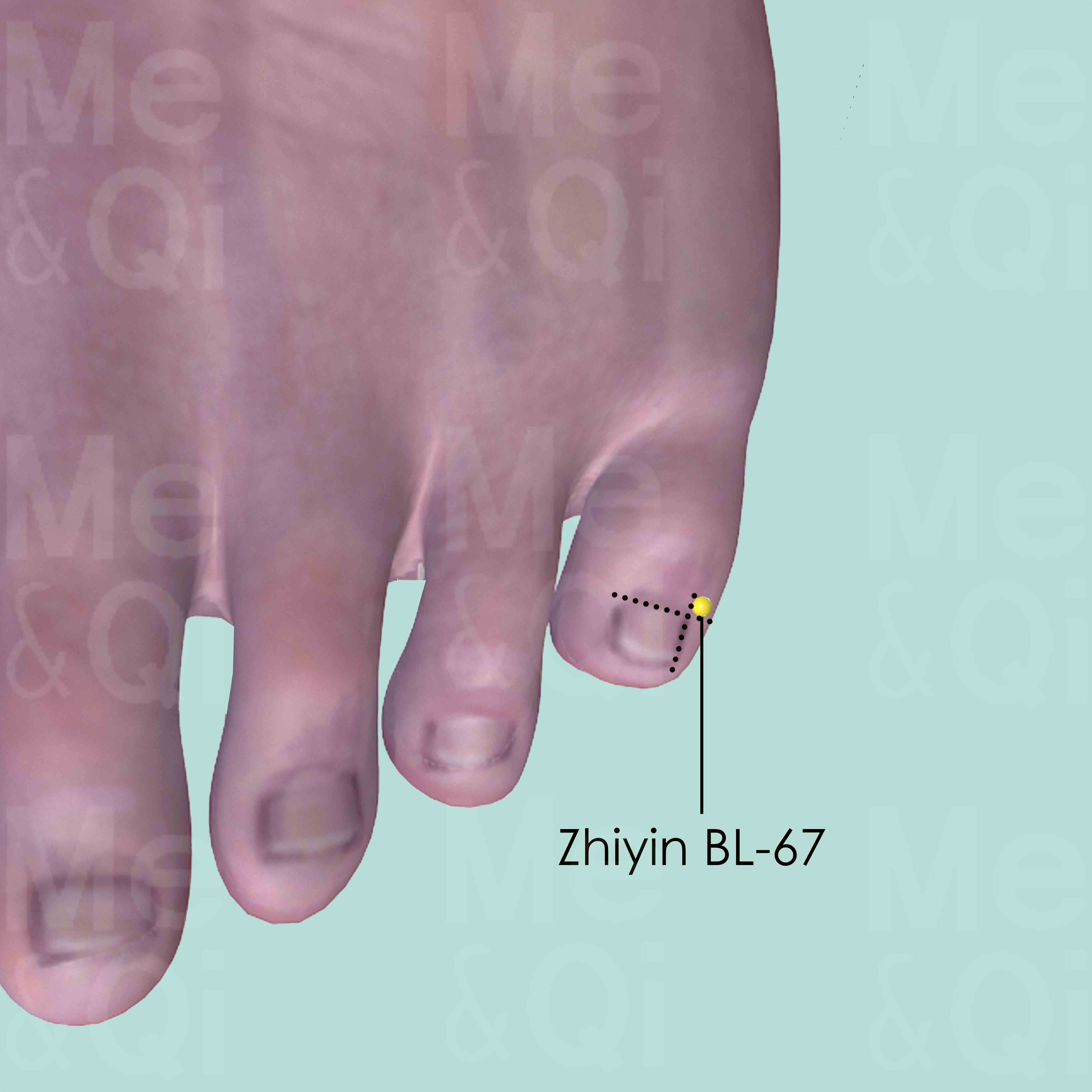
Zhiyin BL-67
On the lateral side of the little toe, about 0.1 cun posterior to the corner of the nail.
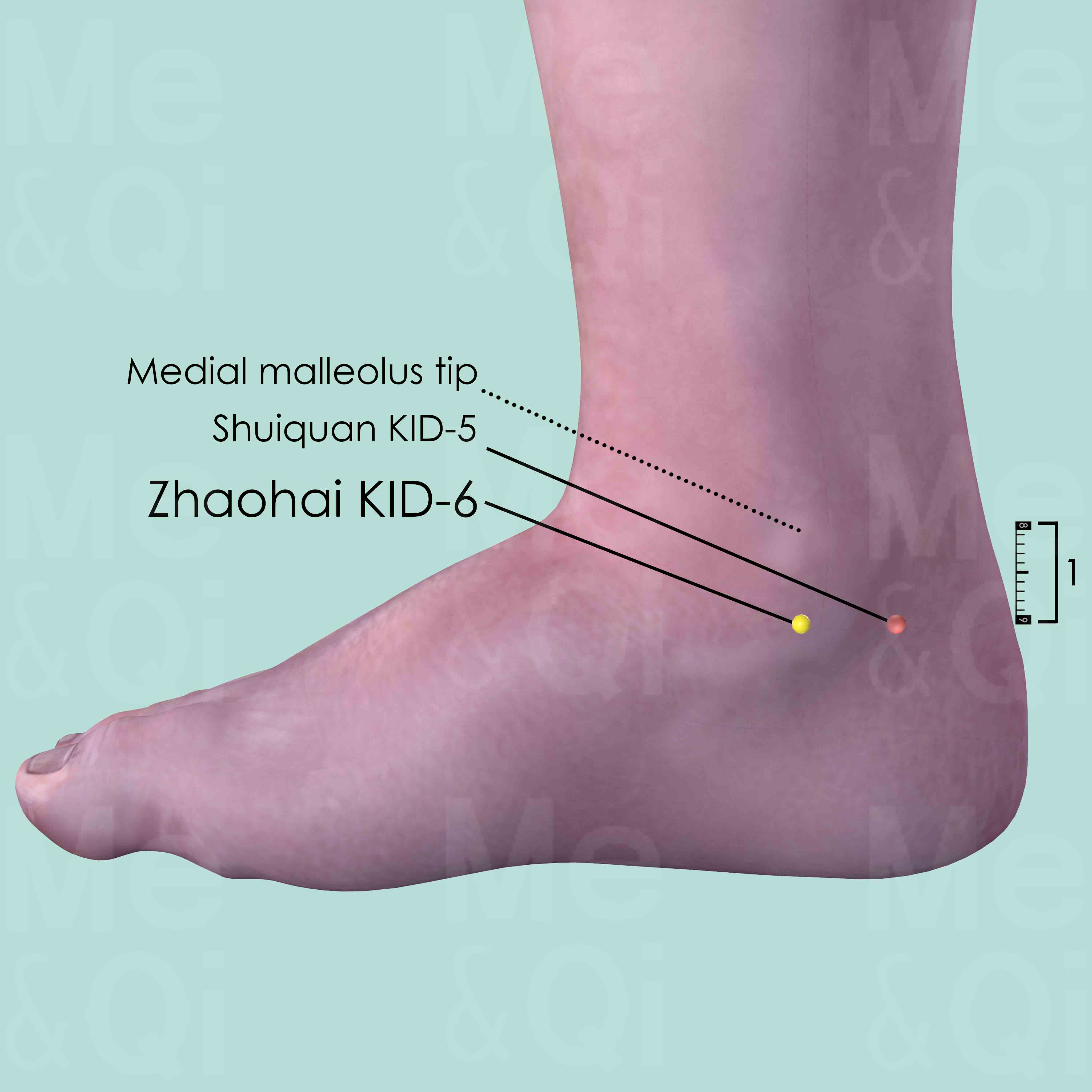
Zhaohai KID-6
Approximately 1 cun below the medial malleolus tip, over the joint space between the talus and the calcaneus.
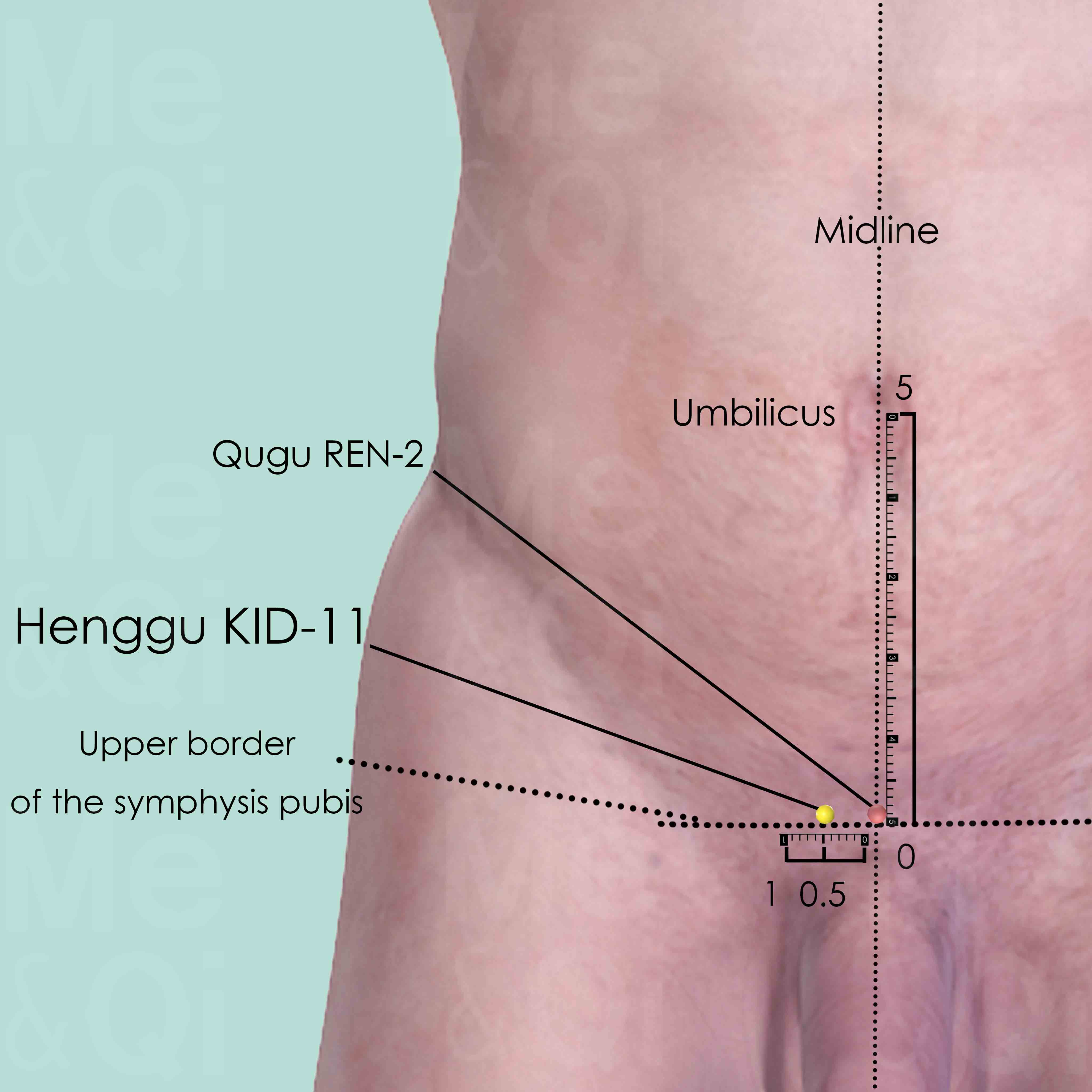
Henggu KID-11
5 cun below the umbilicus, on the upper border of symphysis pubis, 0.5 cun lateral to the anterior midline. It is at the same level as Qugu REN-2 which is at the anterior midline.
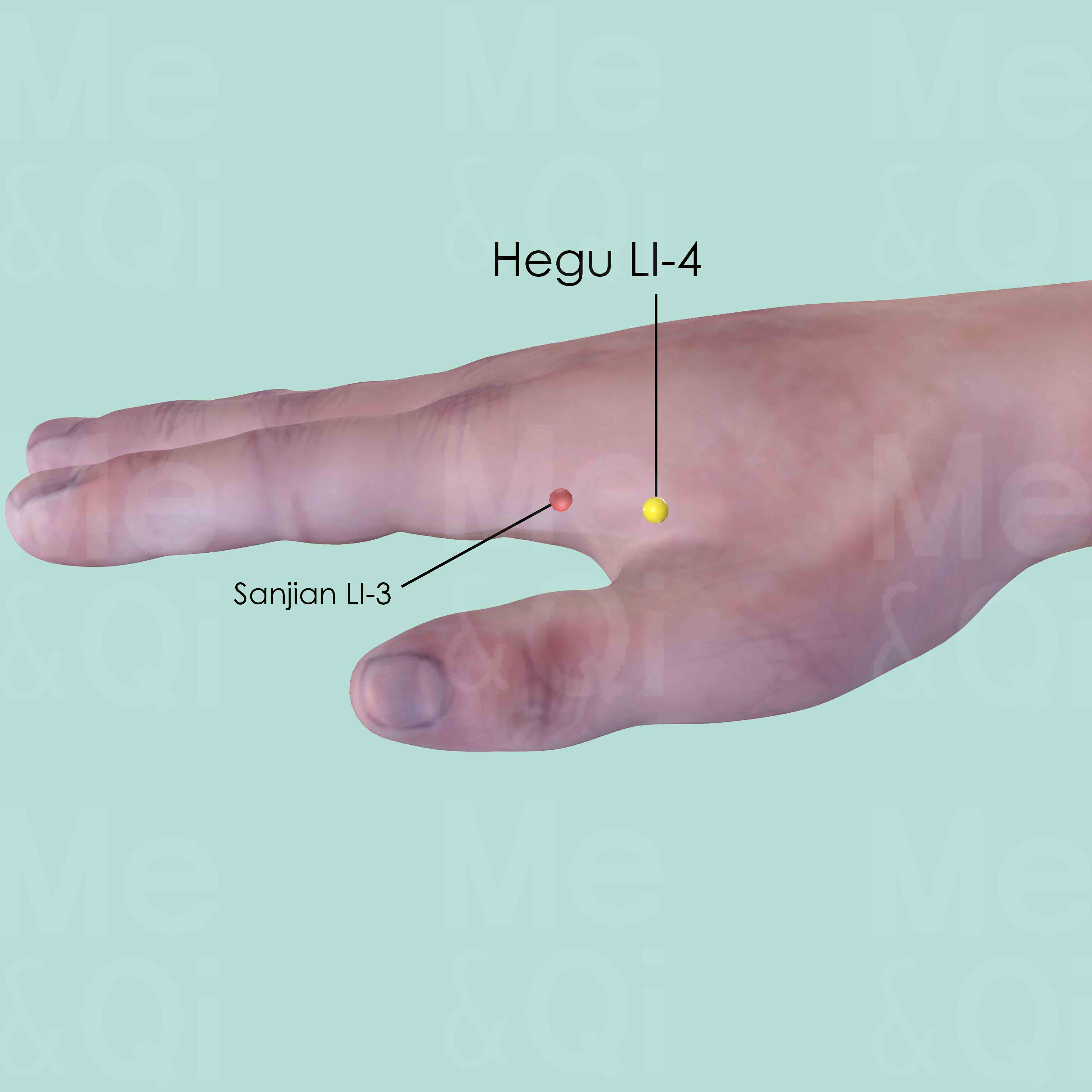
Hegu LI-4
Between the 1st and 2nd metacarpal bones, approximately in the middle of the 2nd metacarpal bone on the radial side.
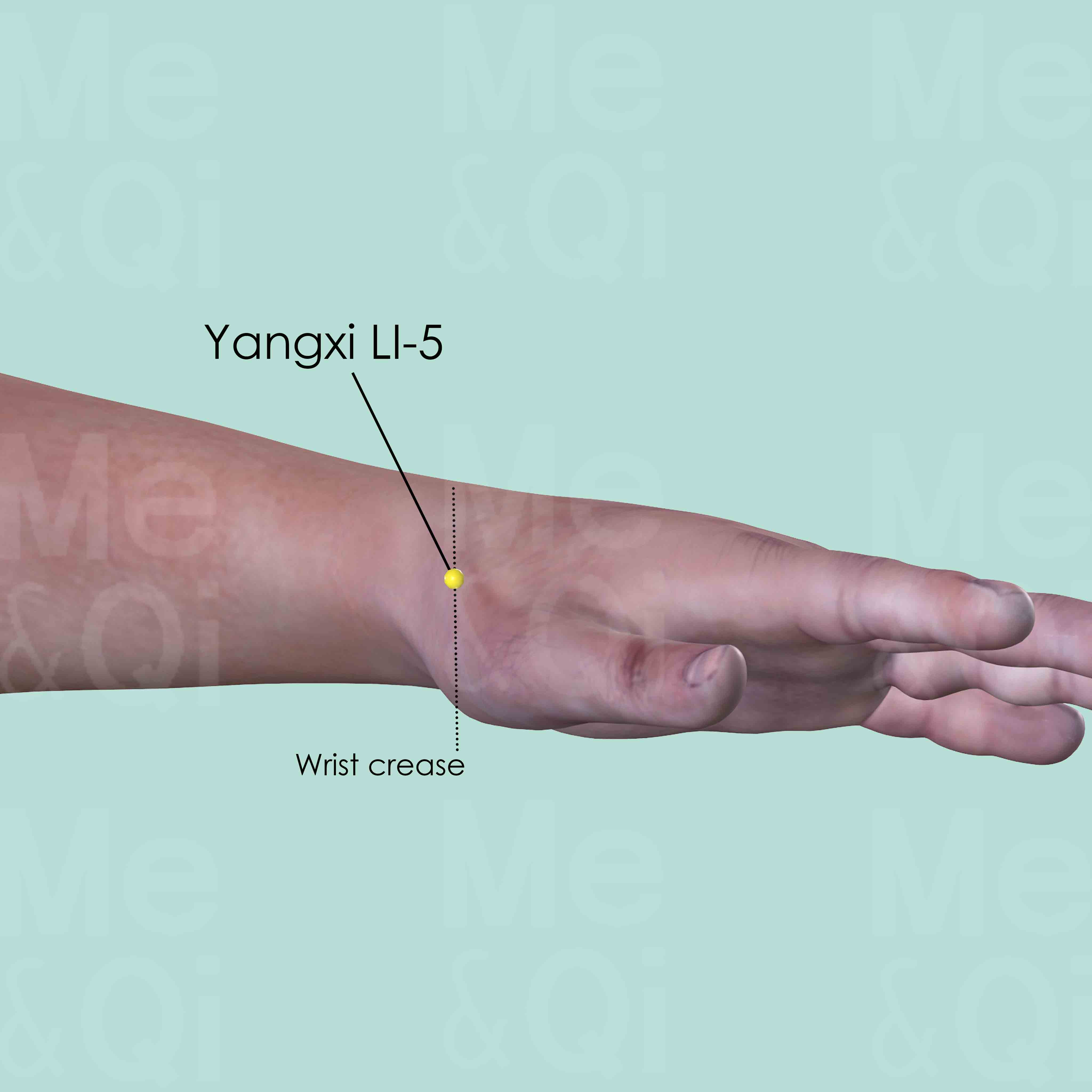
Yangxi LI-5
On the radial side of the wrist. When the thumb is tilted upward, it is in the depression on the wrist joint space (wrist crease) between the tendons of extensor pollicis longus and brevis muscles.
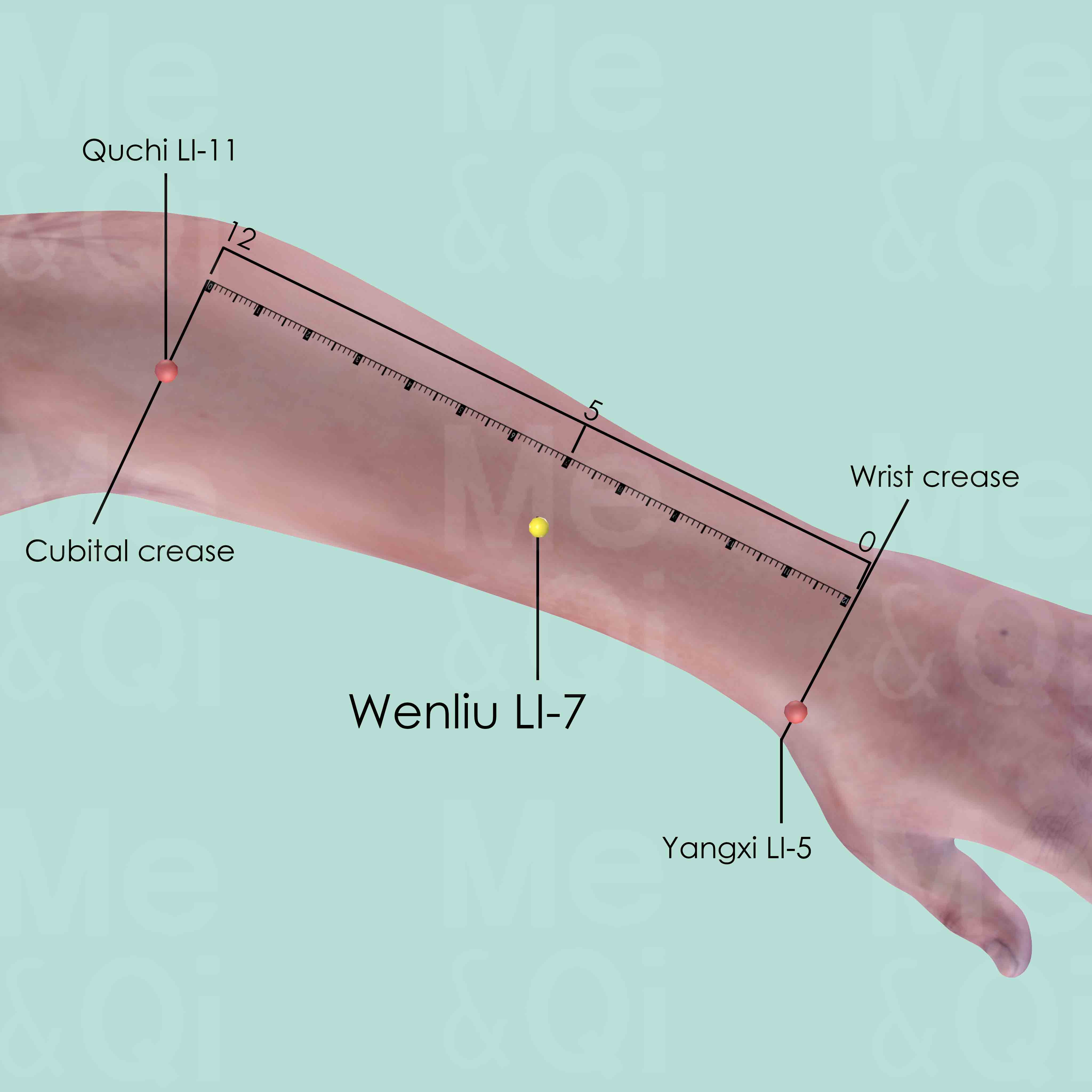
Wenliu LI-7
When a fist is made, with the ulnar side downward and elbow flexed, the point is 5 cun above Yangxi LI-5 at the wrist crease, 1 cun distal to the midpoint of the line joining Yangxi LI-5 and Quchi LI-11.
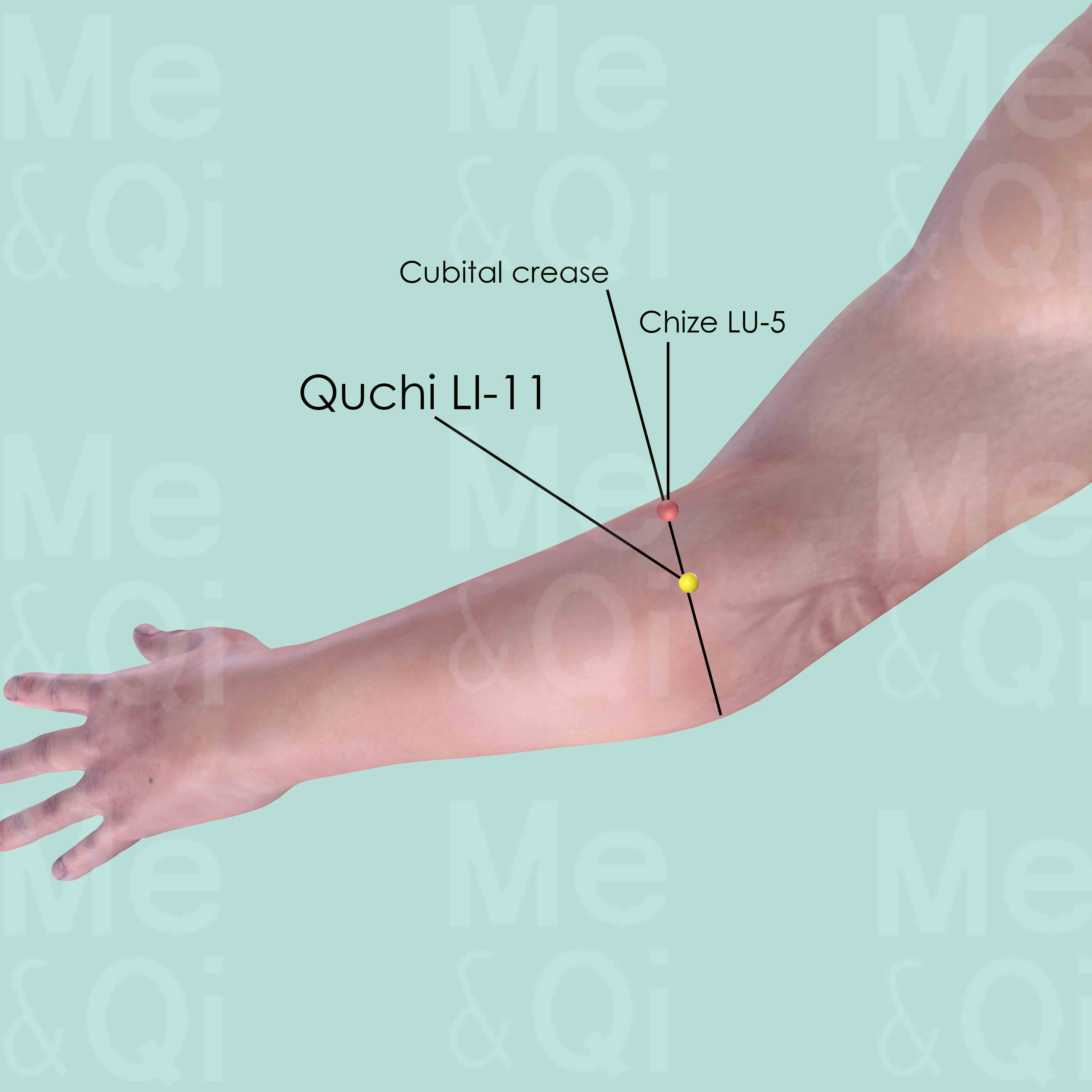
Quchi LI-11
When the elbow is flexed, Quchi LI-11 is in the depression at the lateral end of the cubital crease, midway between Chize LU-5 and the lateral epicondyle of the humerus.
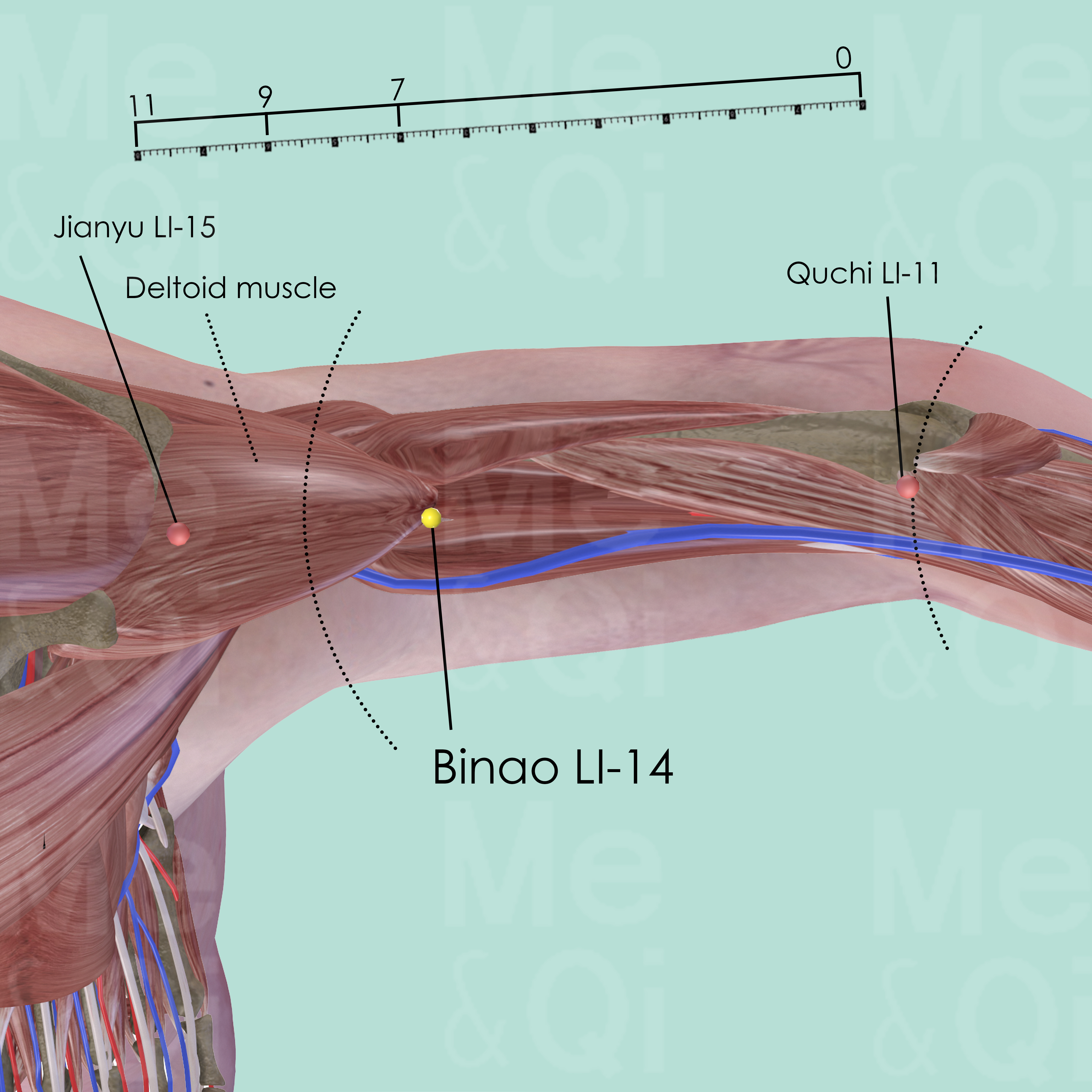
Binao LI-14
On the radial side of the humerus, superior to the lower end of deltoid muscle, on the line connecting Quchi LI-11 and Jianyu LI-15, 7 cun proximal to Quchi LI-11.
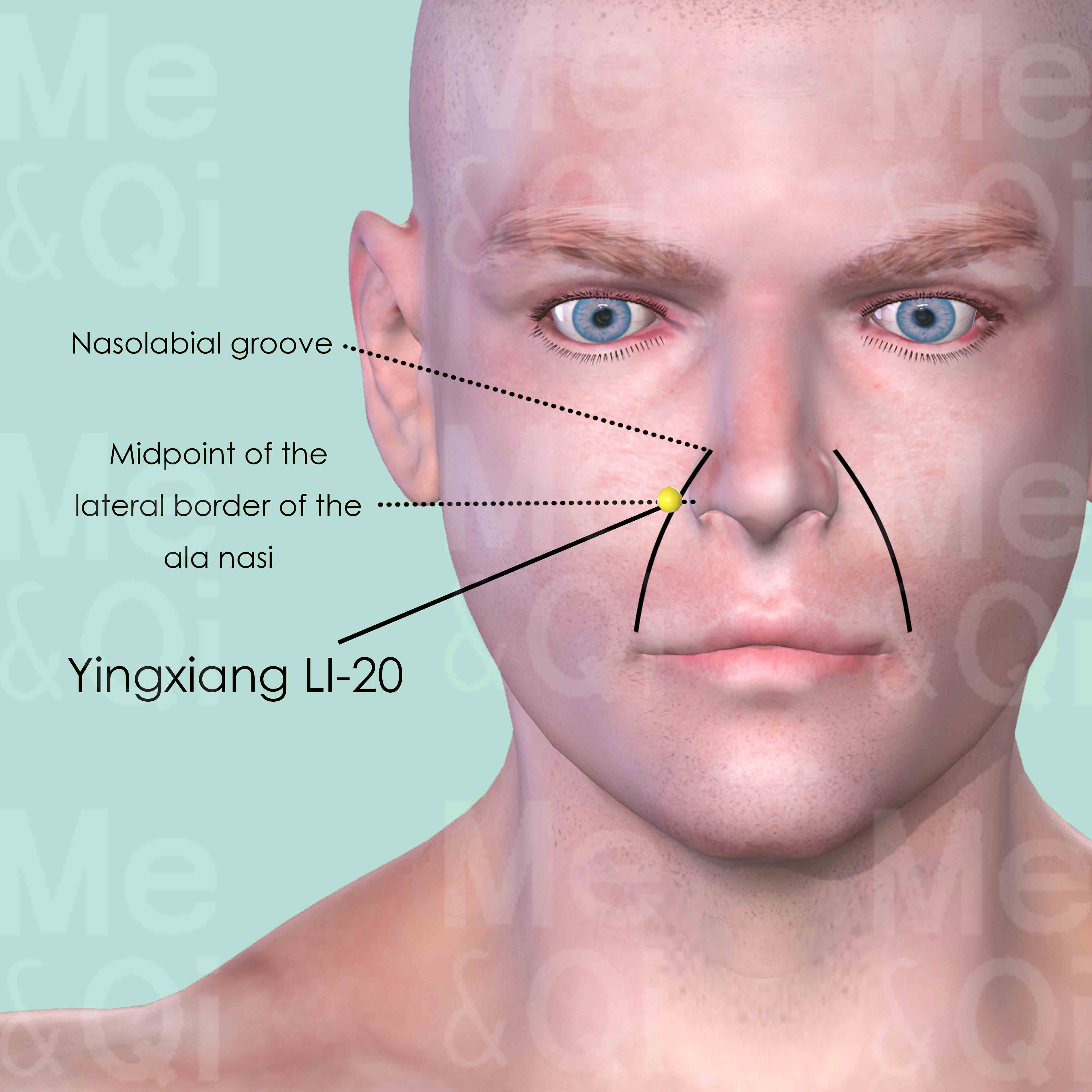
Yingxiang LI-20
In the nasolabrial groove, at the level of the midpoint of the lateral border of ala nasi.
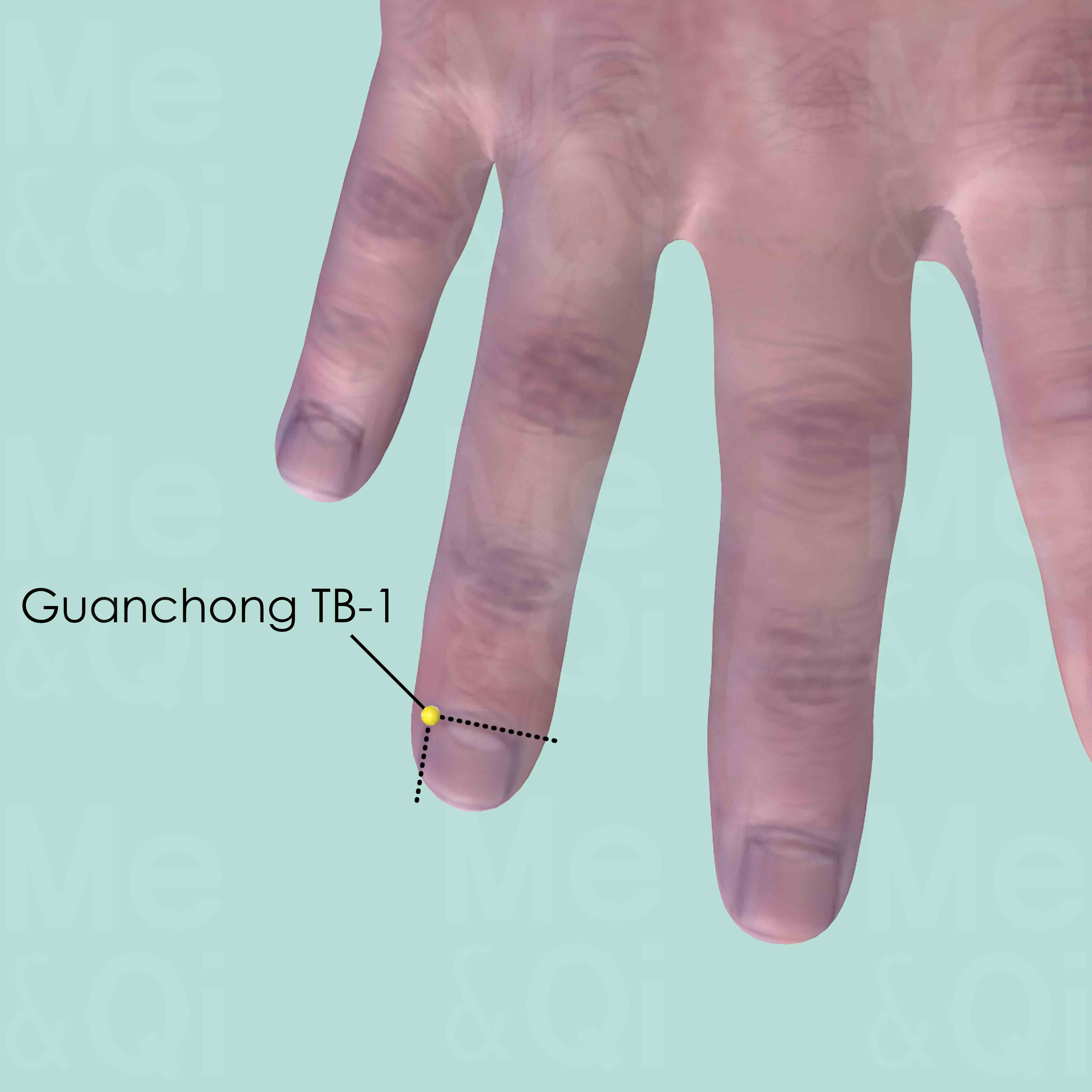
Guanchong TB-1
On the lateral side of the ring finger, about 0.1 cun posterior to the corner of the nail.
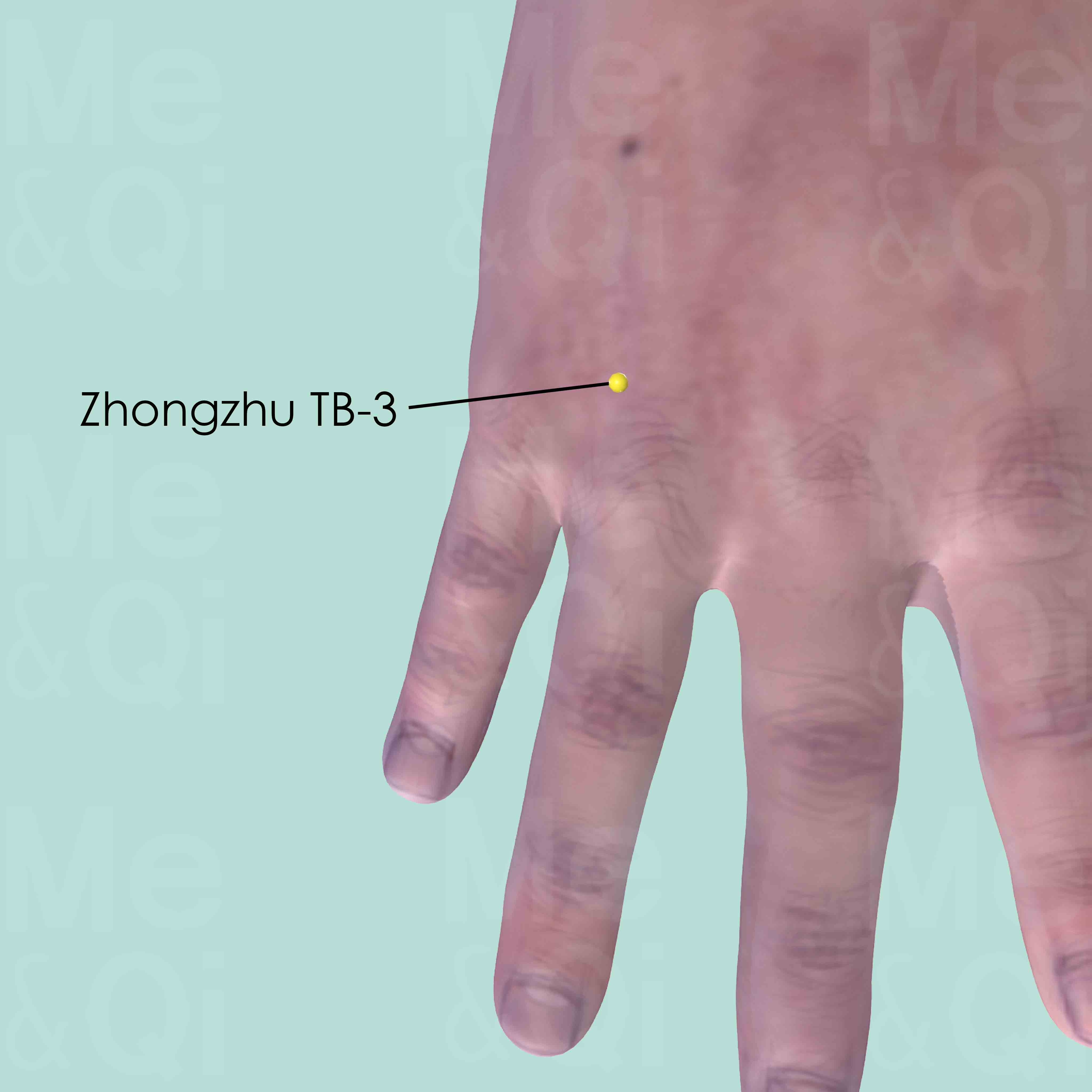
Zhongzhu TB-3
When the hand is placed with the palm facing downward, Zhongzhu TB-3 is on the hand dorsum between the 4th and 5th metacarpal bones, in the depression proximal to the metacarpophalangeal joints, at the junction between the heads and shaft of the two metacarpal bones.

Shaoze SI-1
On the ulnar side of the little finger, about 0.1 cun posterior to the corner of the nail.
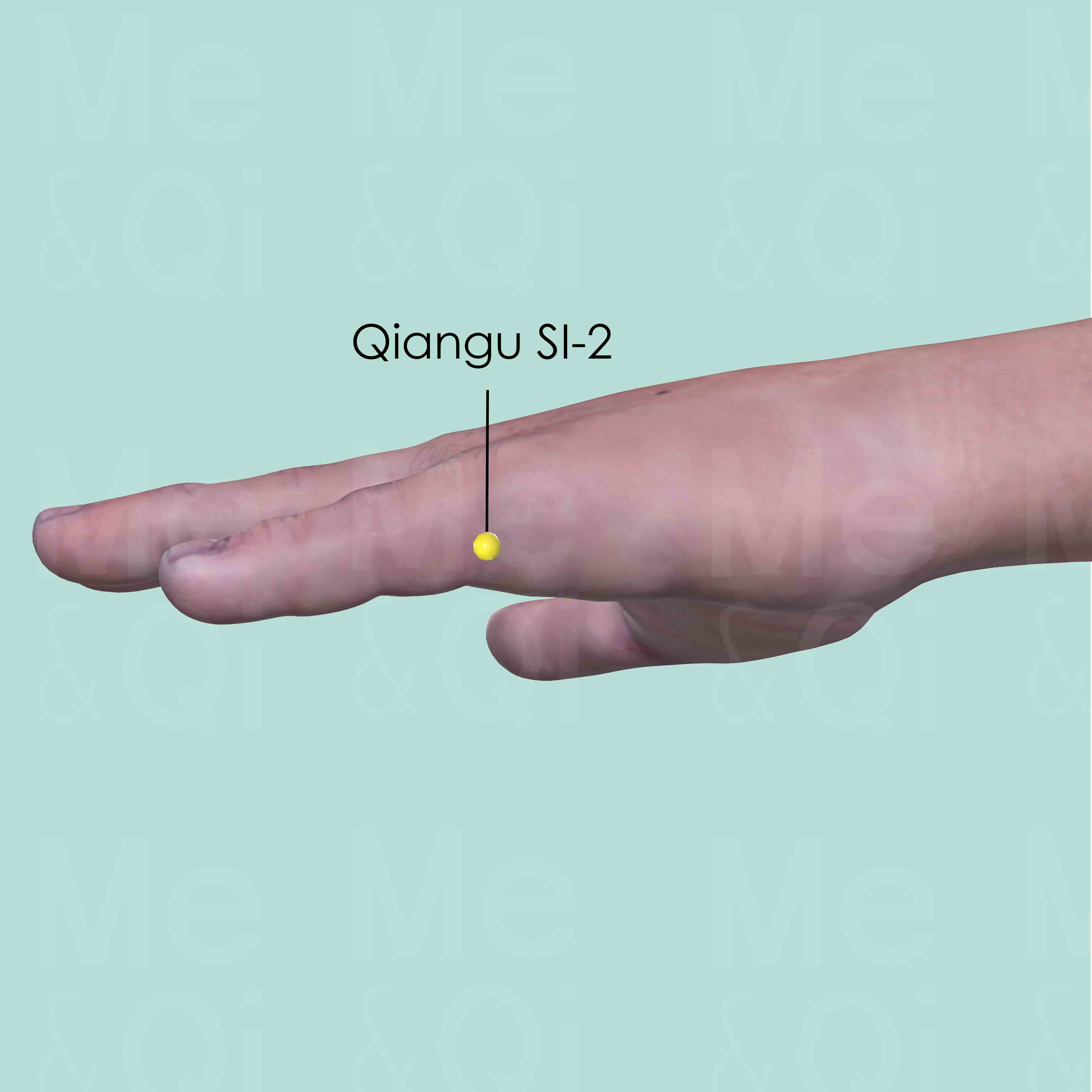
Qiangu SI-2
On the ulnar aspect of the little finger, distal to the metacarpophalangeal joint, at the junction of the shaft and the base of the proximal phalanx.
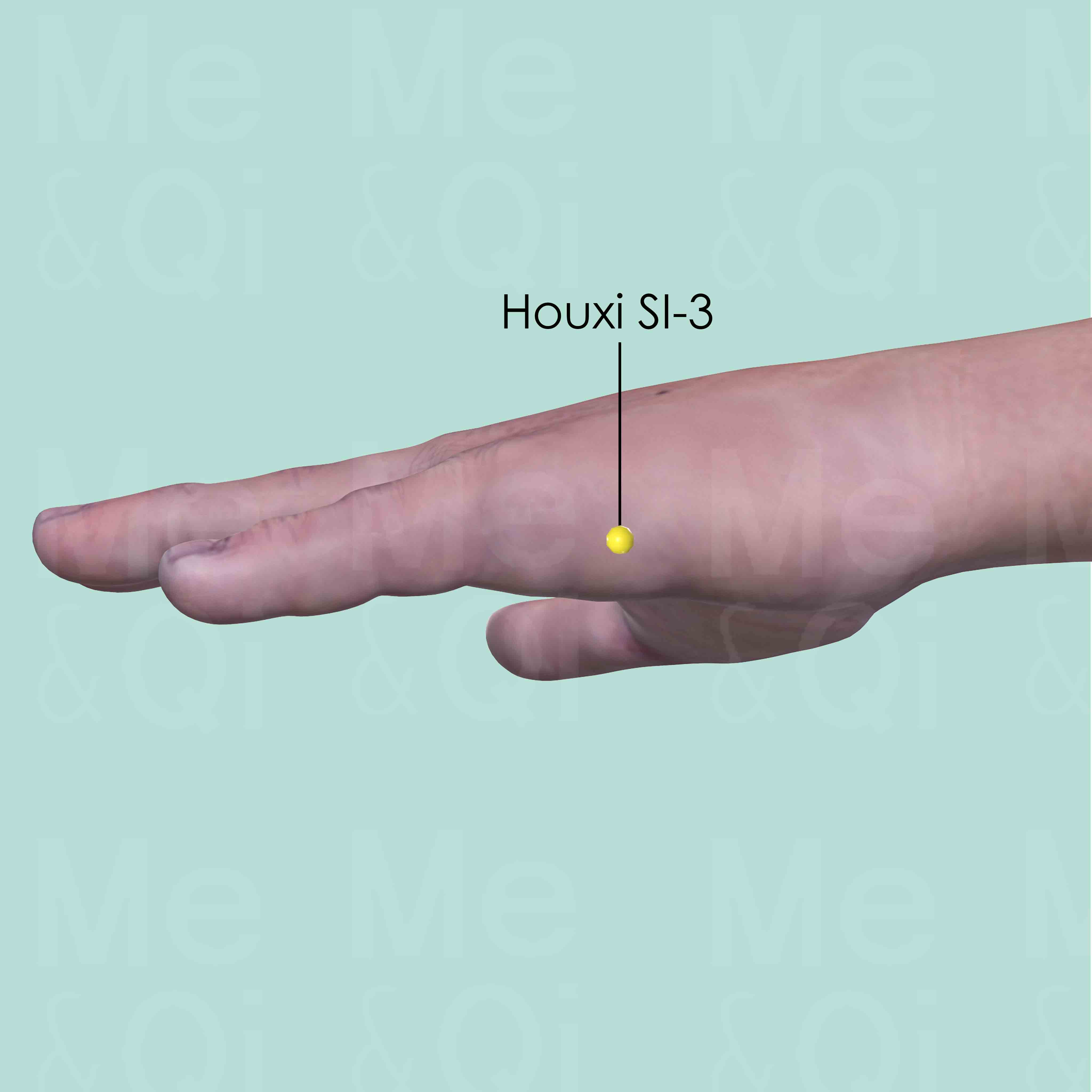
Houxi SI-3
Proximal to the head of the 5th metacarpal bone on the ulnar side, in the depression at the junction of the red and white skin.
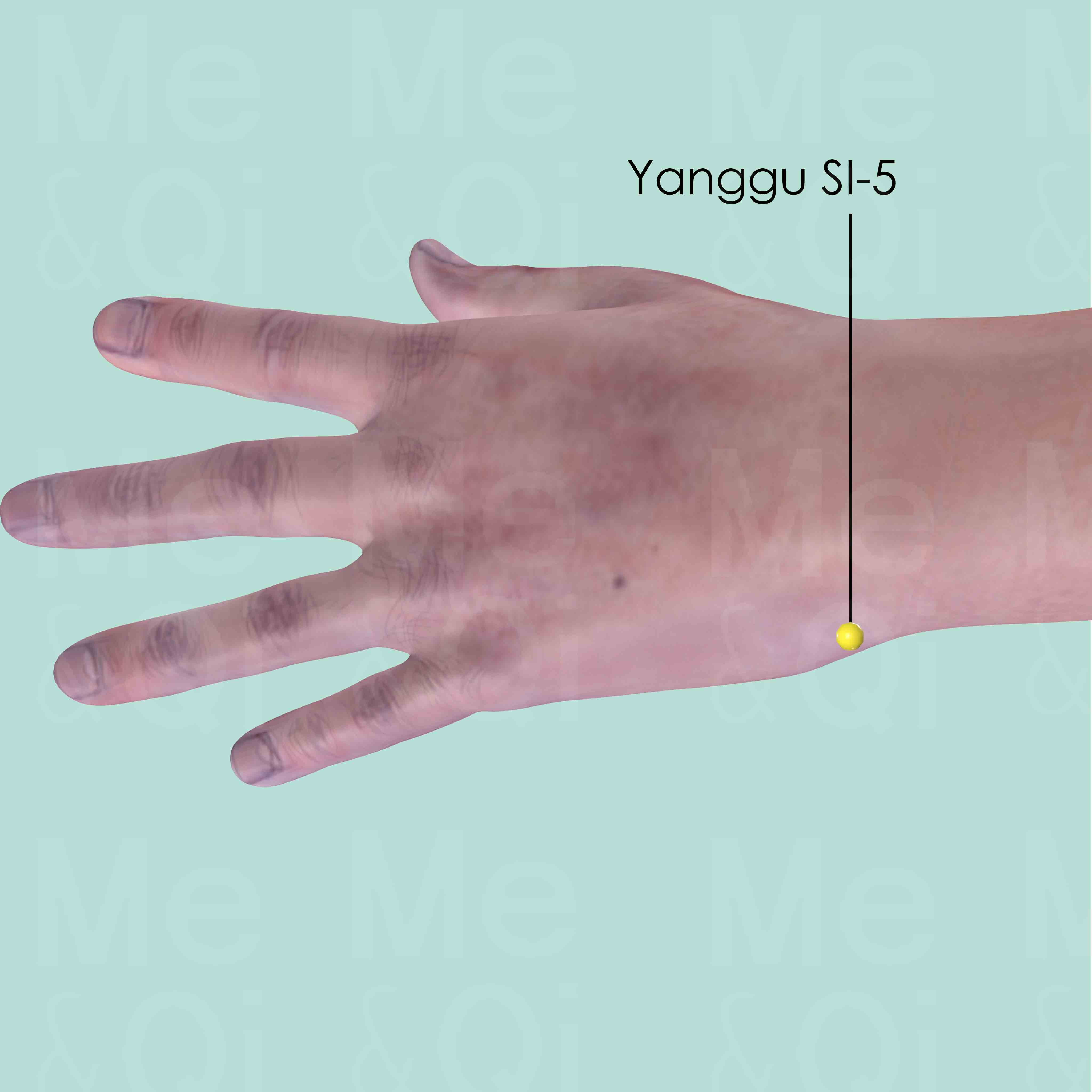
Yanggu SI-5
On the ulnar side of the wrist, in the depression between the styloid process of the ulna and the triquetral bone.
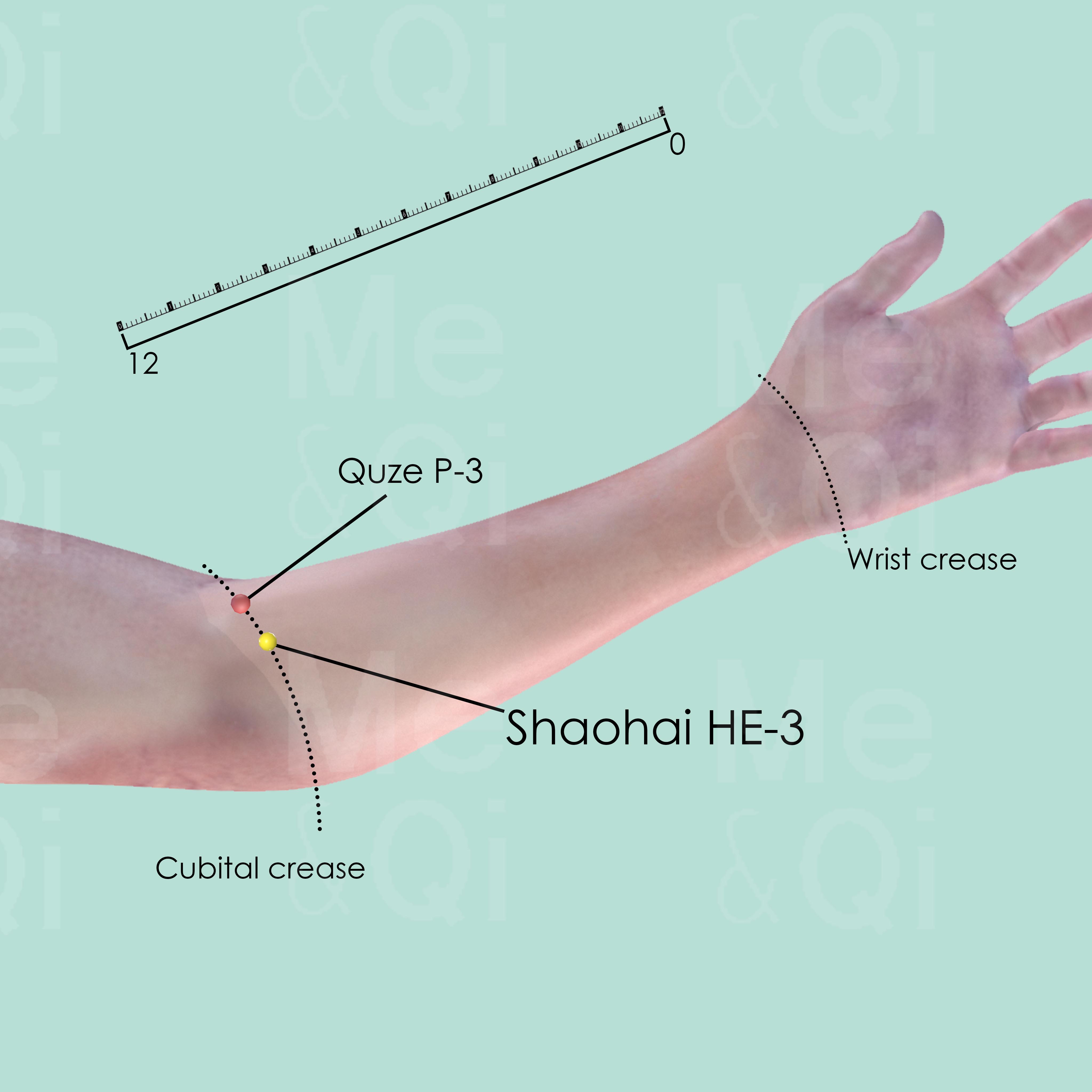
Shaohai HE-3
When the elbow is flexed slightly, Shaohai HE-3 is at the medial end of the transverse cubital crease, in the depression radius to the medial epicondyle of the humerus.
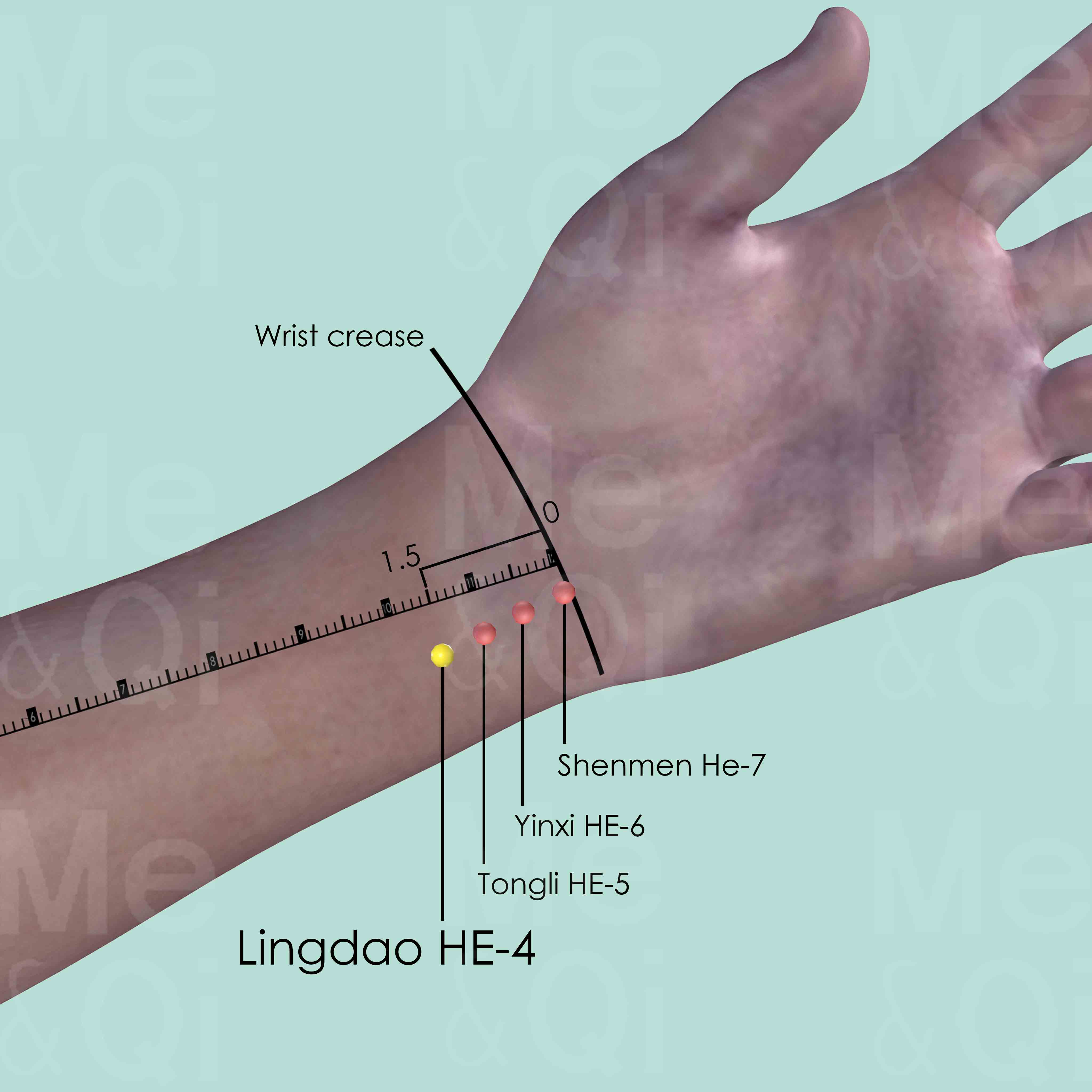
Lingdao HE-4
On the radial side of the tendon of flexor carpi ulnaris, 1.5 cun above the transverse crease of the wrist when the palm faces upward.
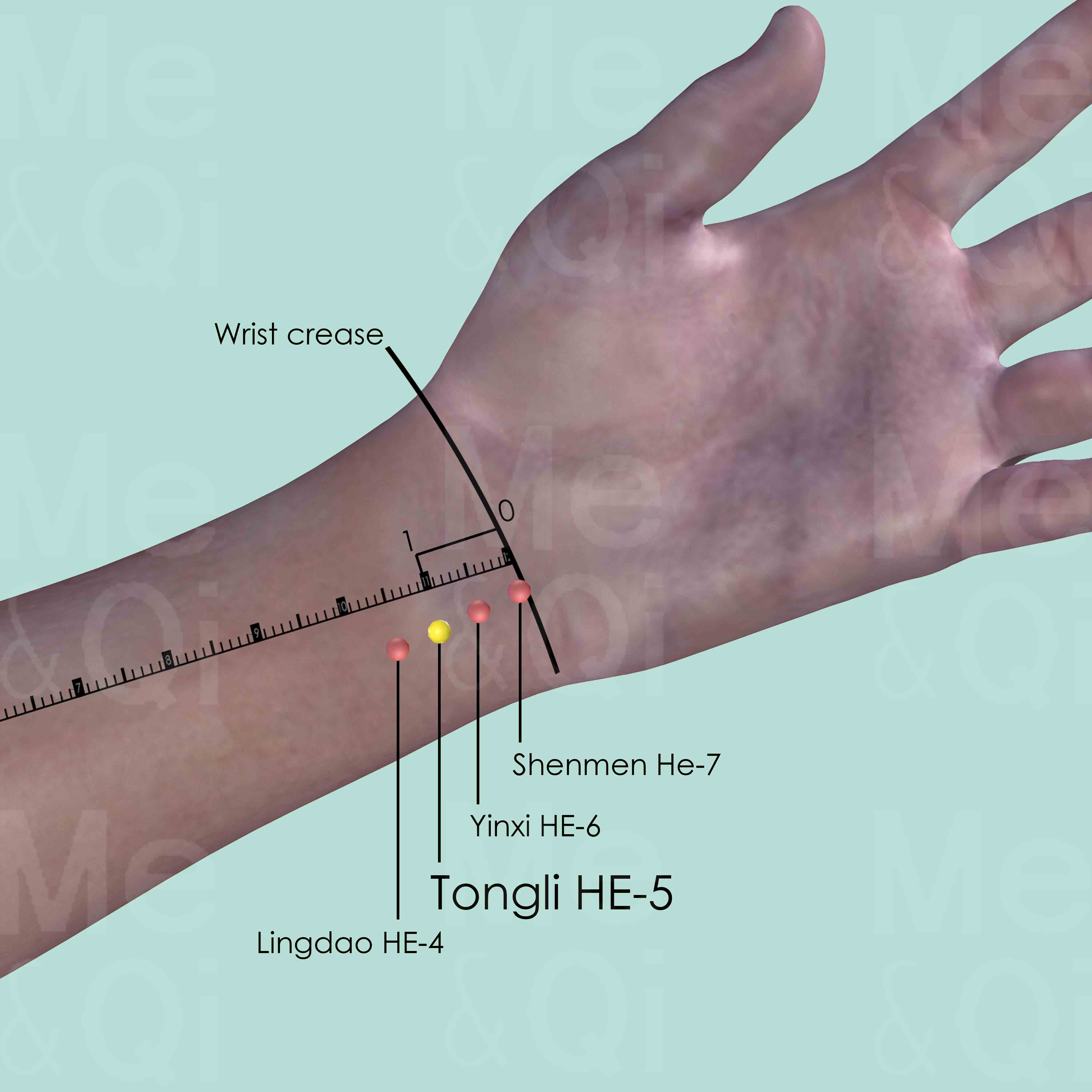
Tongli HE-5
On the radial side of the tendon of flexor carpi ulnaris muscle, 1 cun above the transverse crease of the wrist when the palm faces upward.
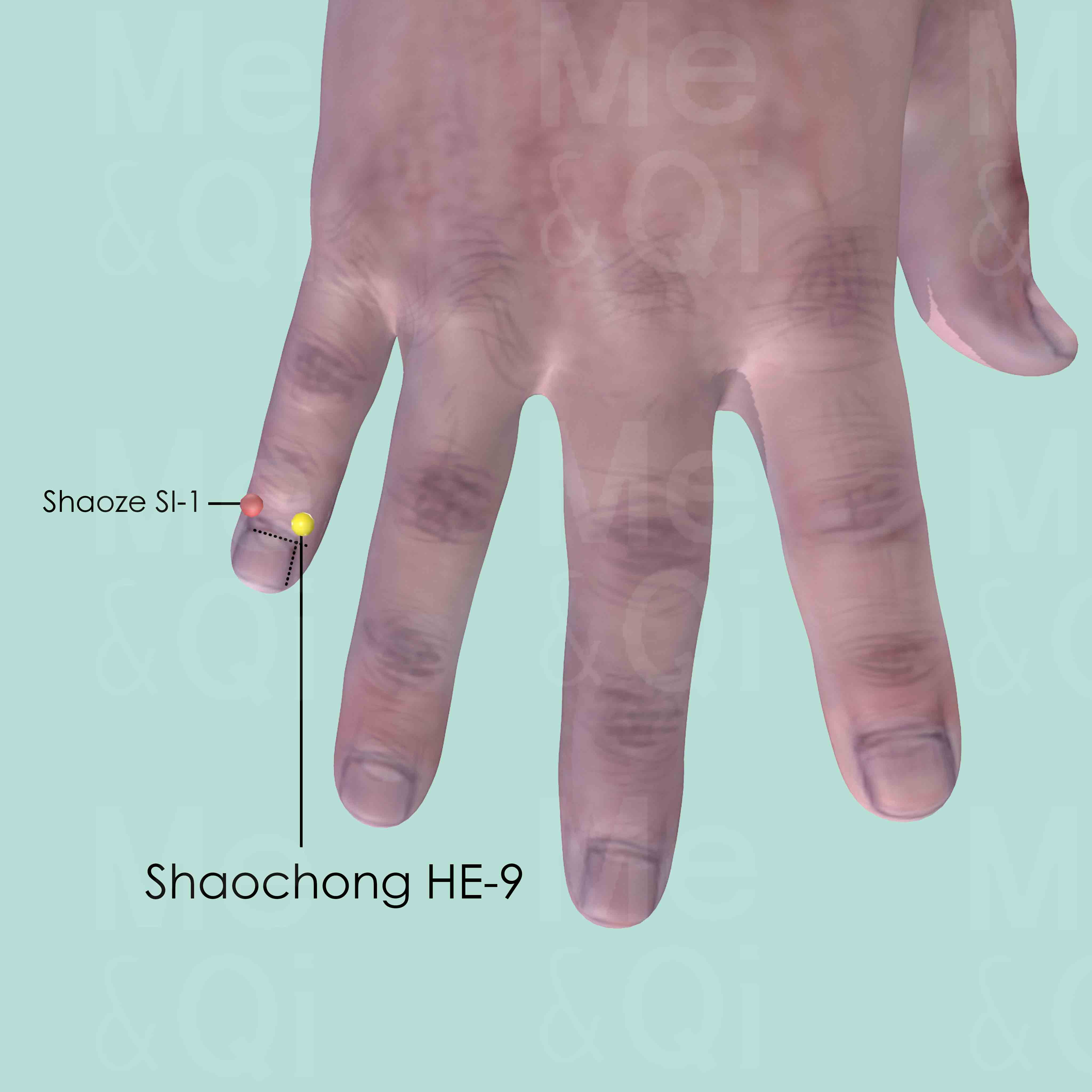
Shaochong HE-9
On the radial side of the little finger, about 0.1 cun posterior to the corner of the nail.
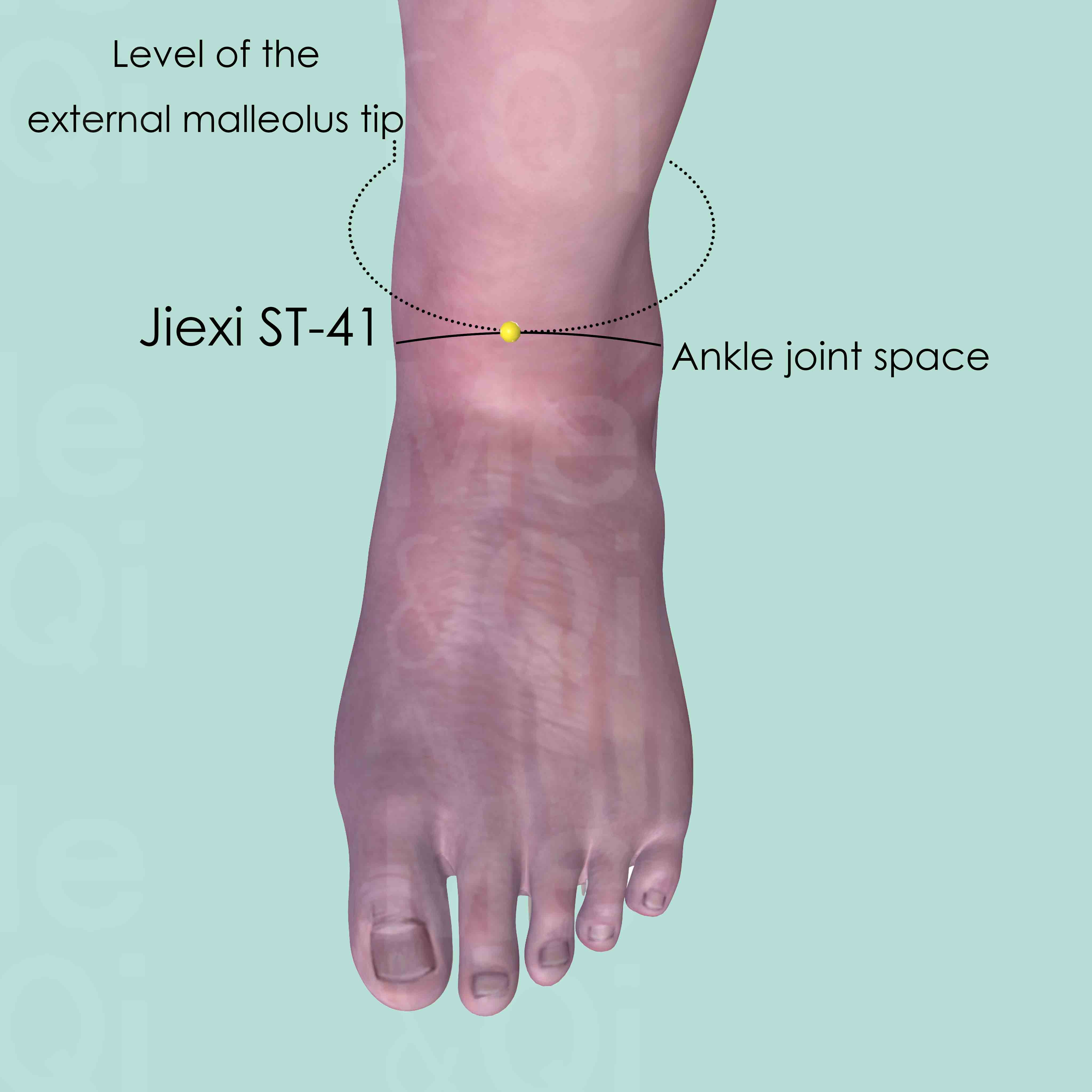
Jiexi ST-41
At the junction of the dorsum of the foot and leg, between the tendons of extensor digitorum and the extensor hallucis longus muscle. Approximately at the level of the tip of the external malleolus.
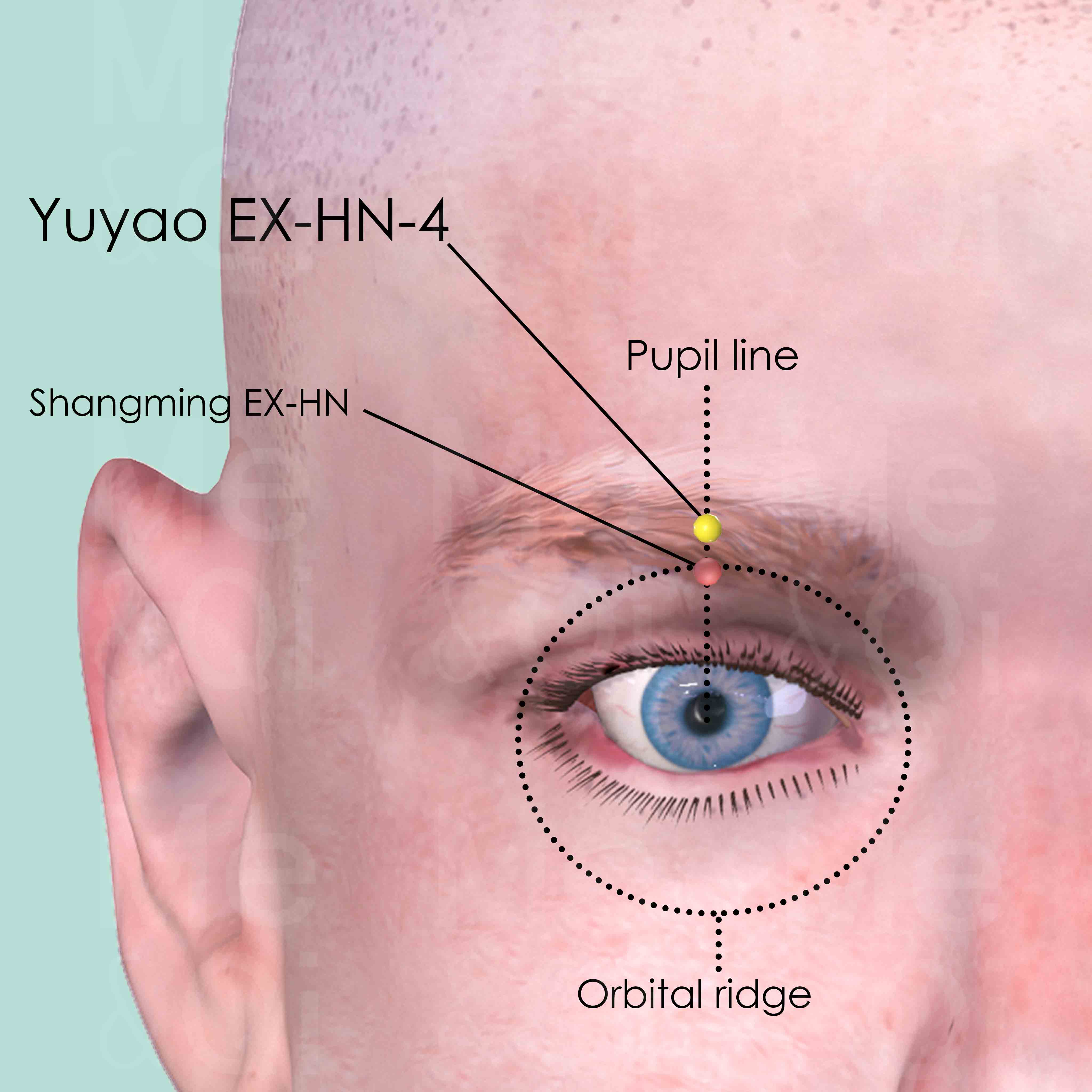
Yuyao EX-HN-4
When the patient looks straight forward, Yuyao EX-HN-4 is located directly above the pupil, in the midline of the eyebrow.
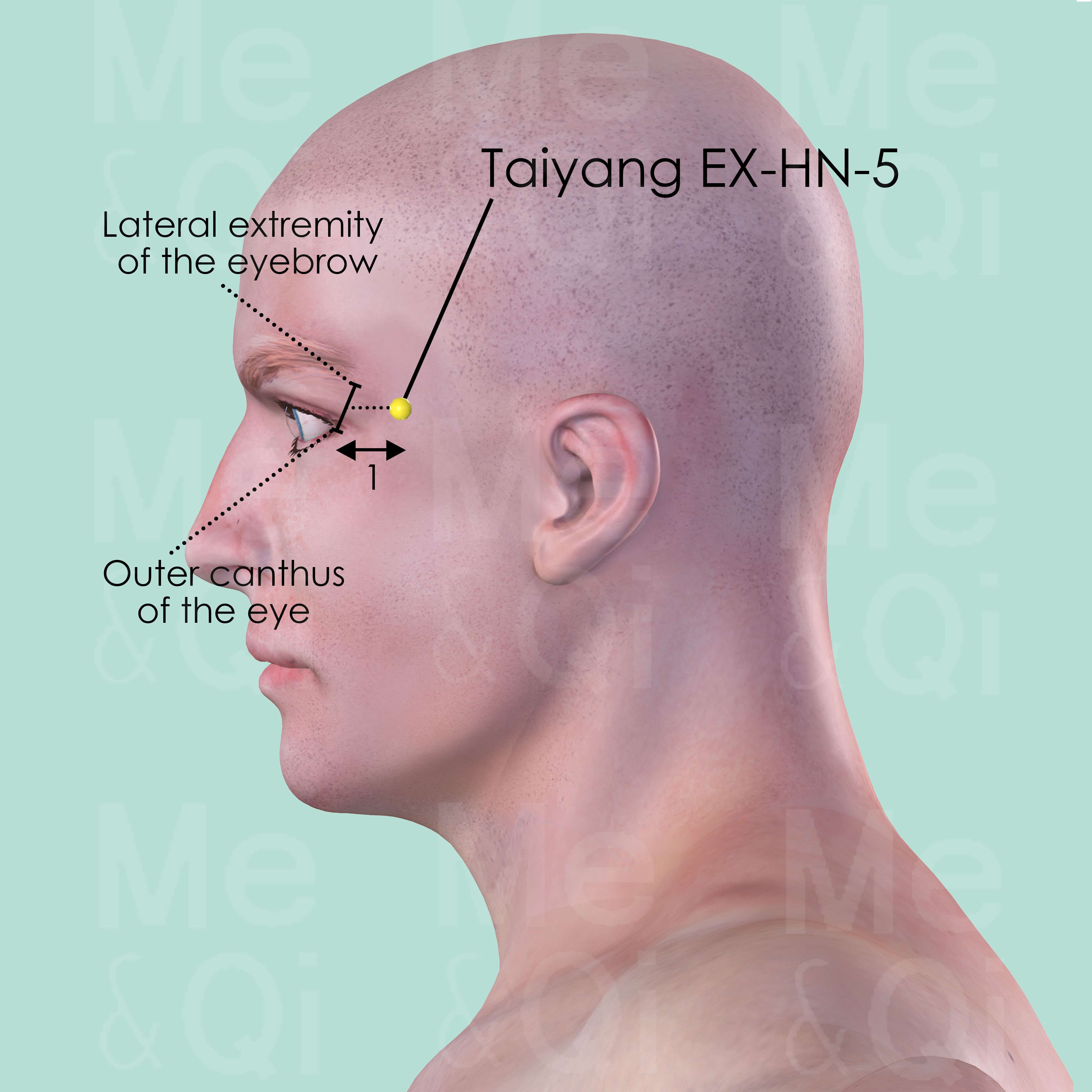
Taiyang EX-HN-5
At the temple, in the tender depression approximately 1 cun posterior to the midpoint between the lateral extremity of the eyebrow and the outer canthus of the eye.
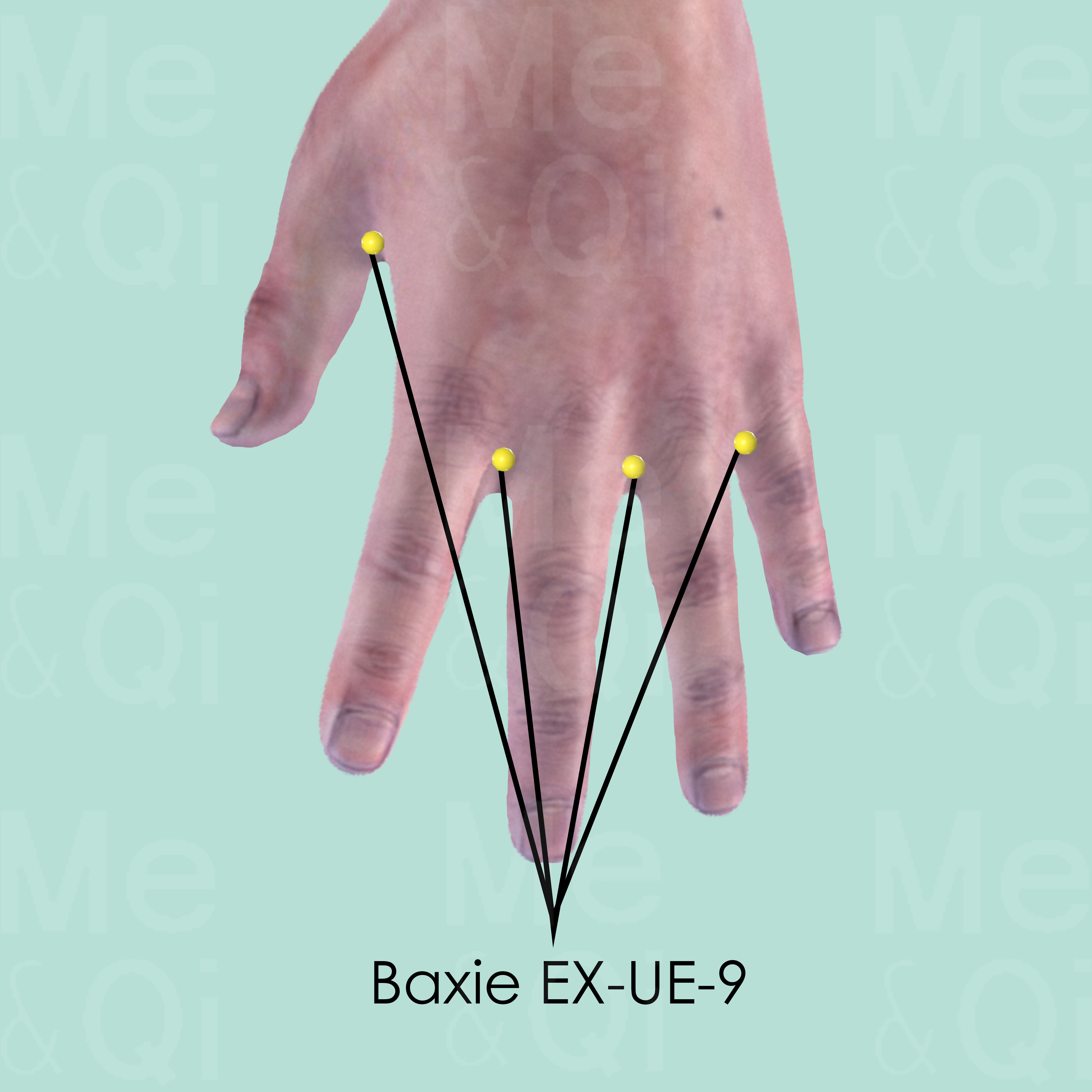
Baxie EX-UE-9
This is a group of 8 points in both hand, 4 points per each hand. Slightly proximal to the margins of the webs between the fingers, on the border of the red and white skin.
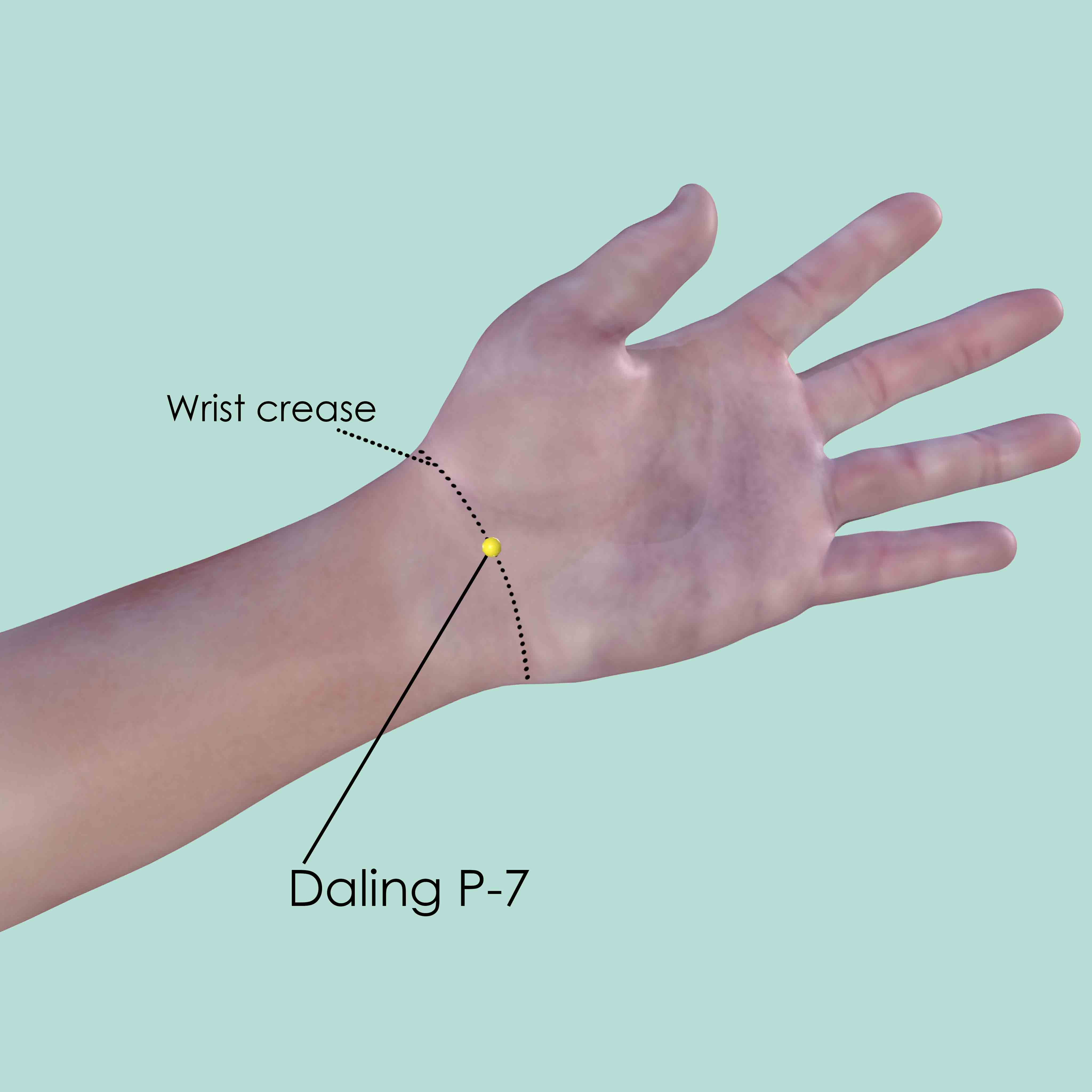
Daling P-7
In the depression in the middle of the transverse crease of the wrist, between the tendons of palmaris longus and flexor carpi radialis muscle.
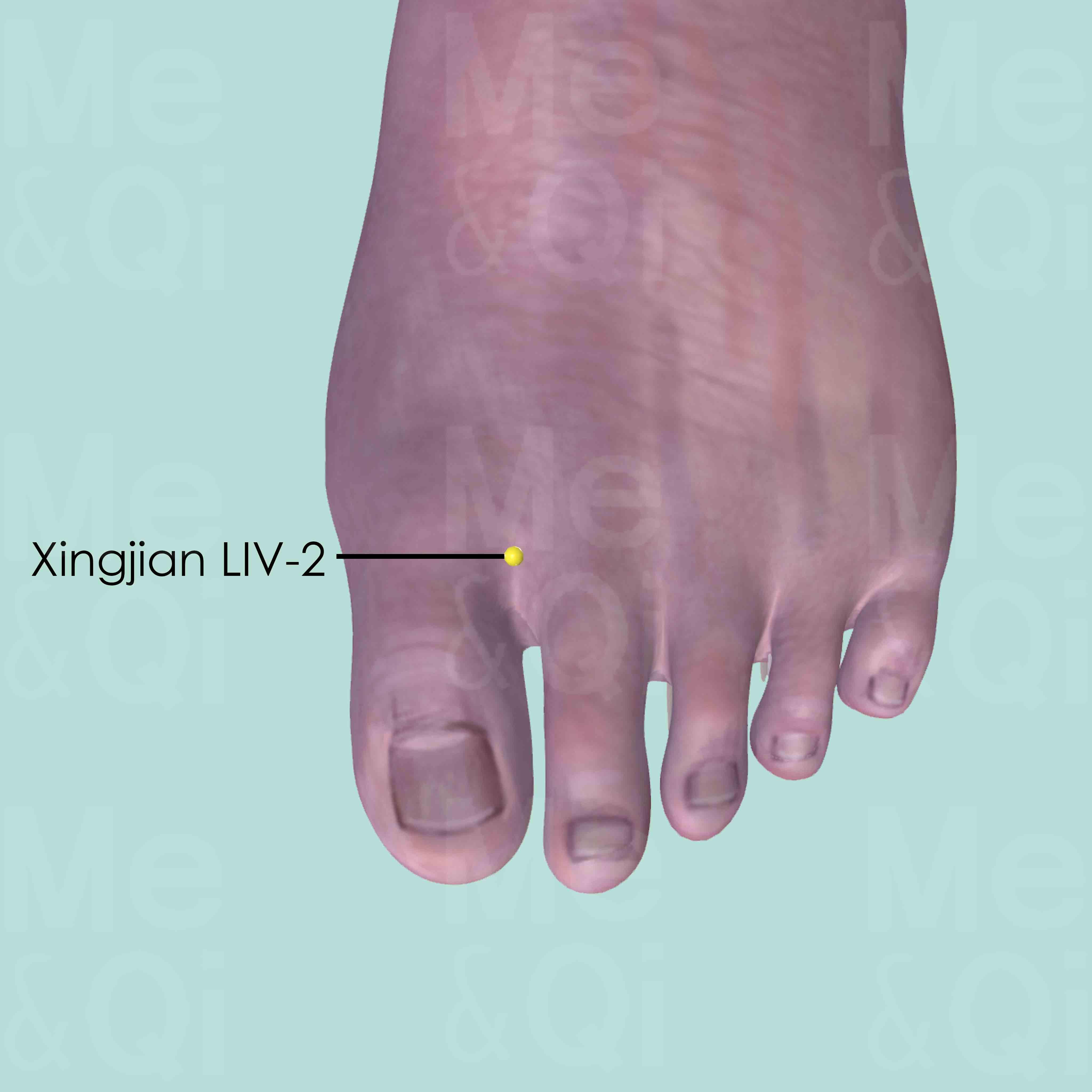
Xingjian LIV-2
Between the first and second toe, on the dorsum of the foot, 0.5 cun proximal to the interdigital fold.

